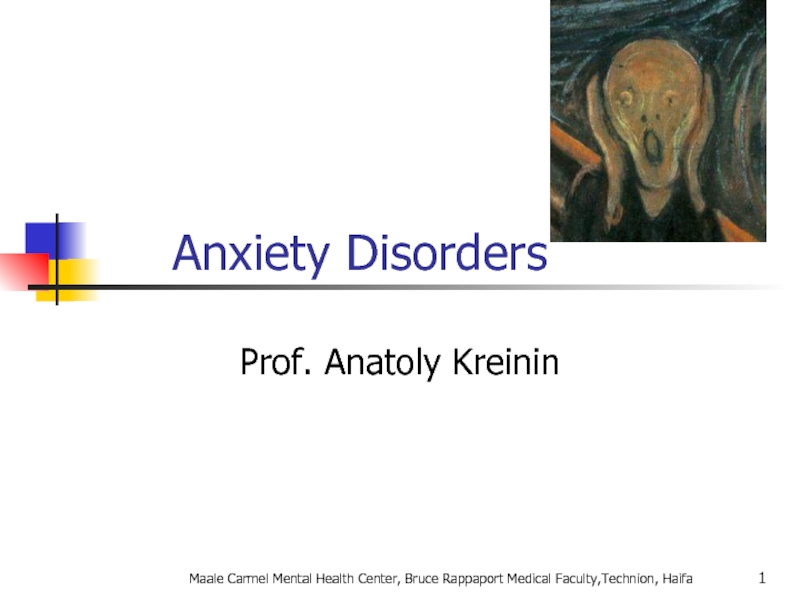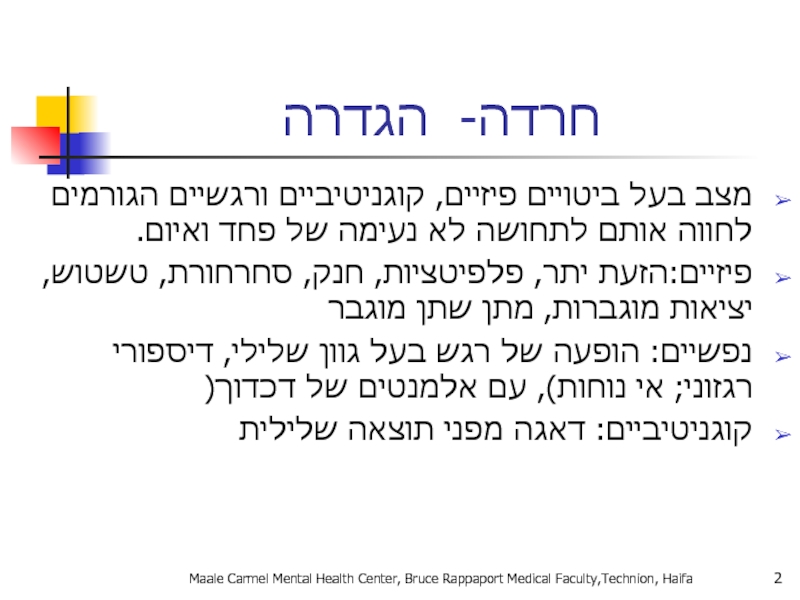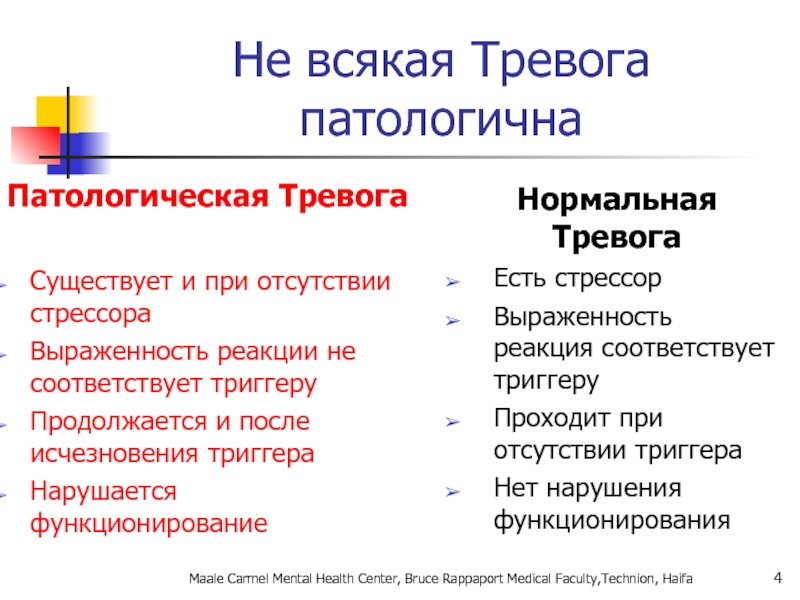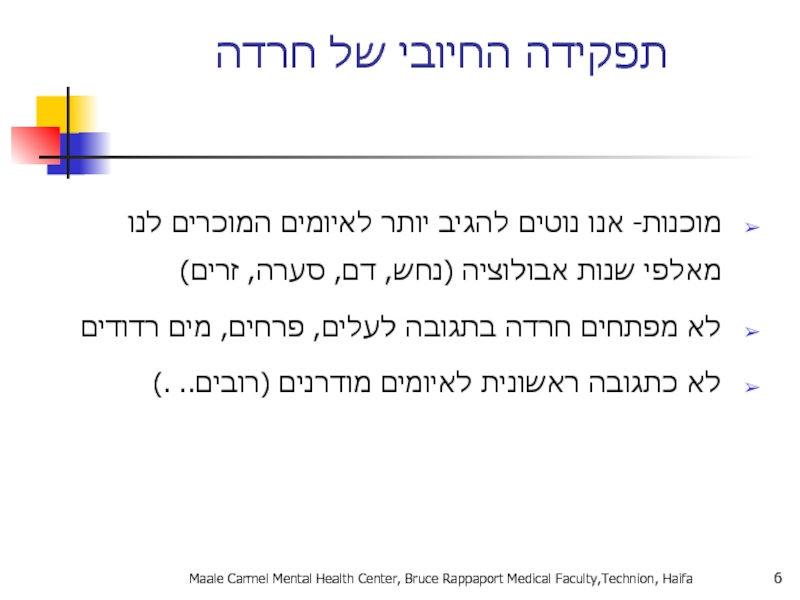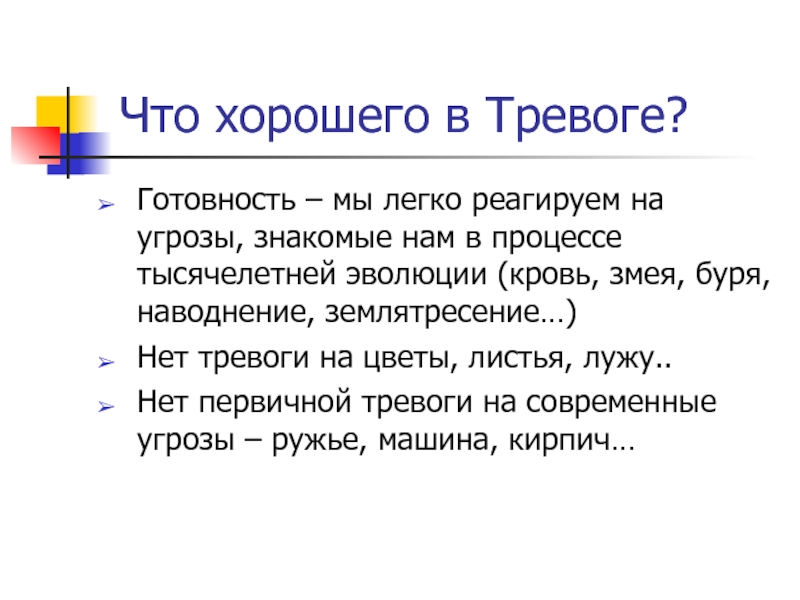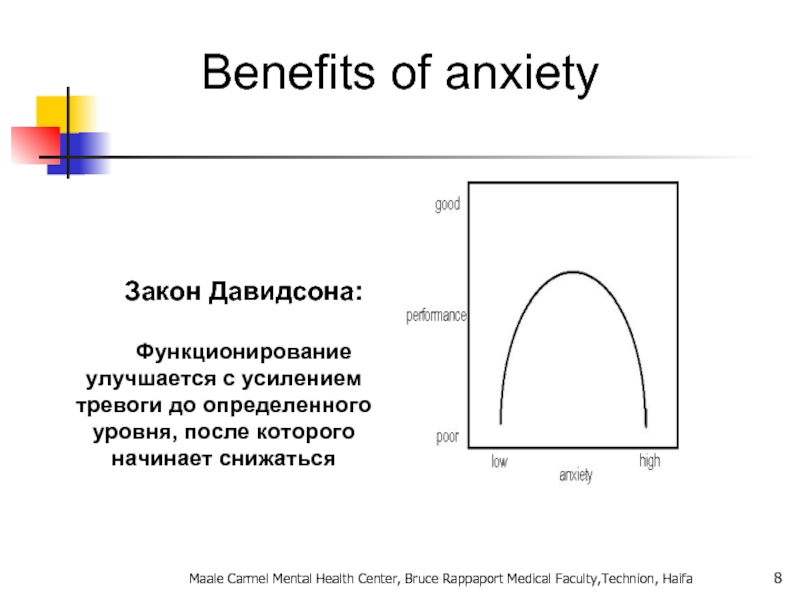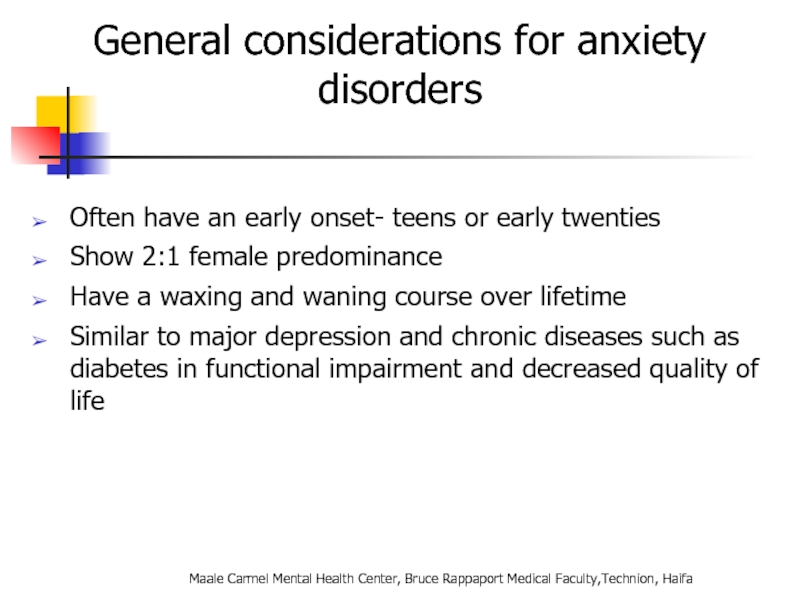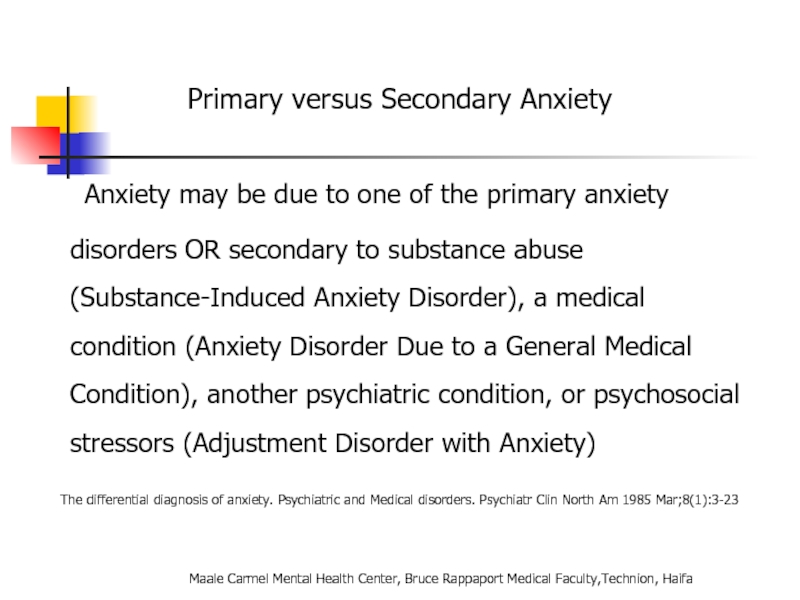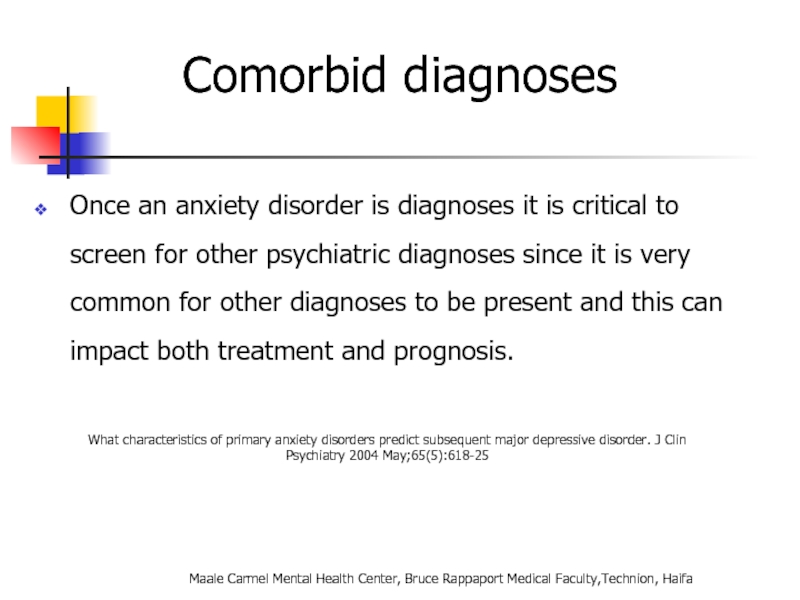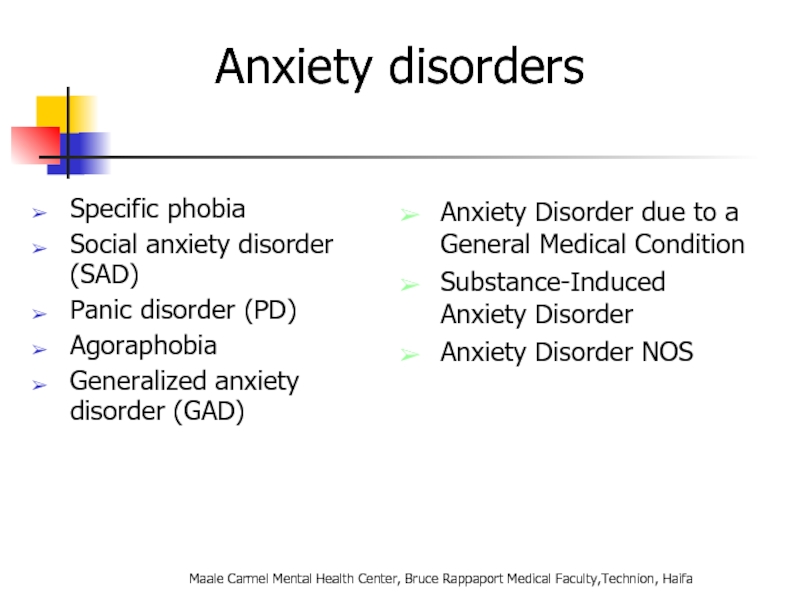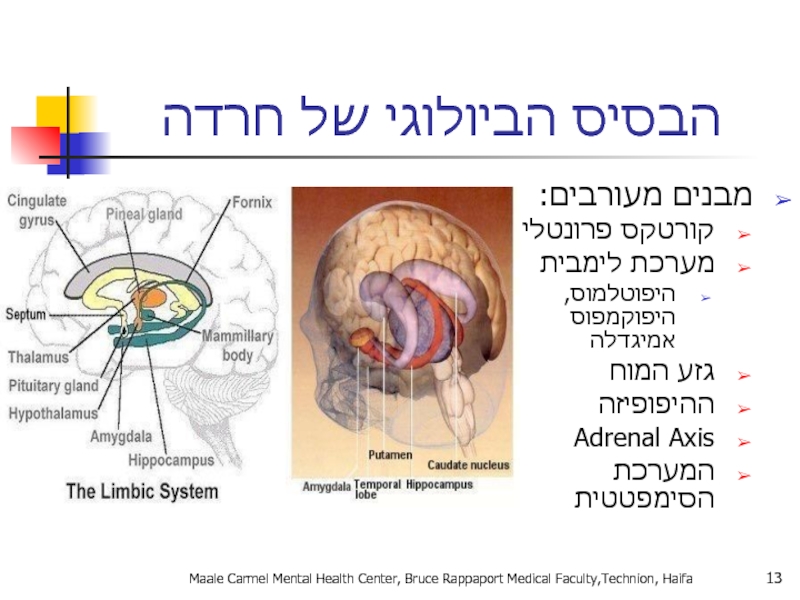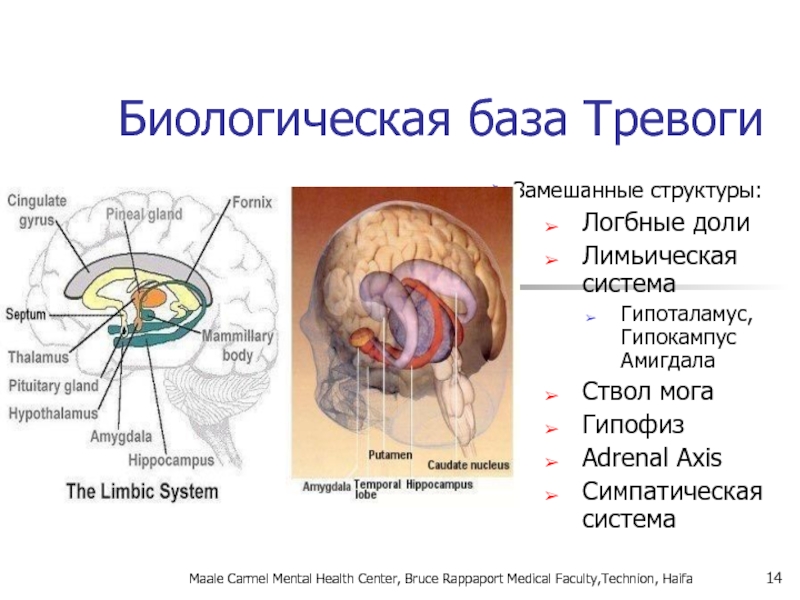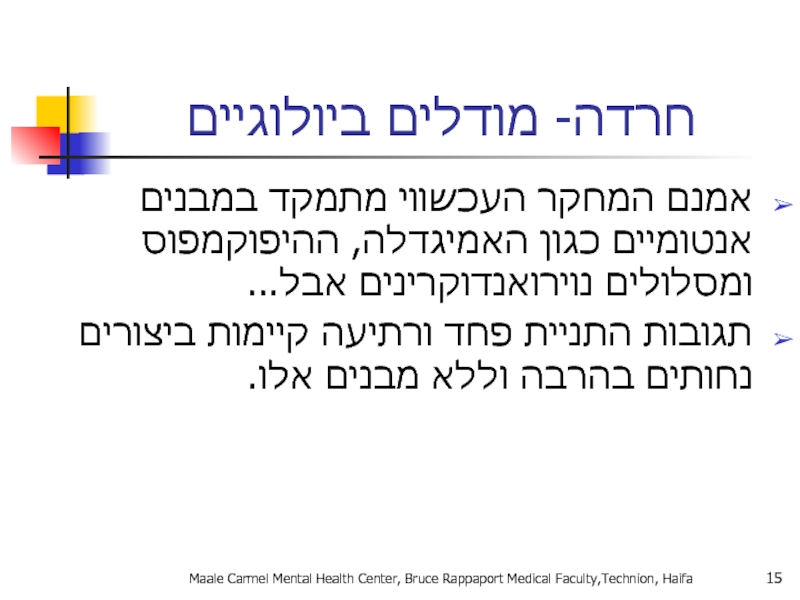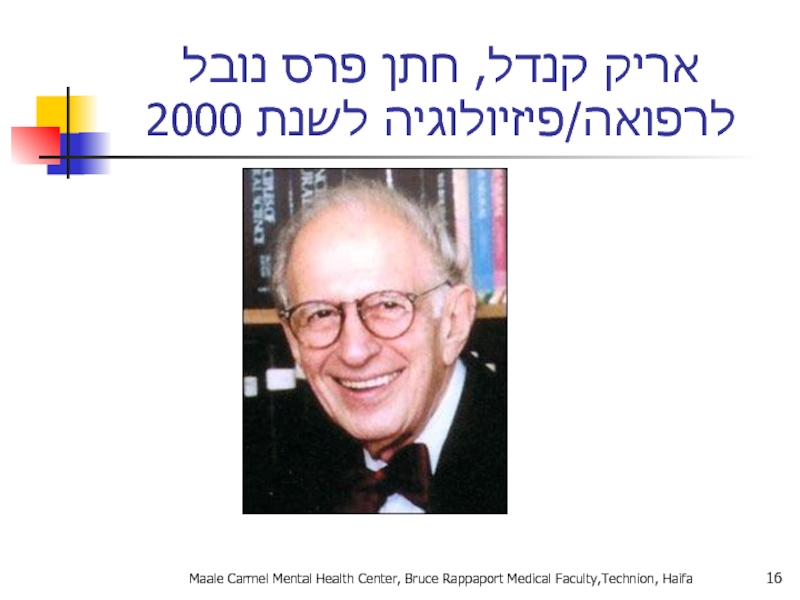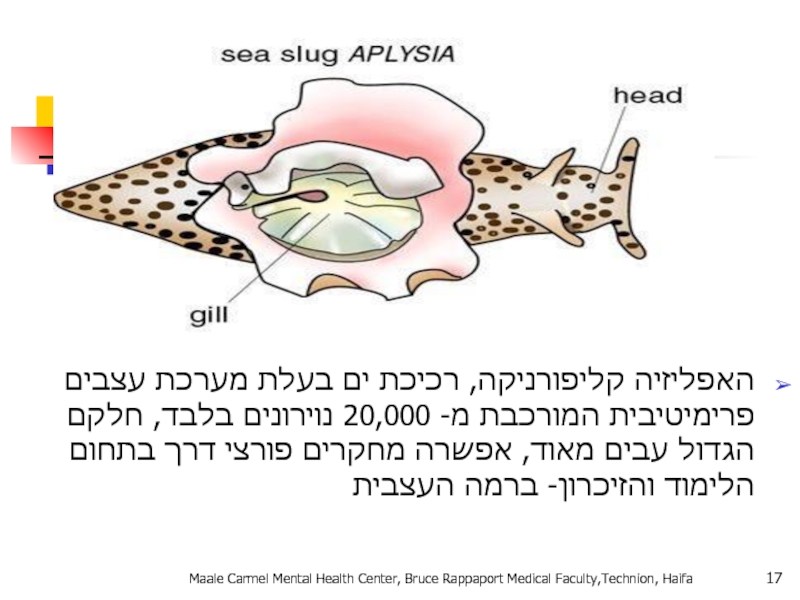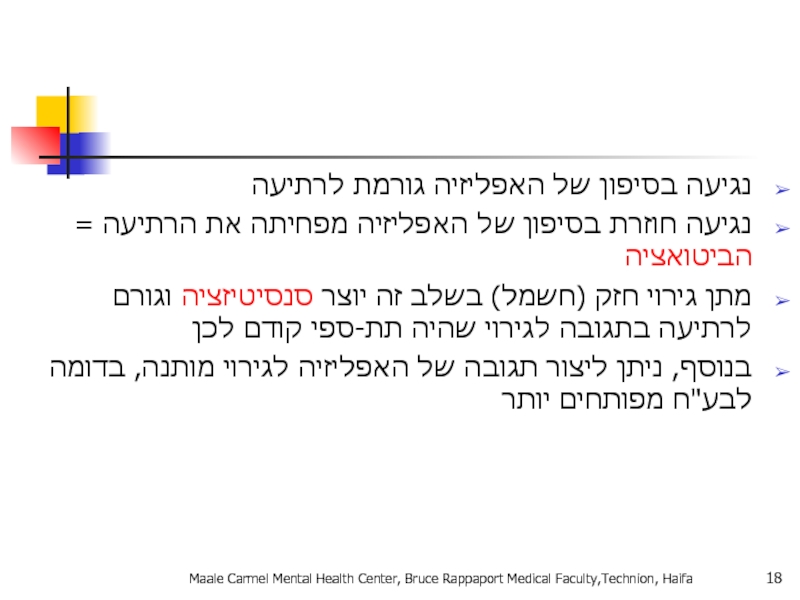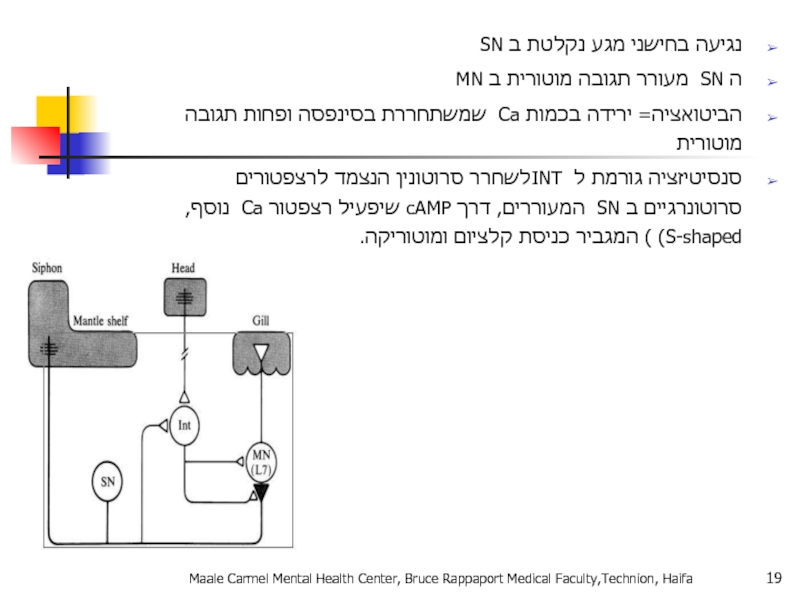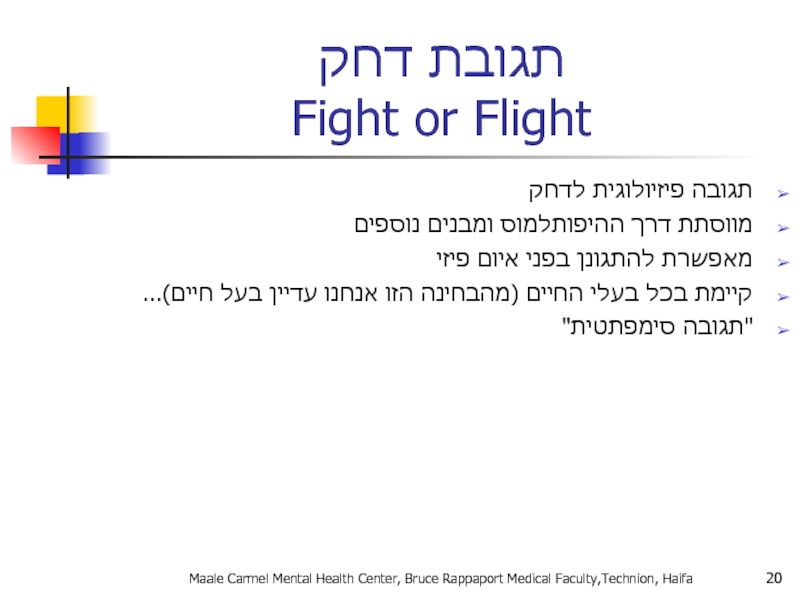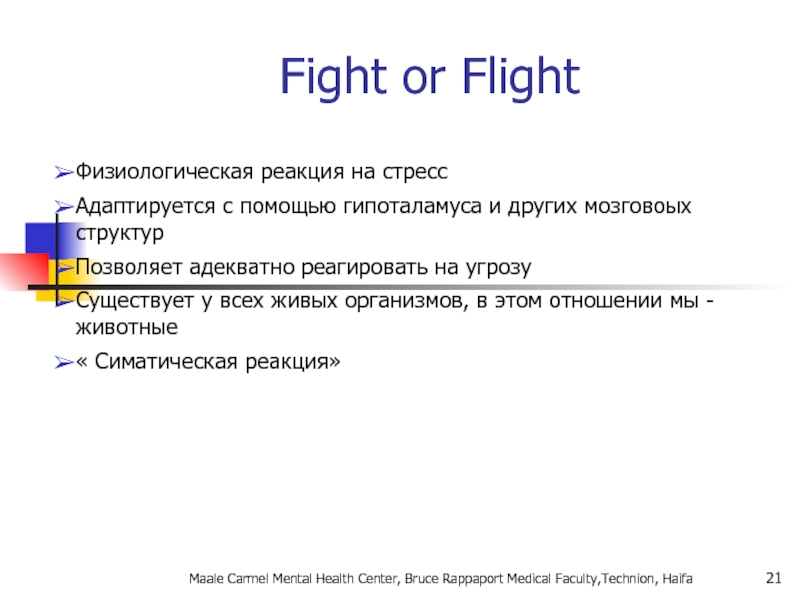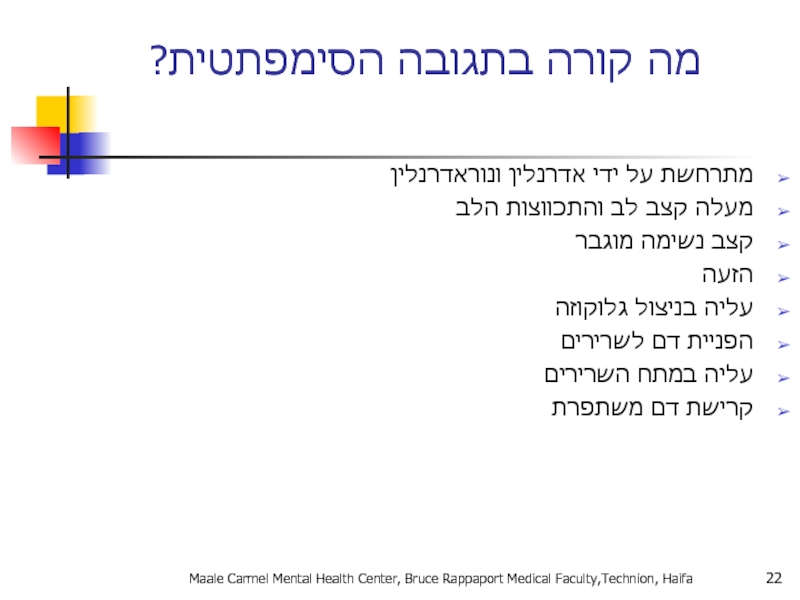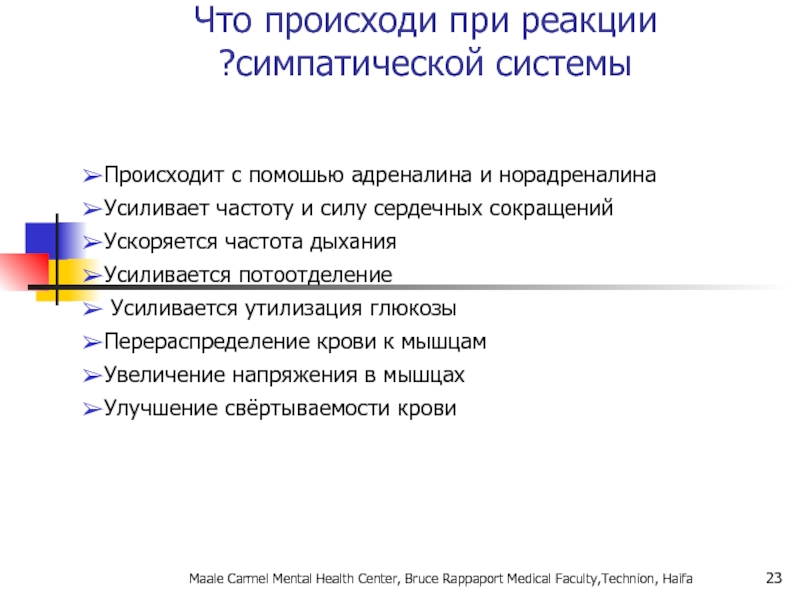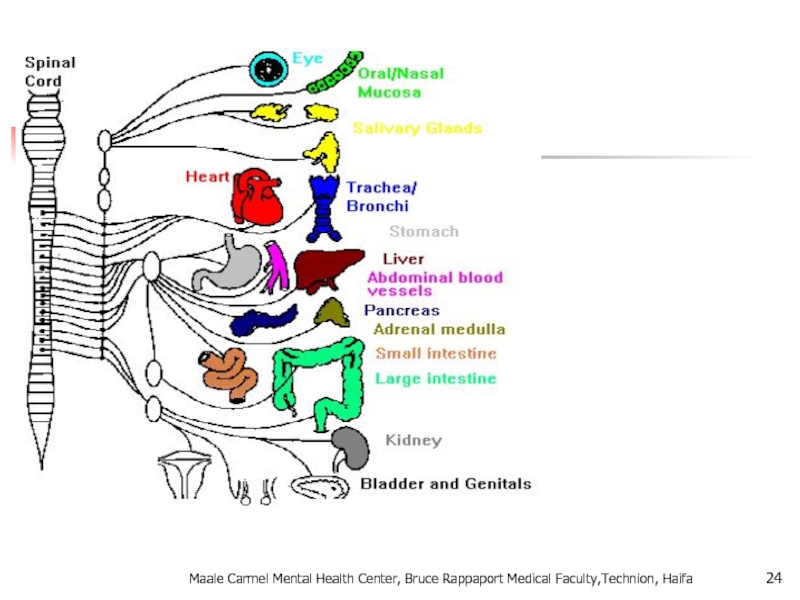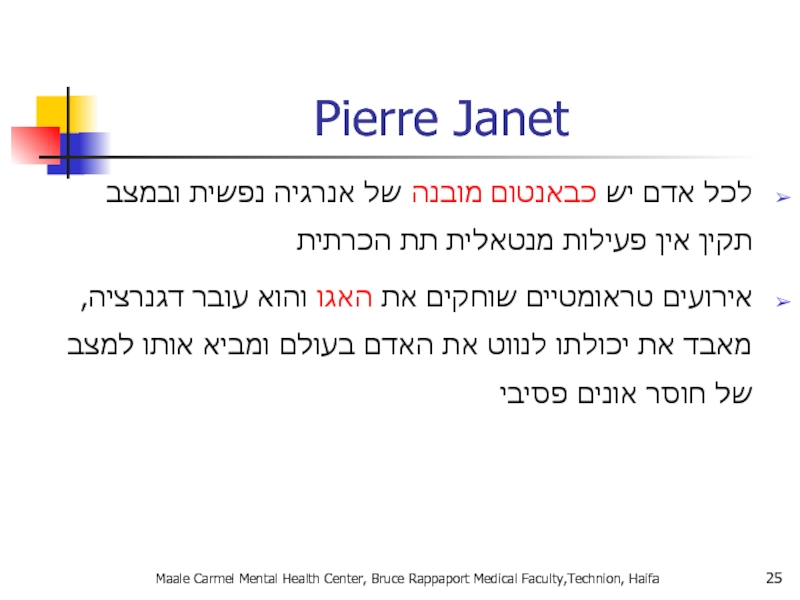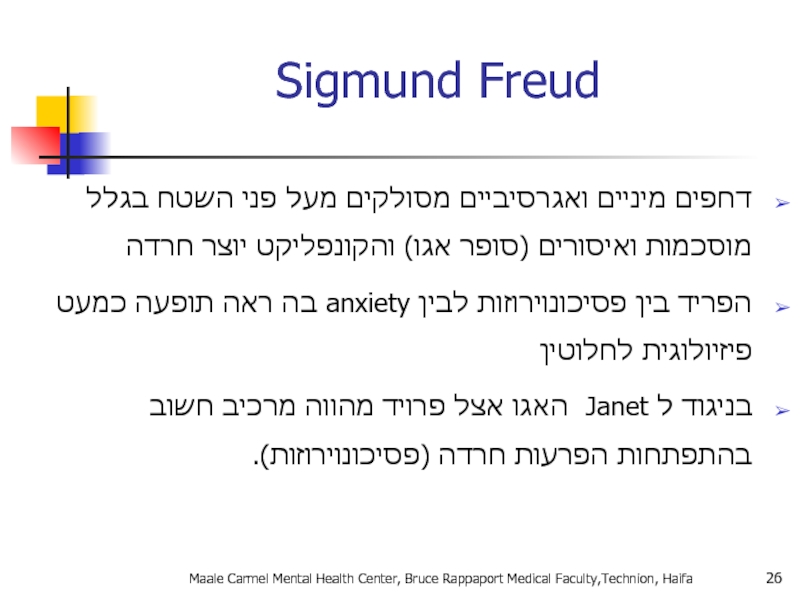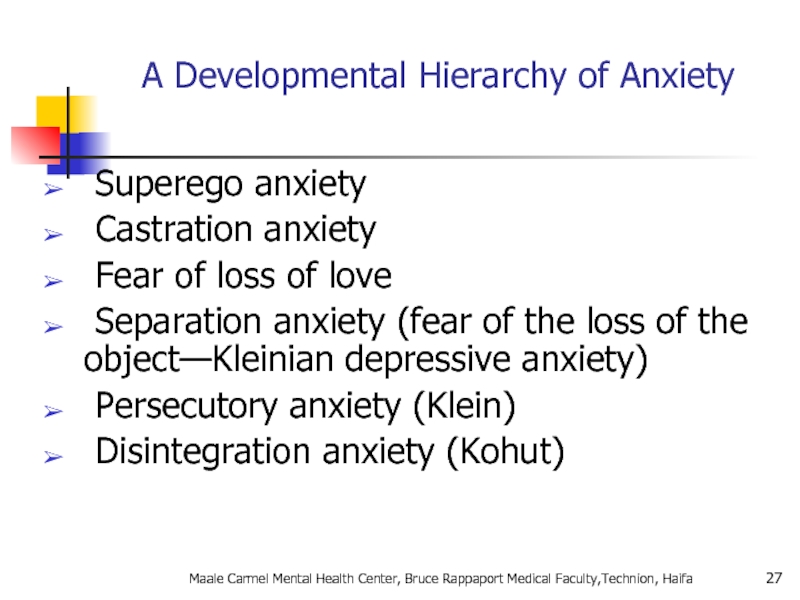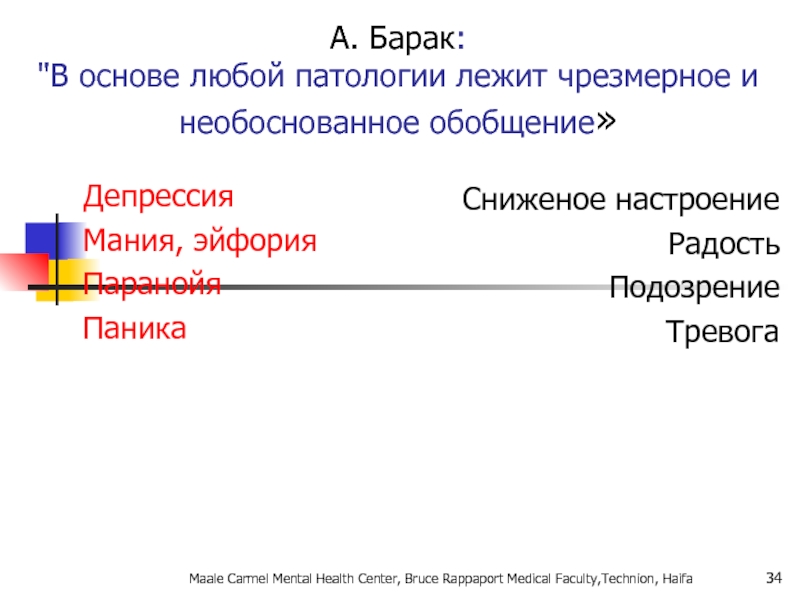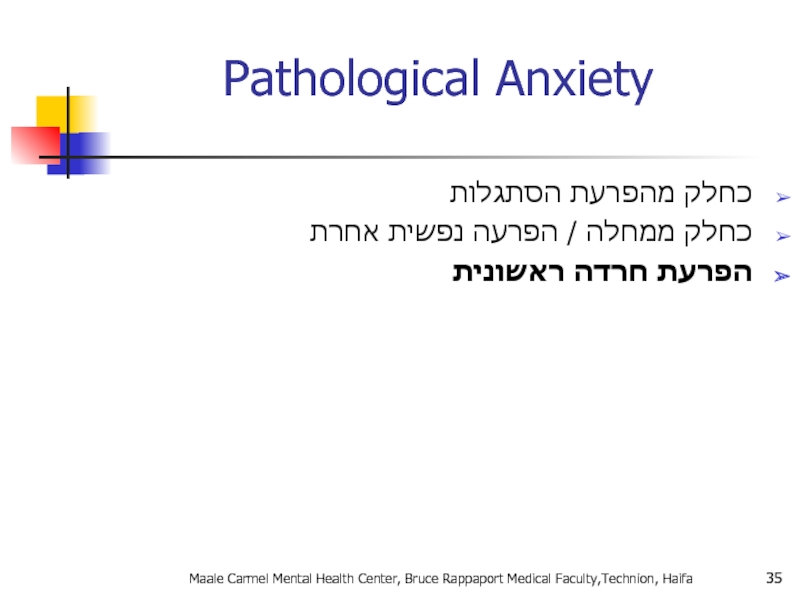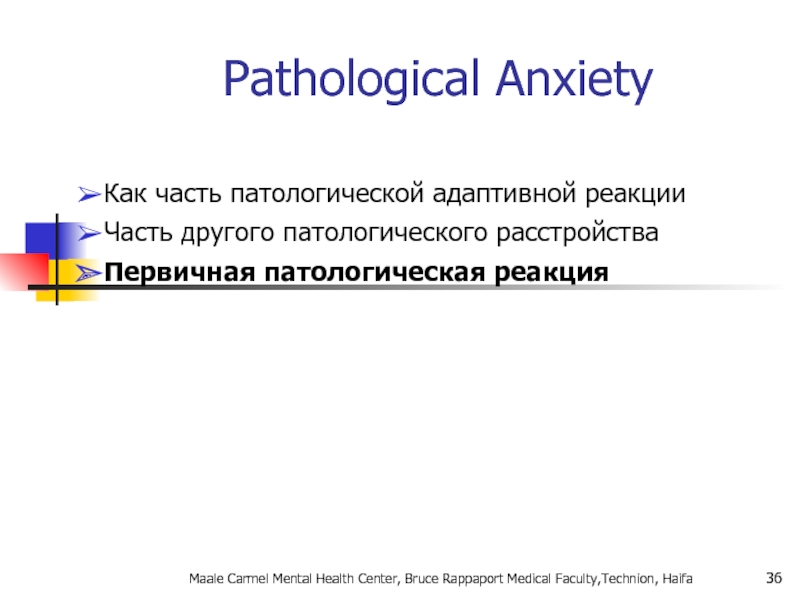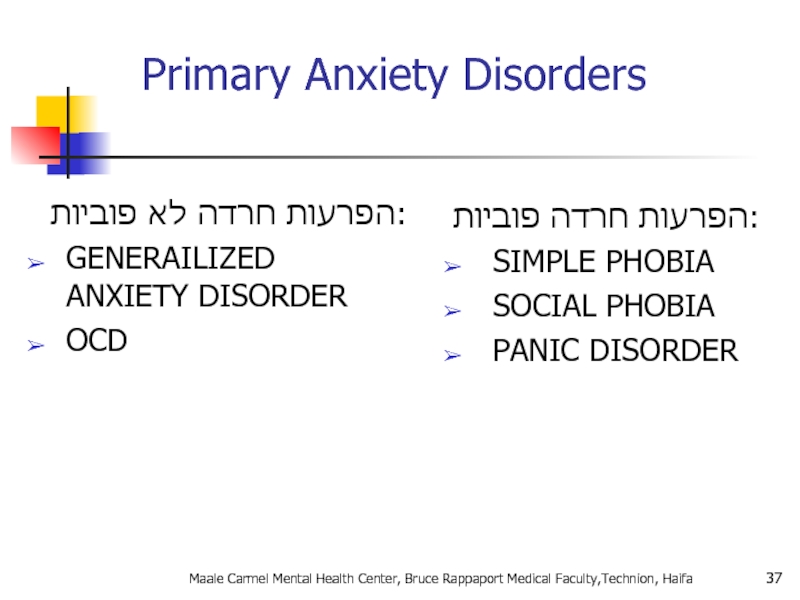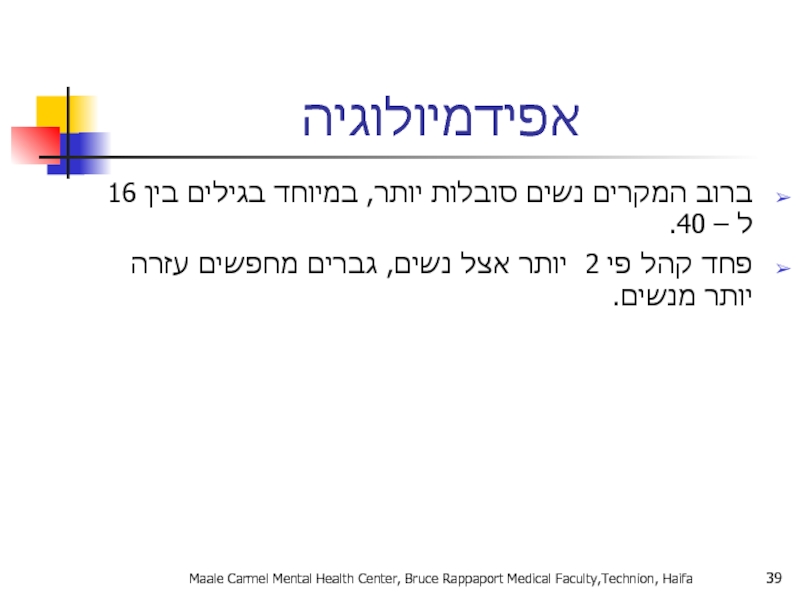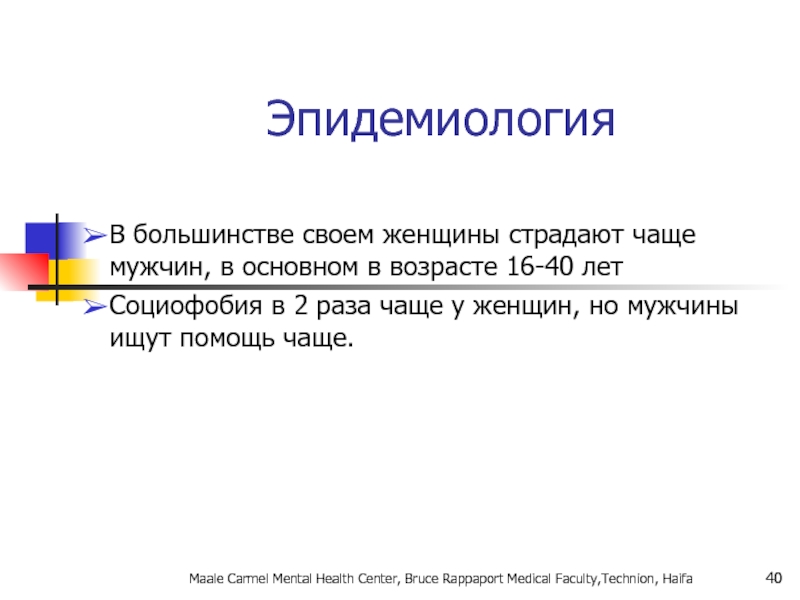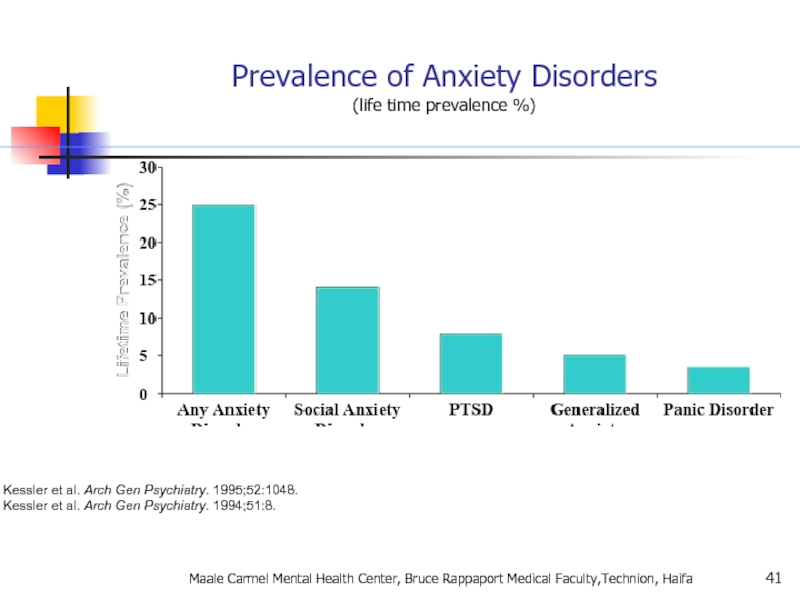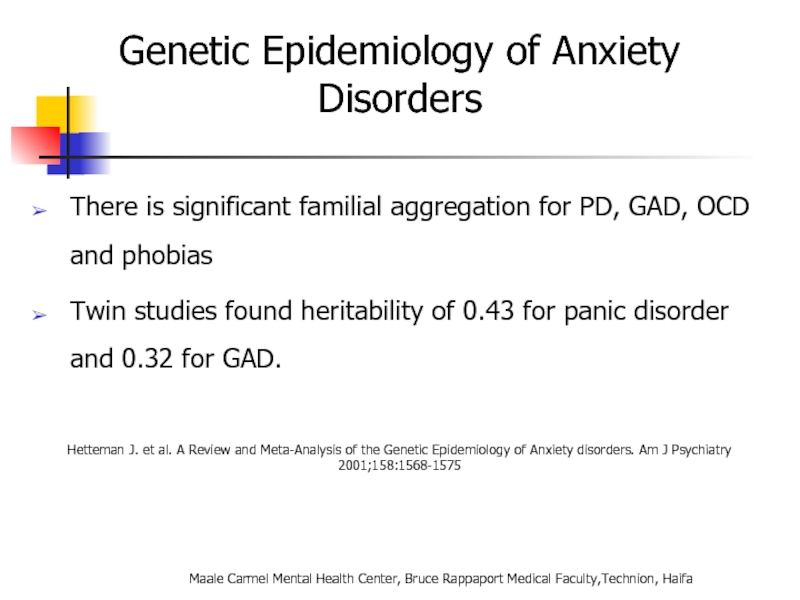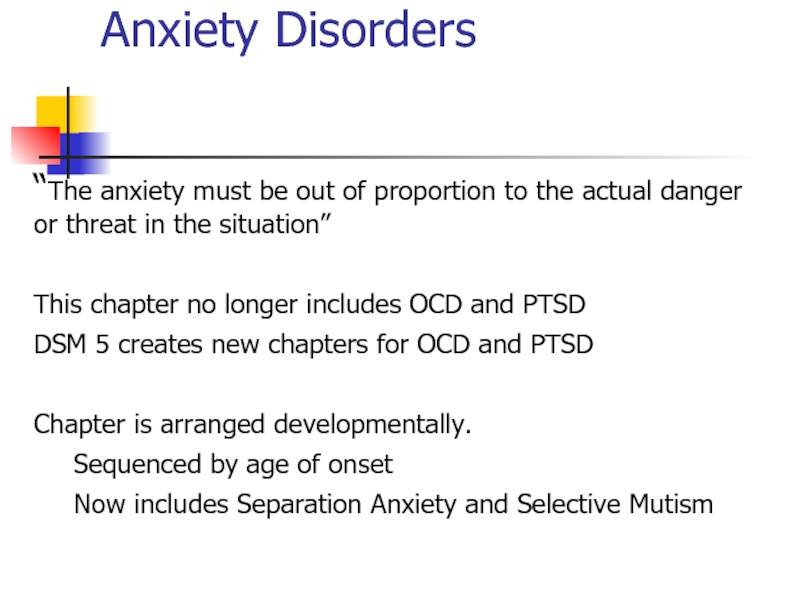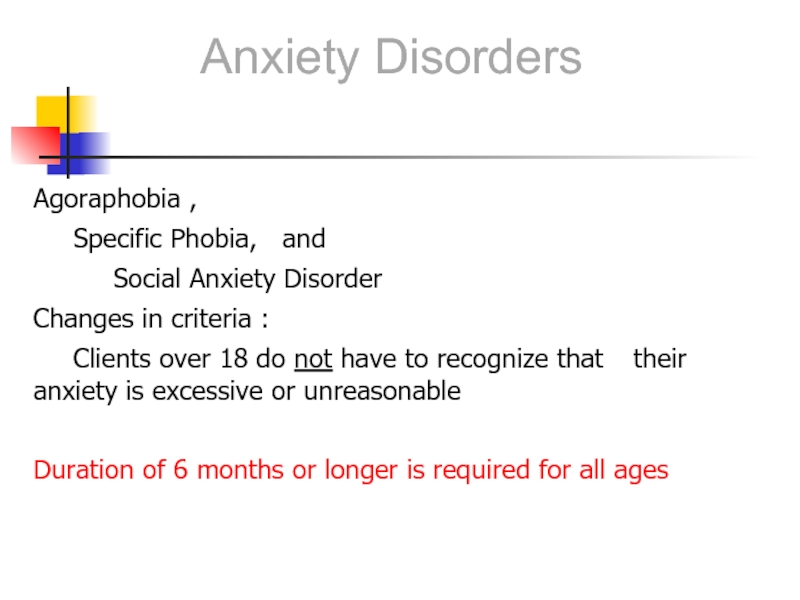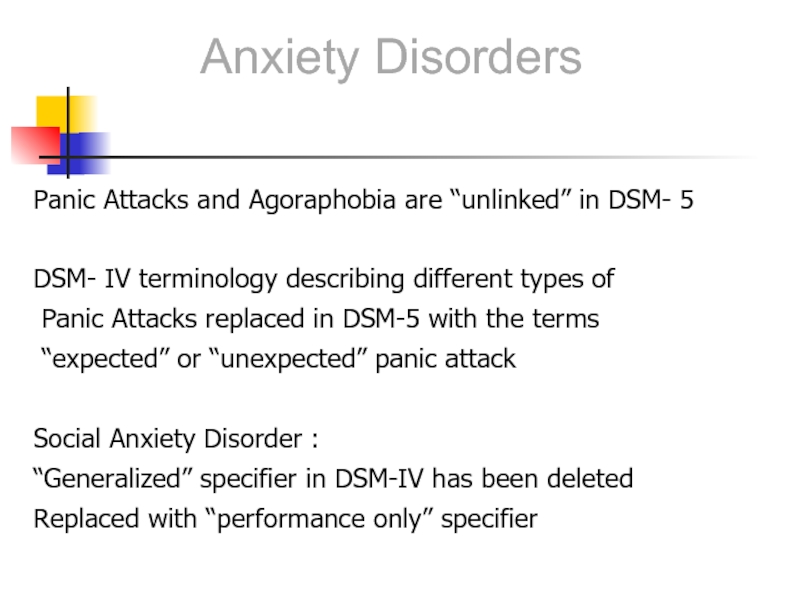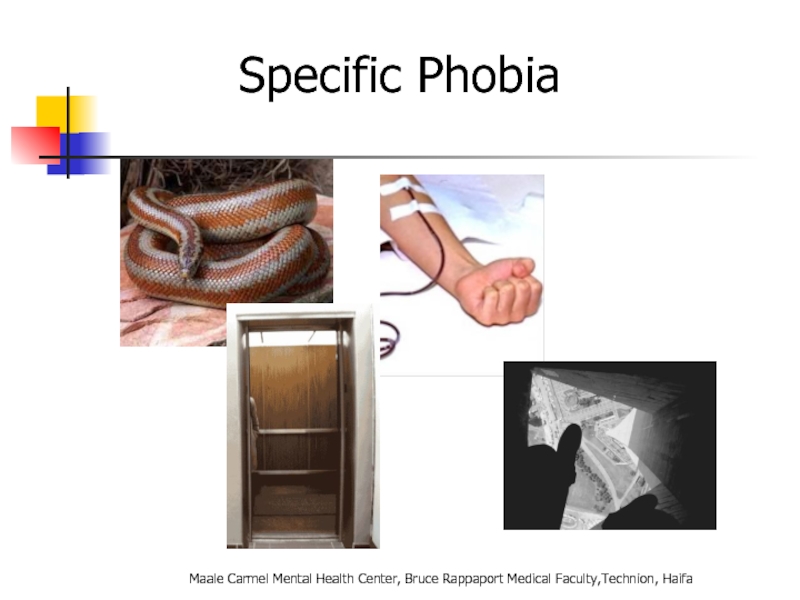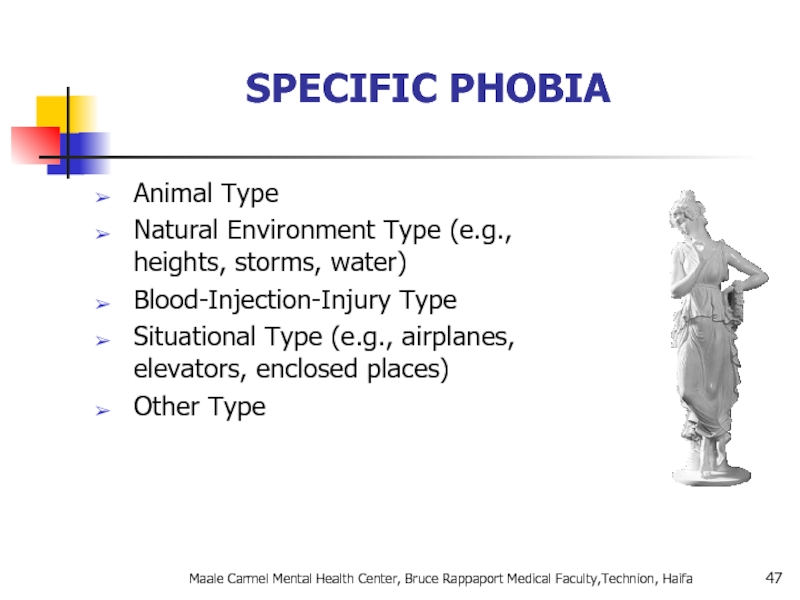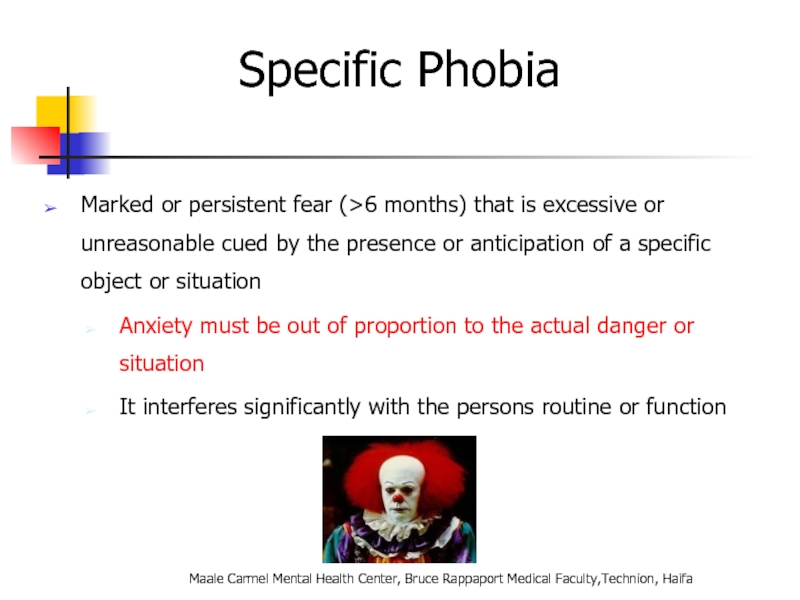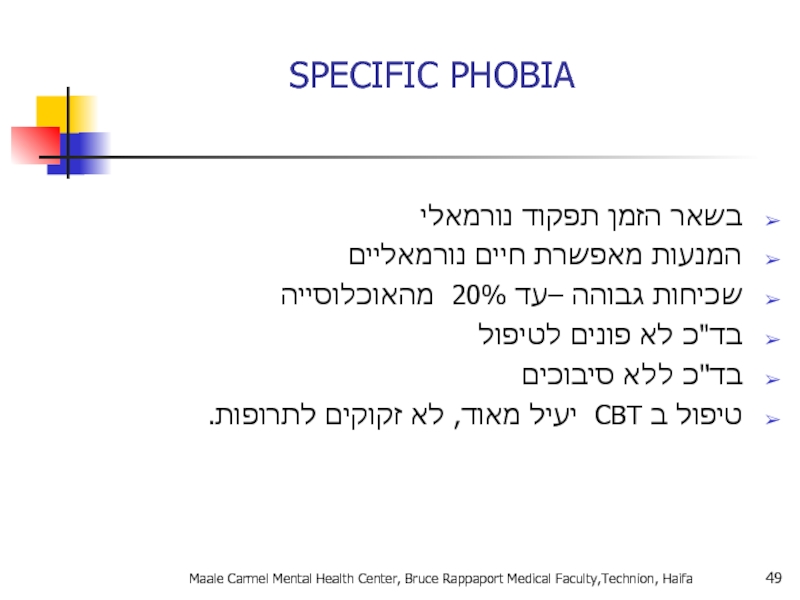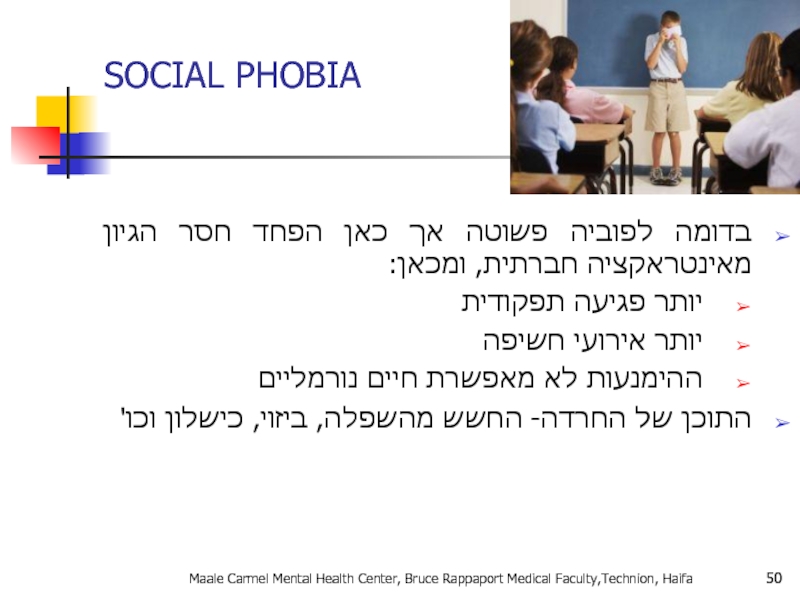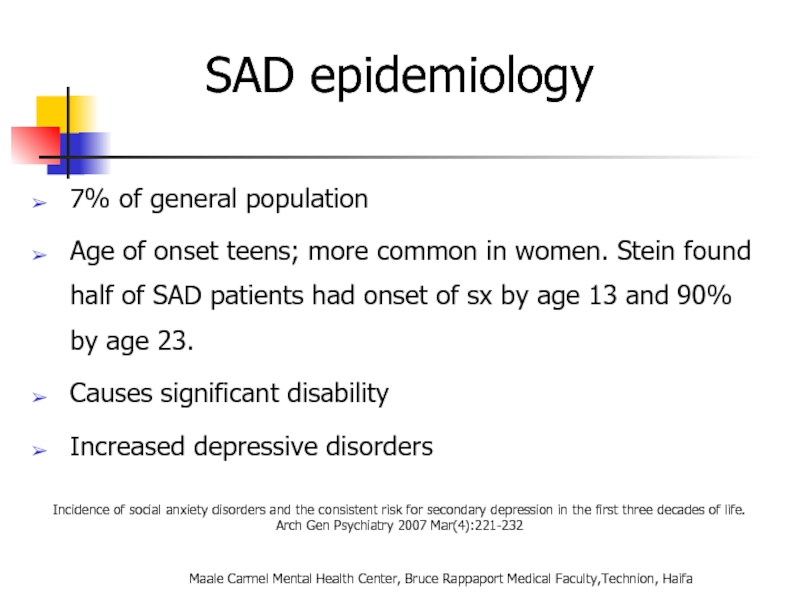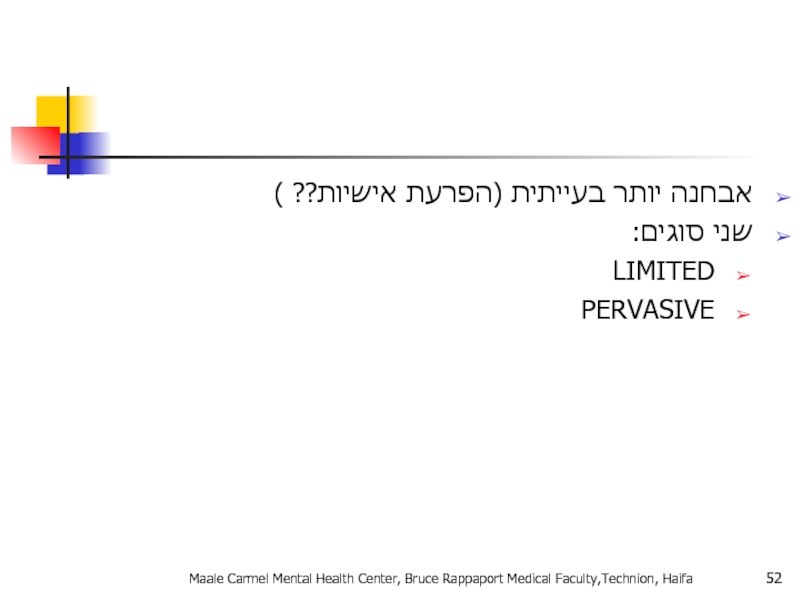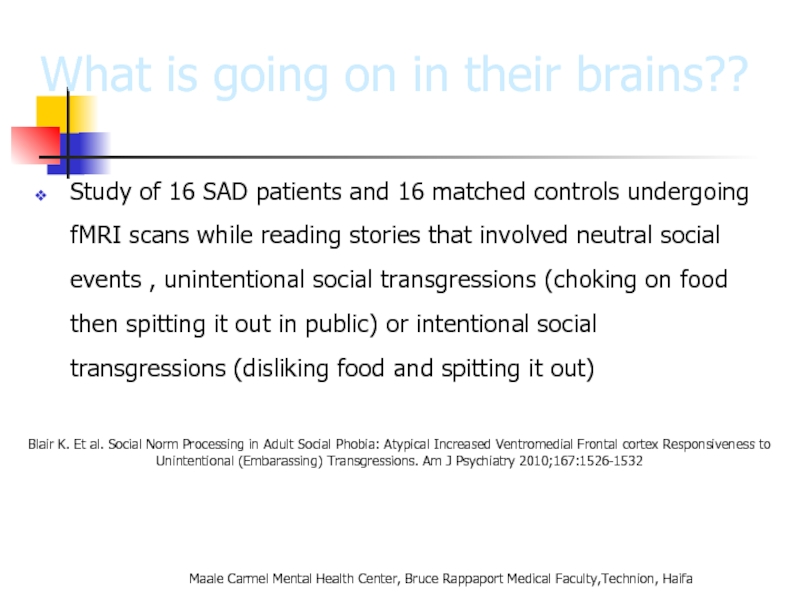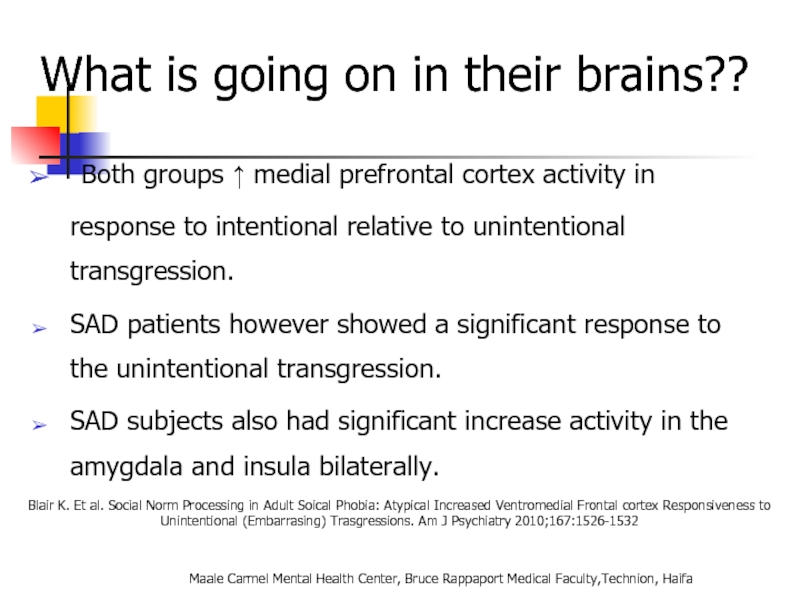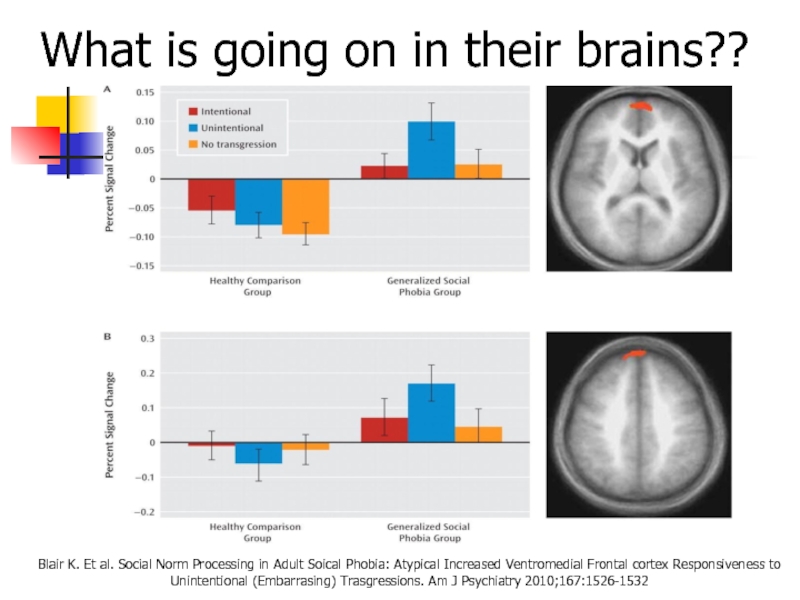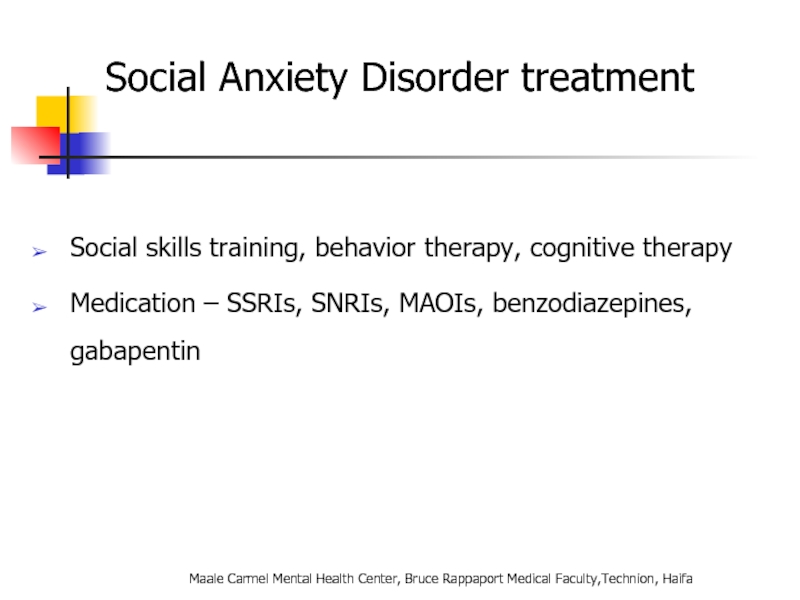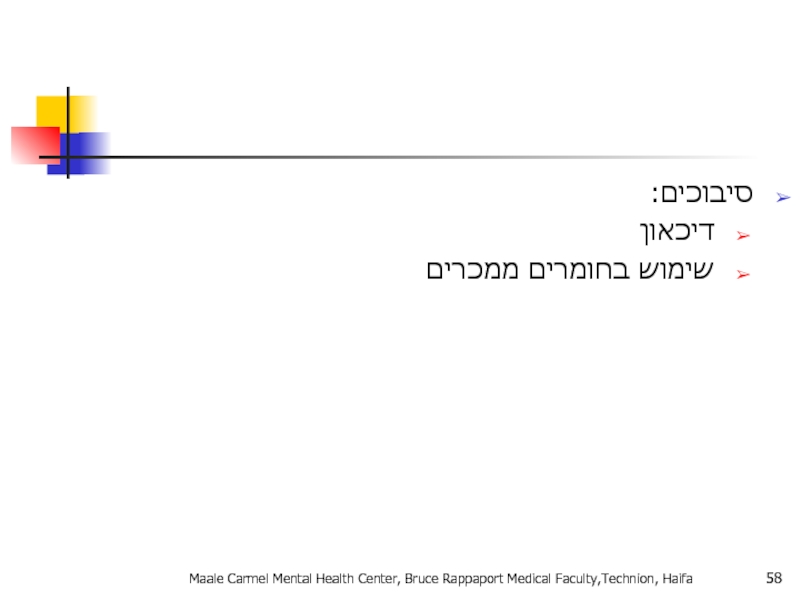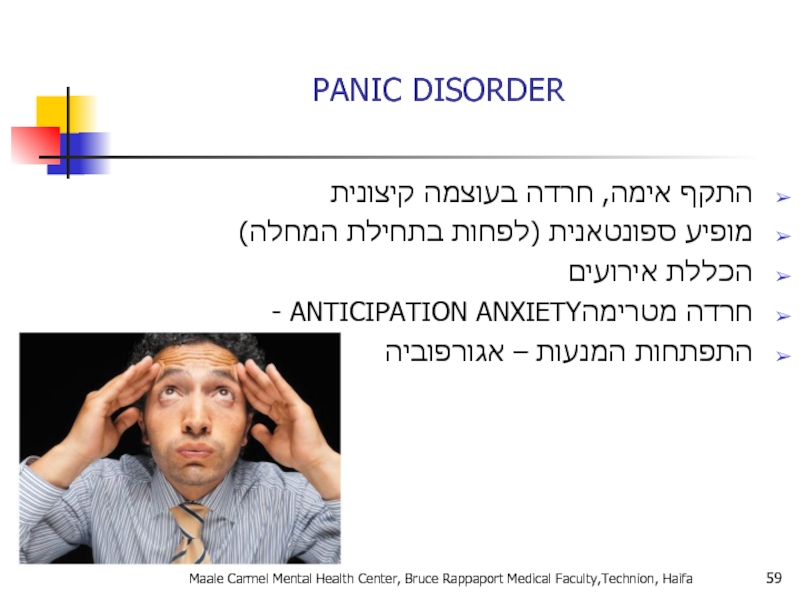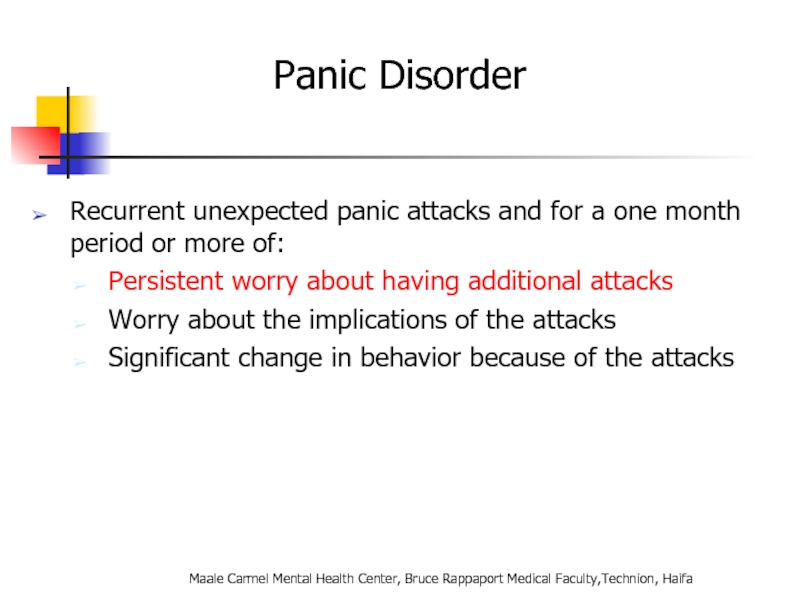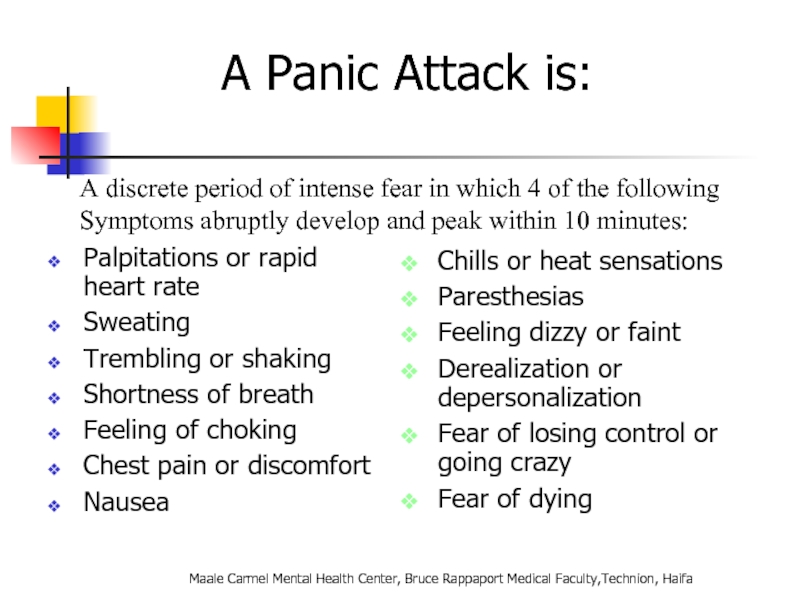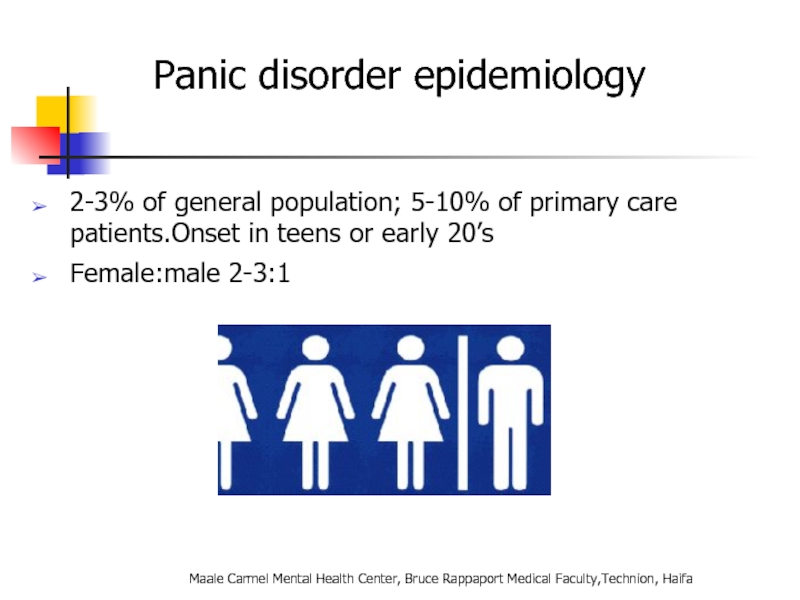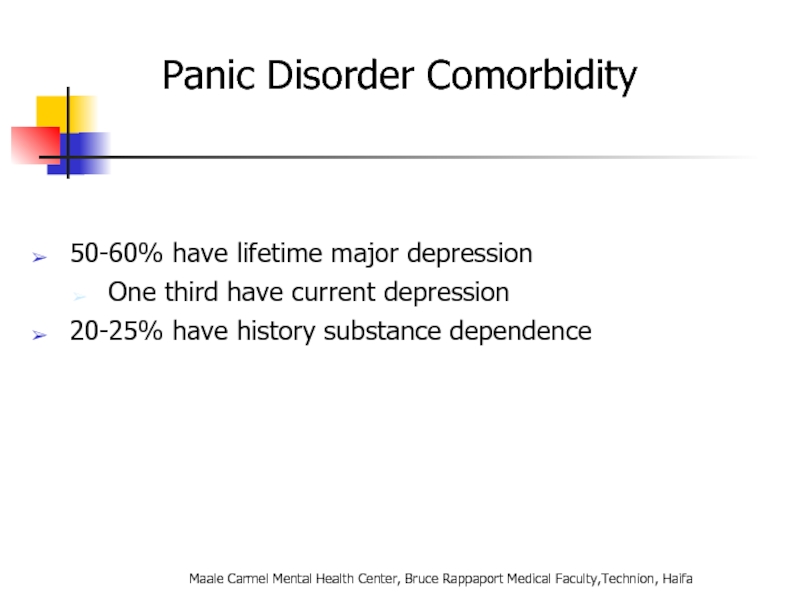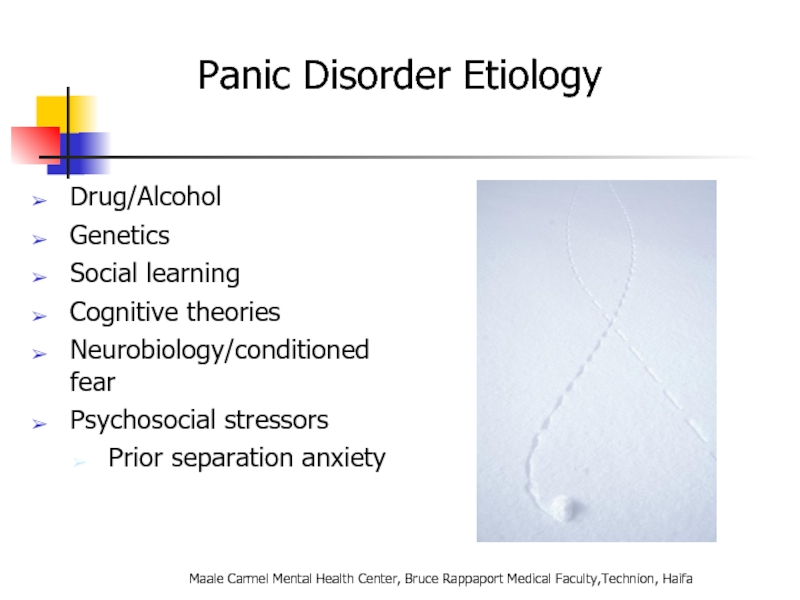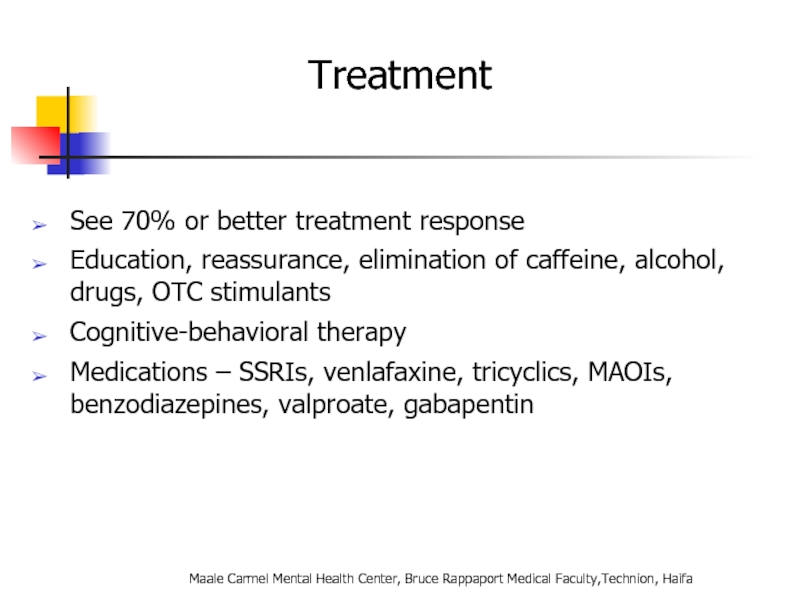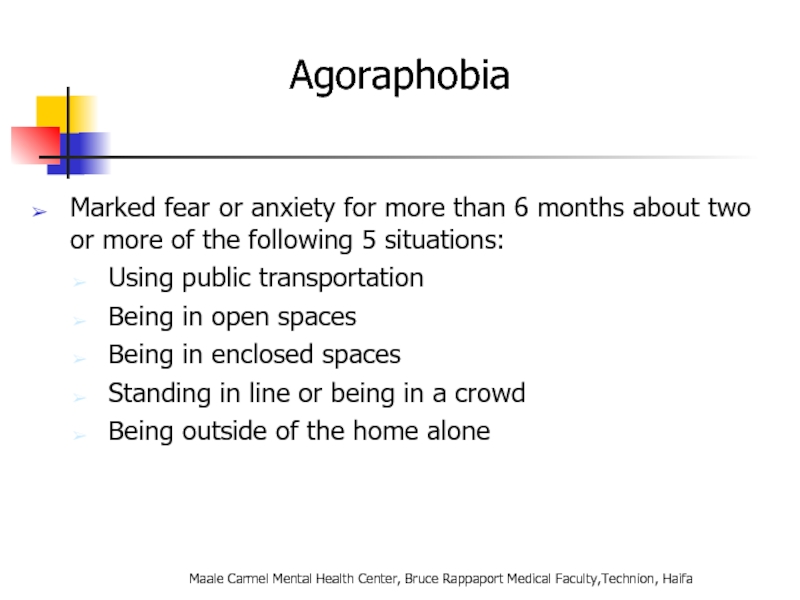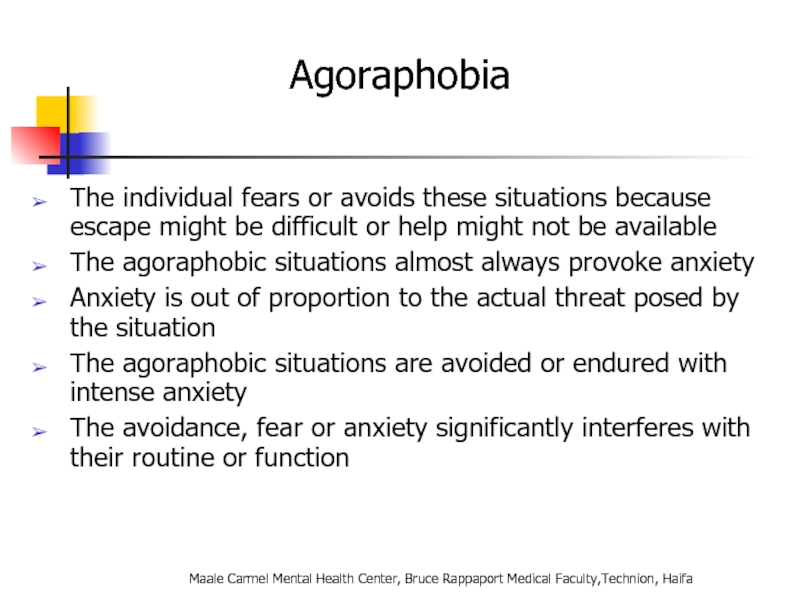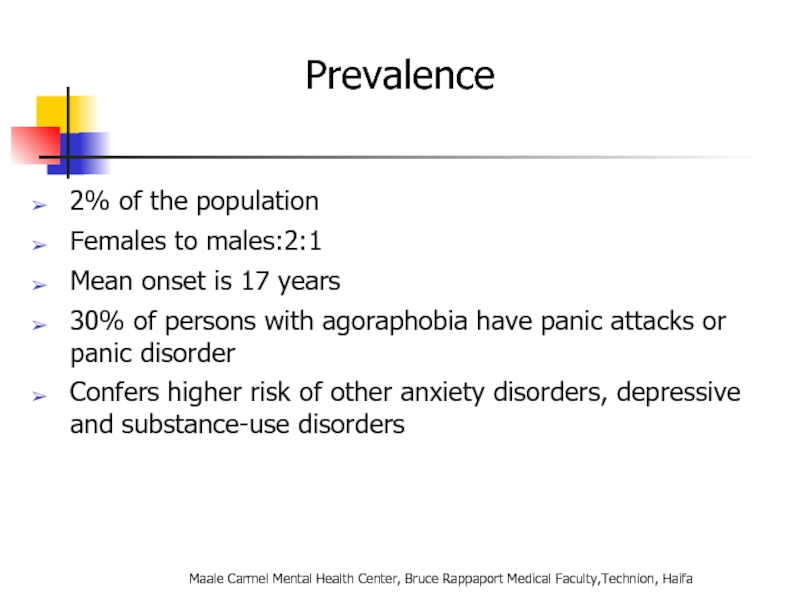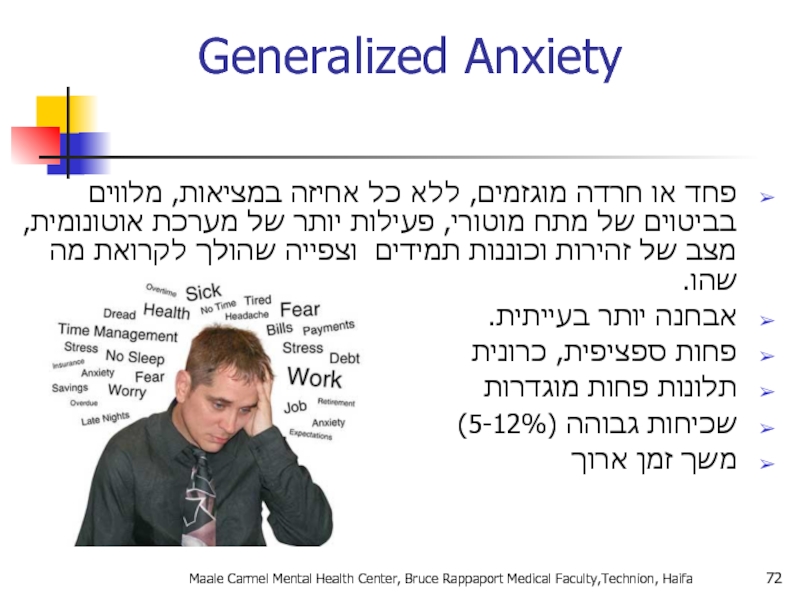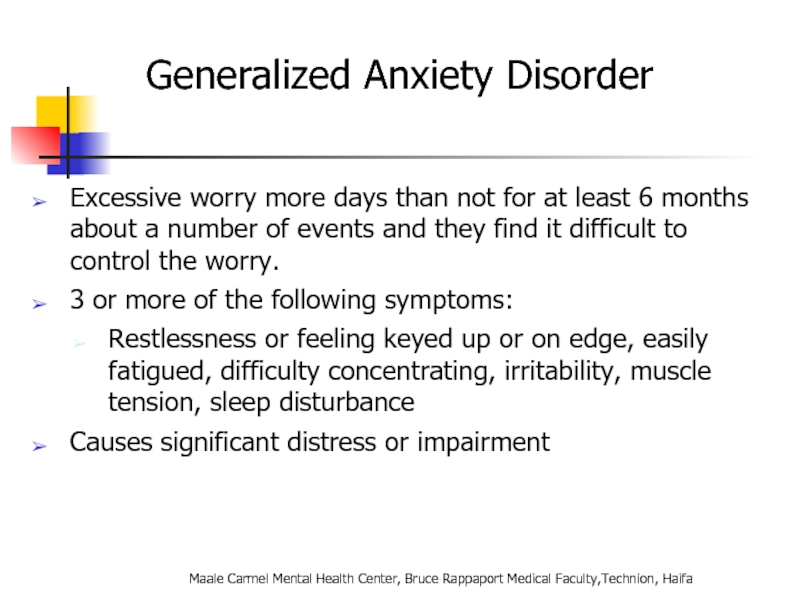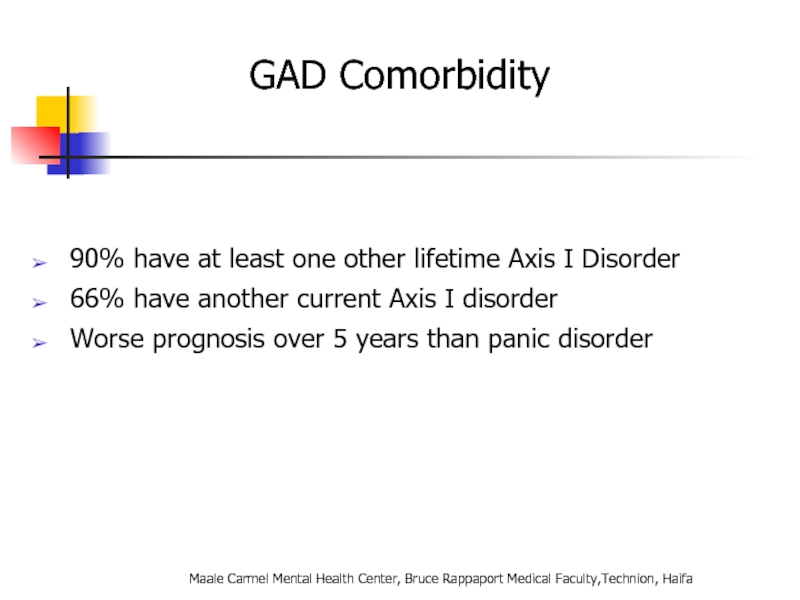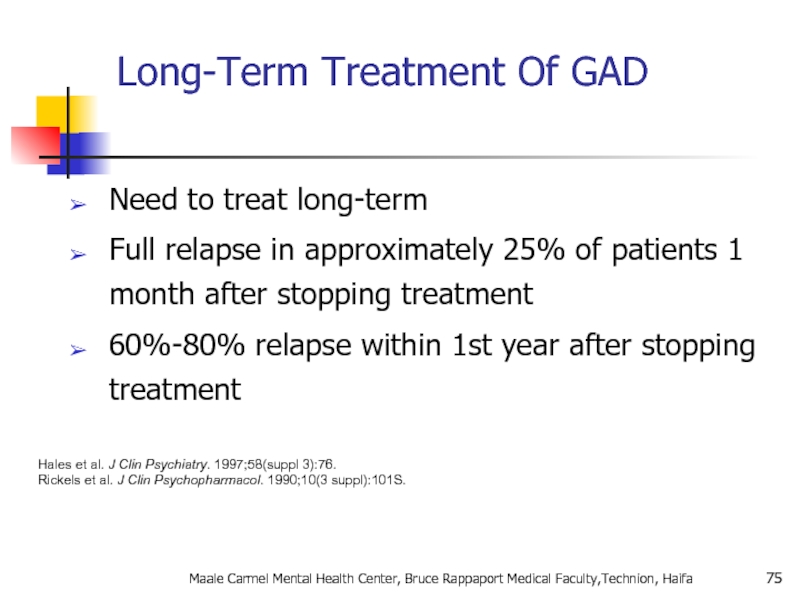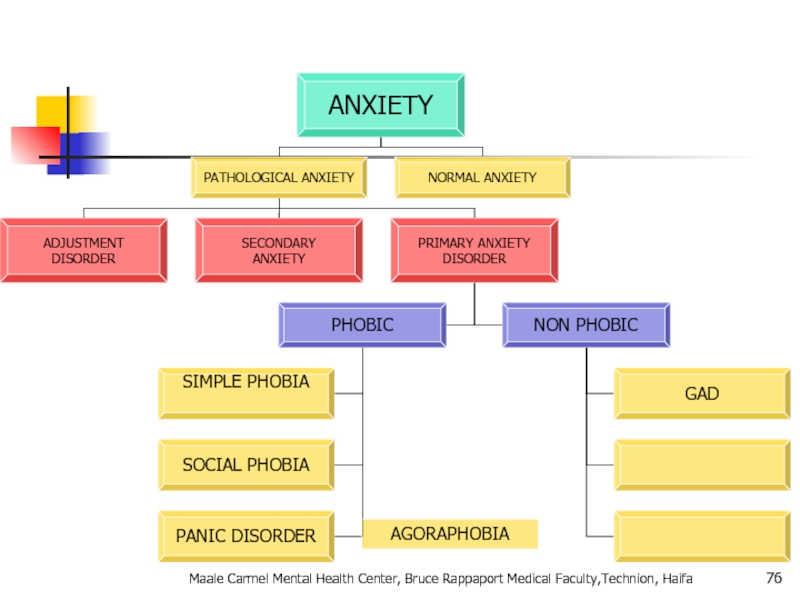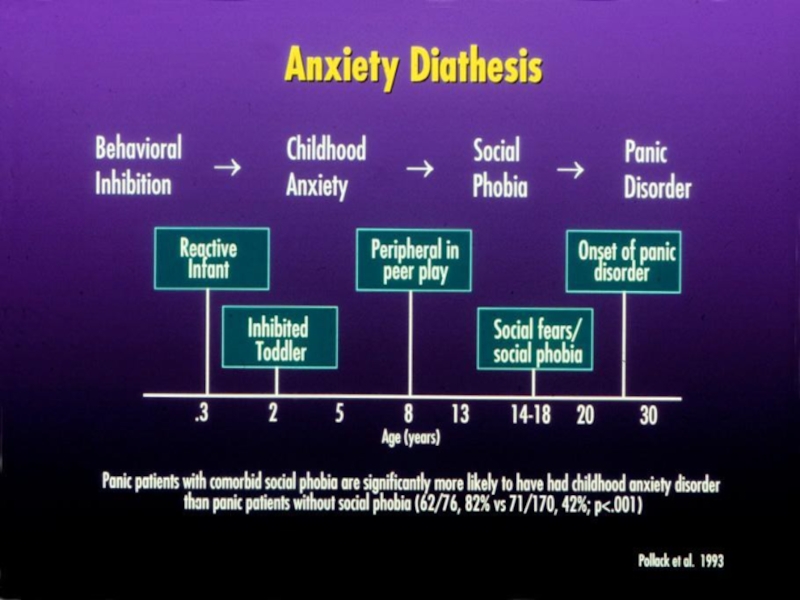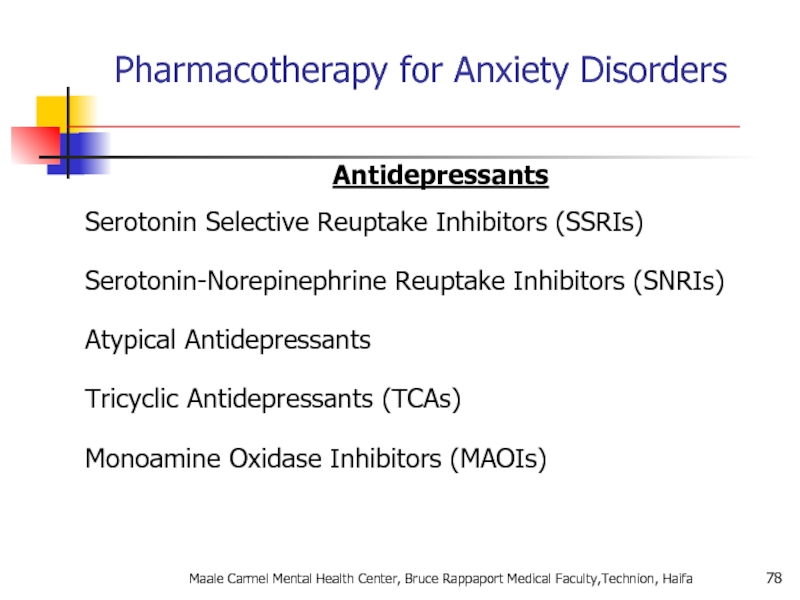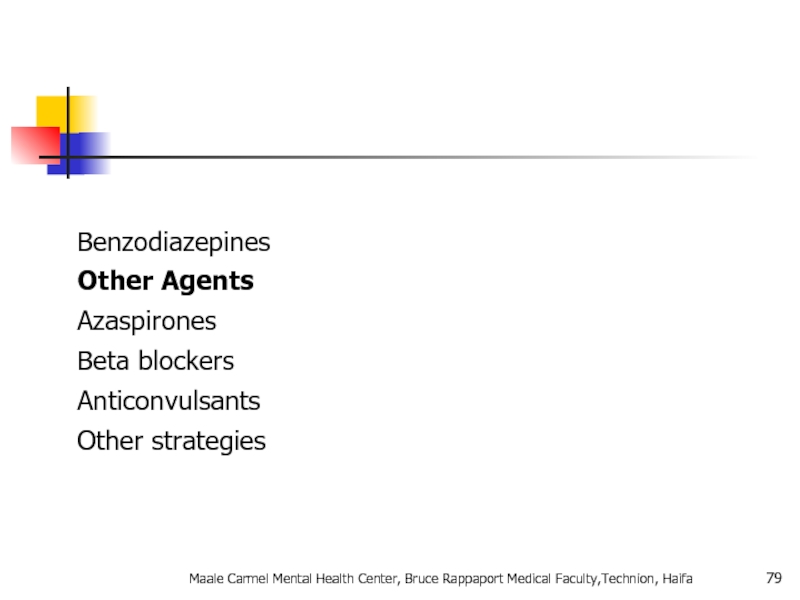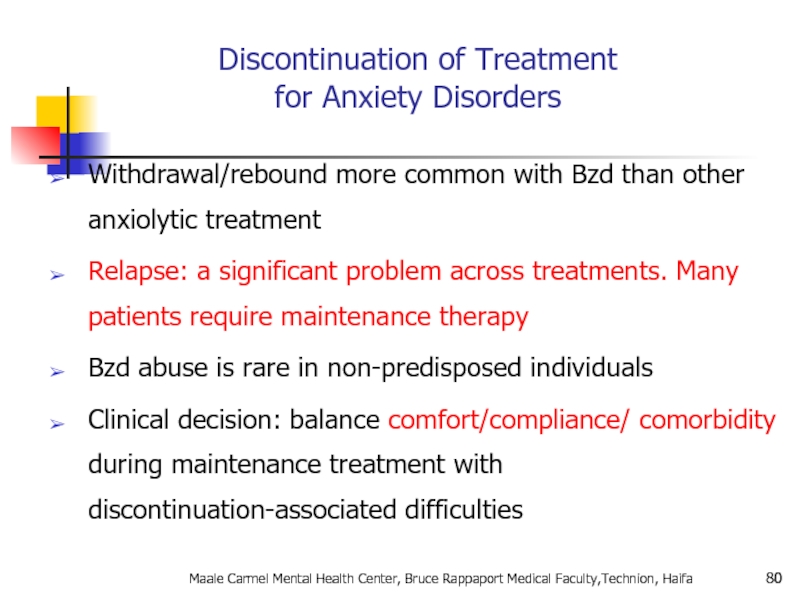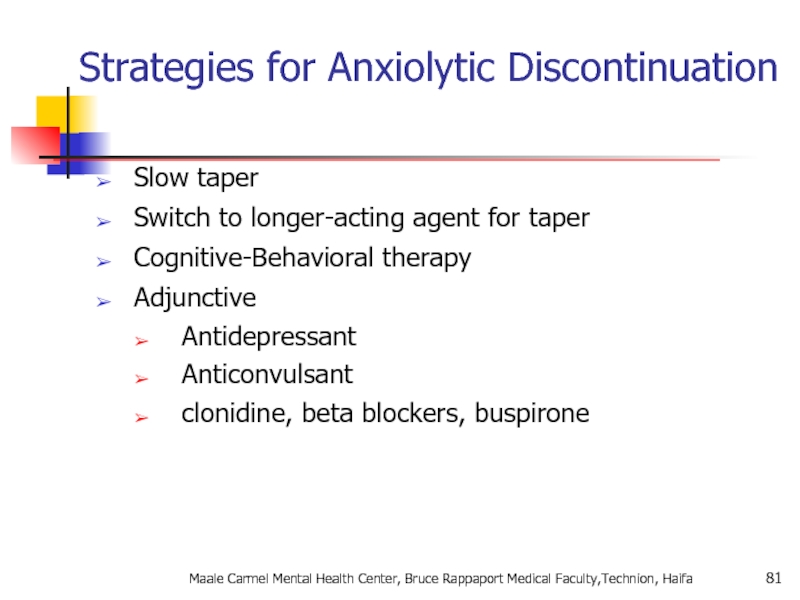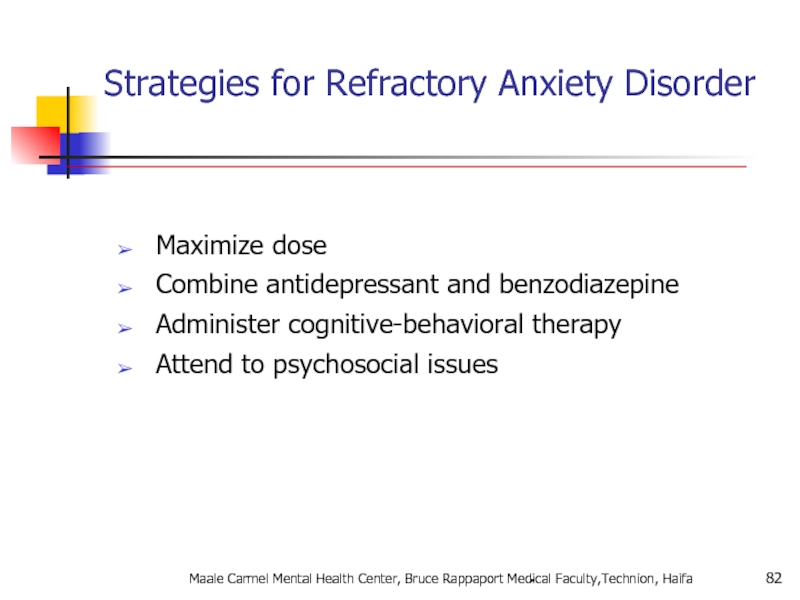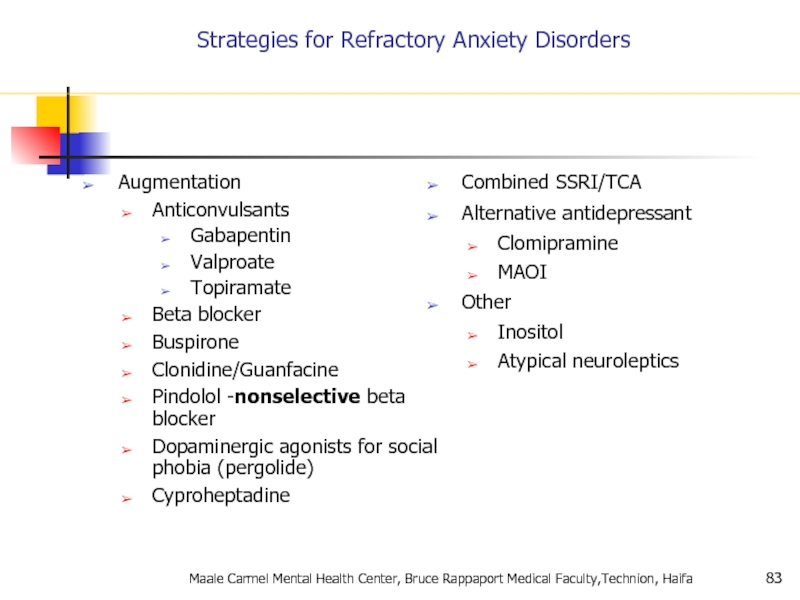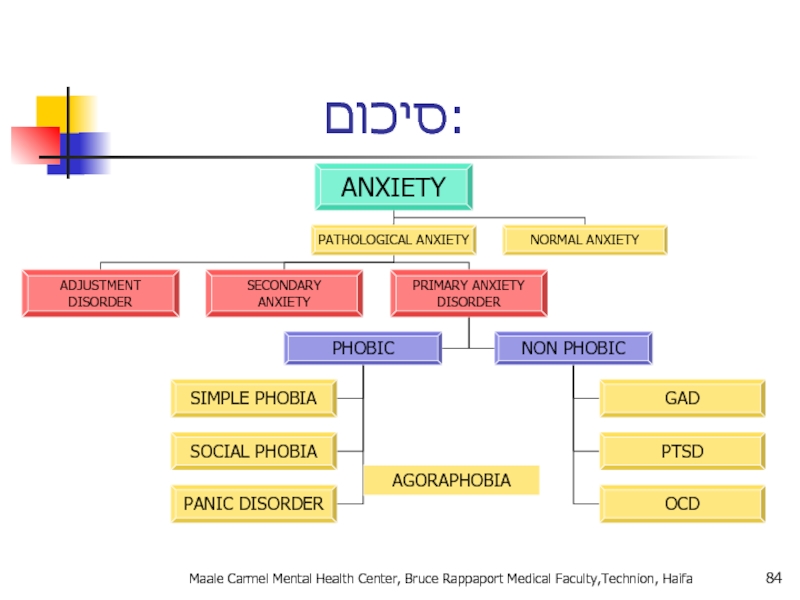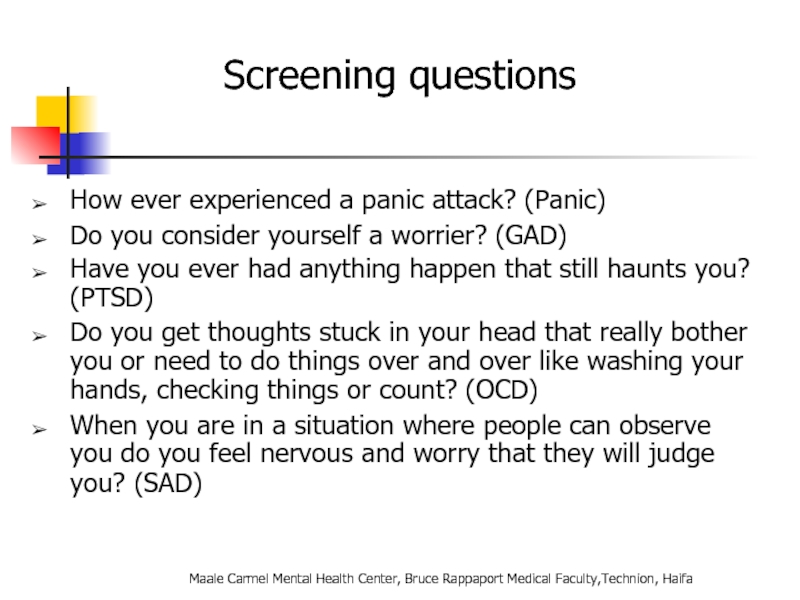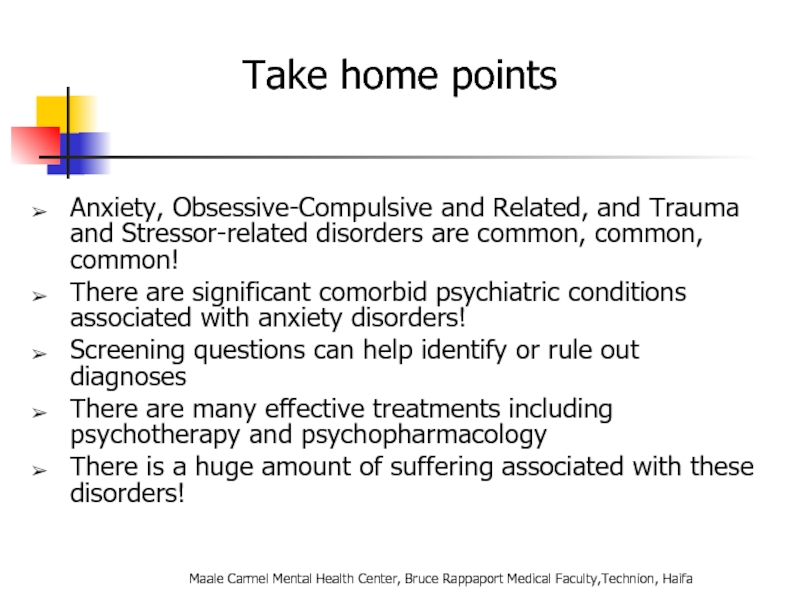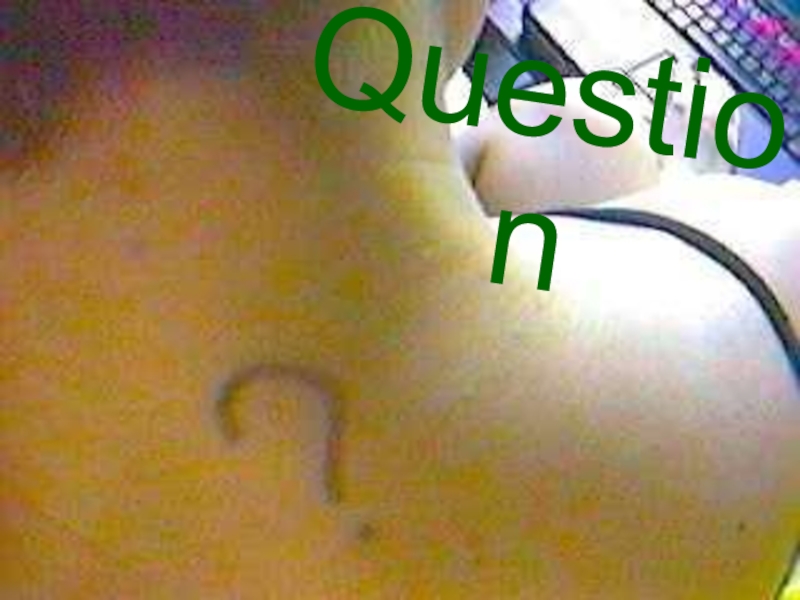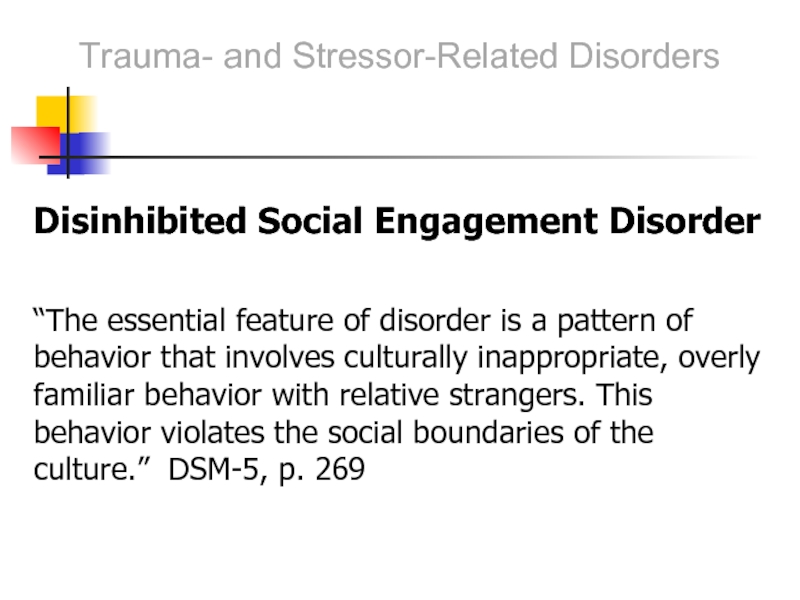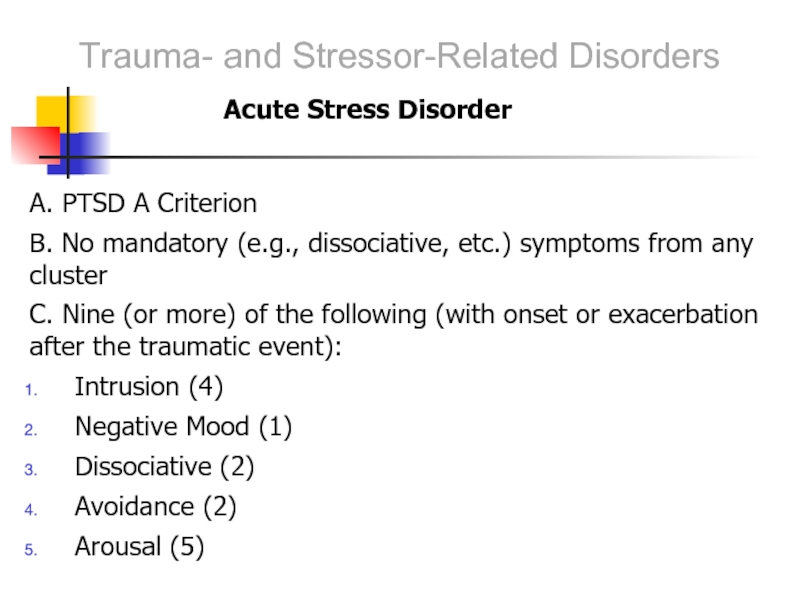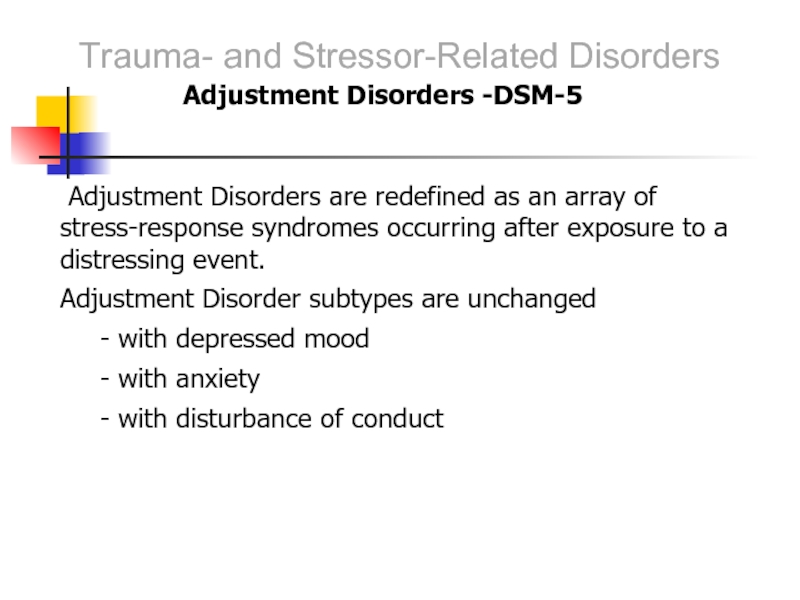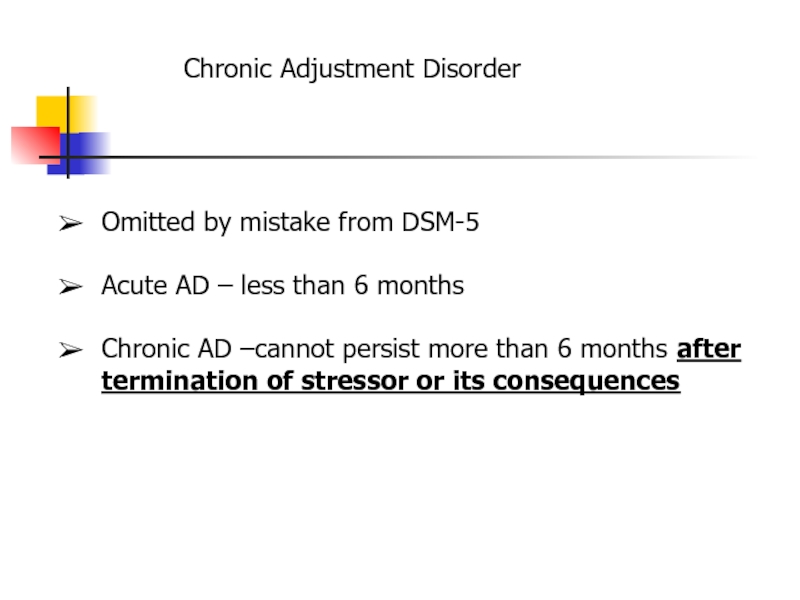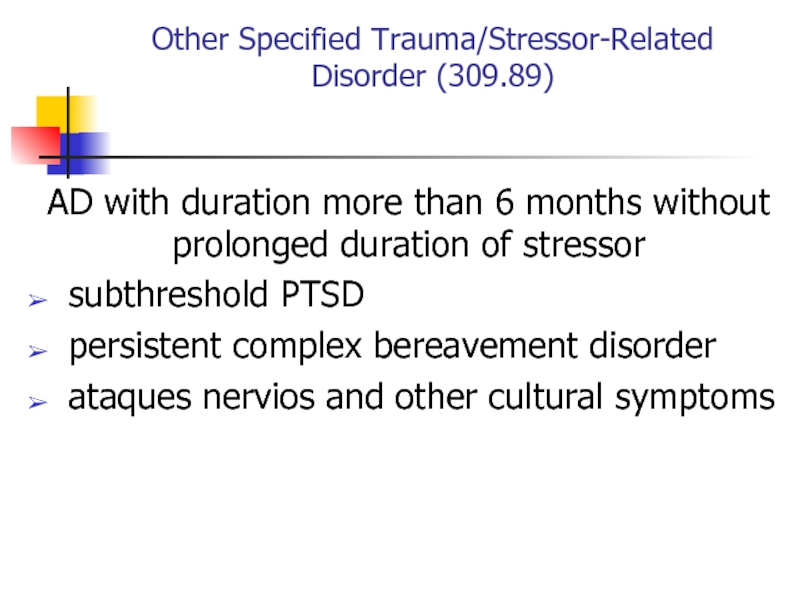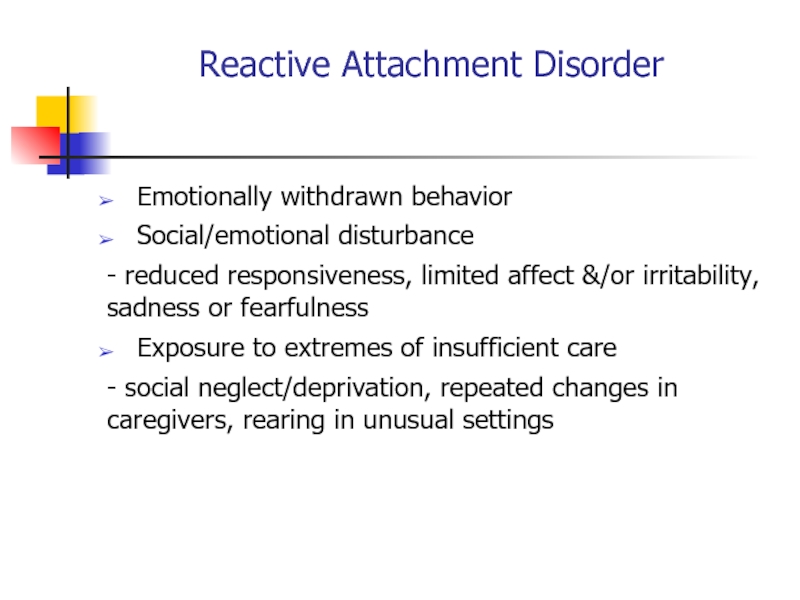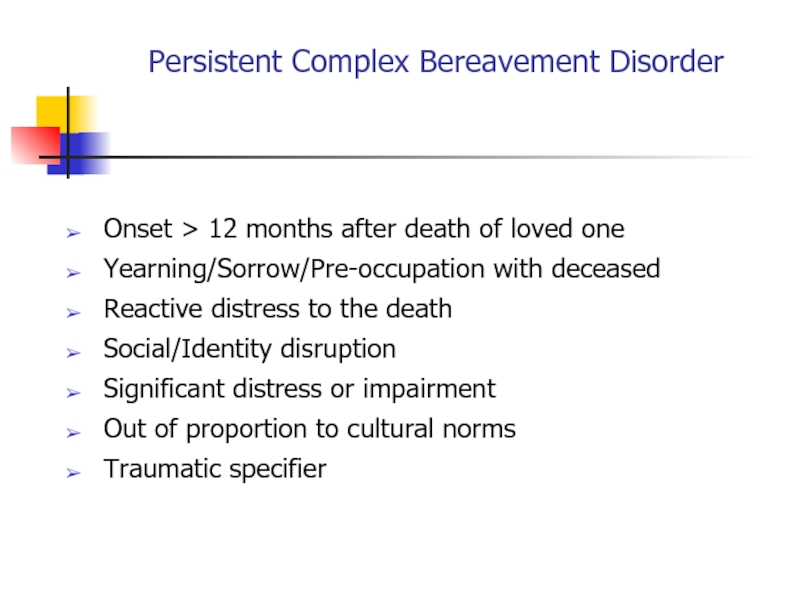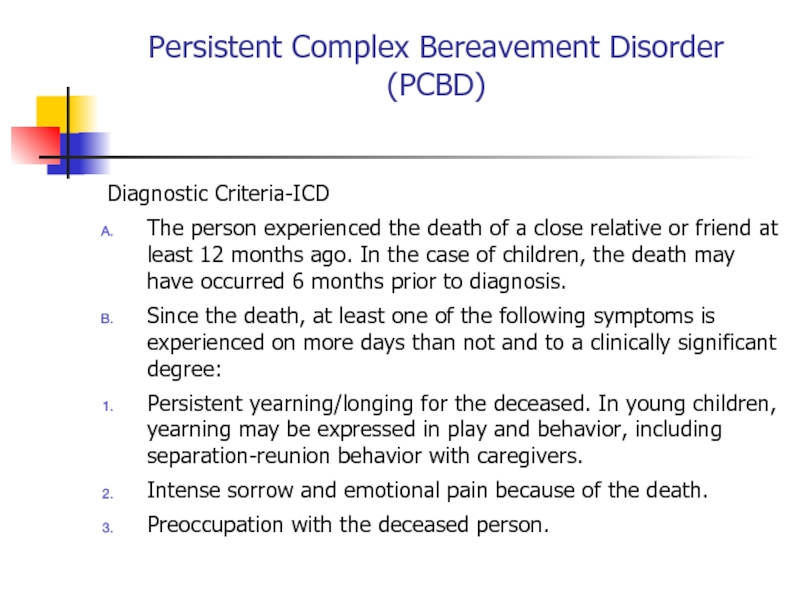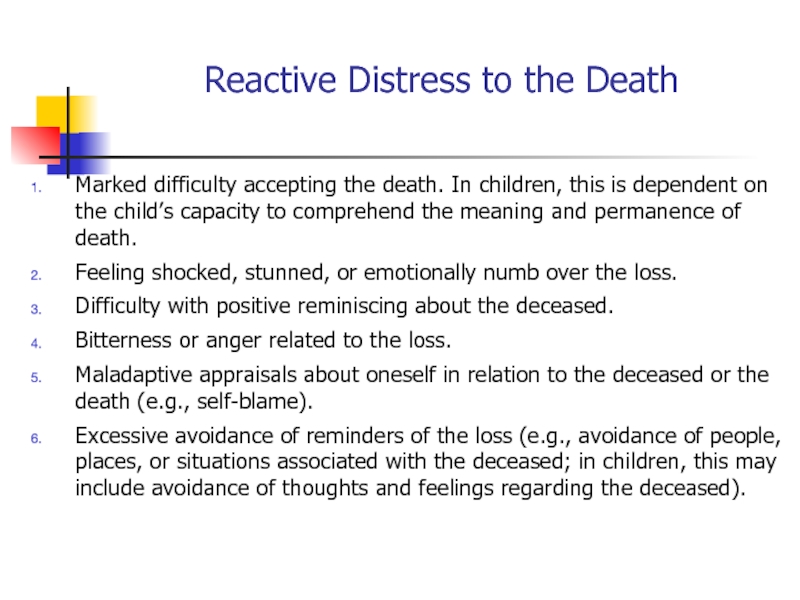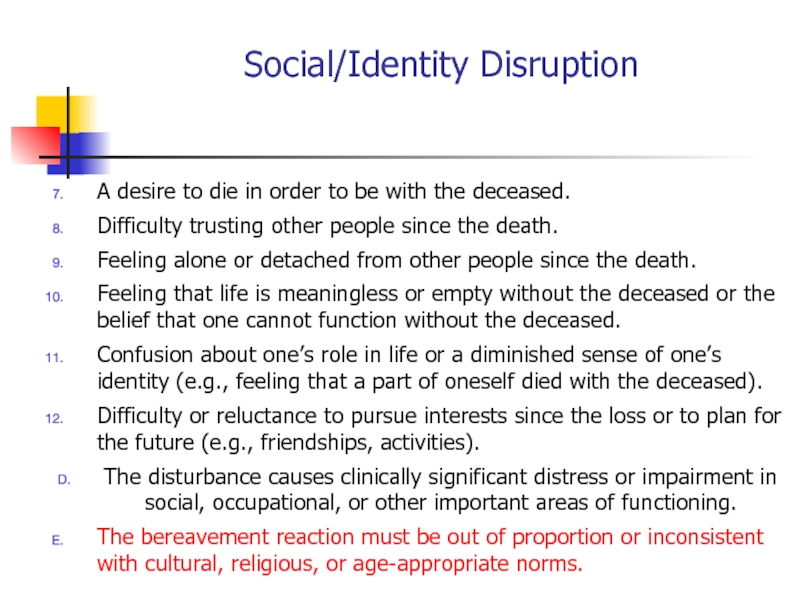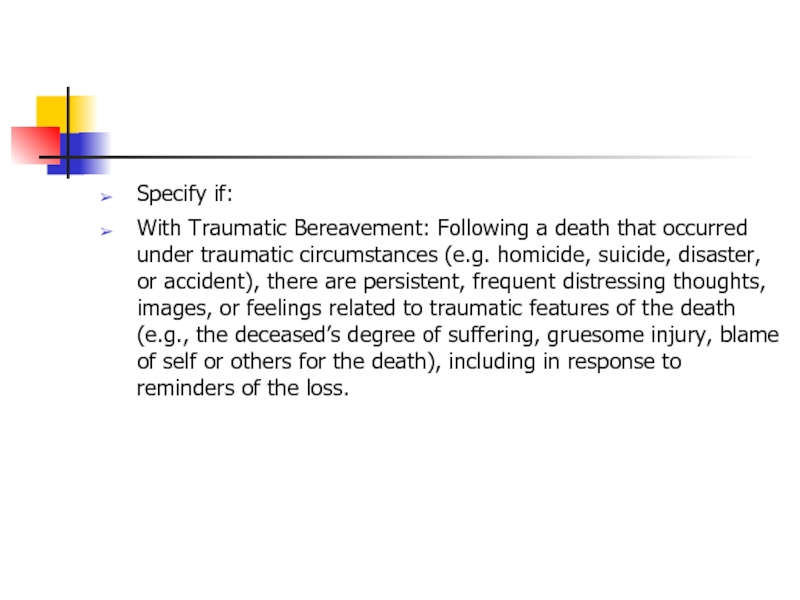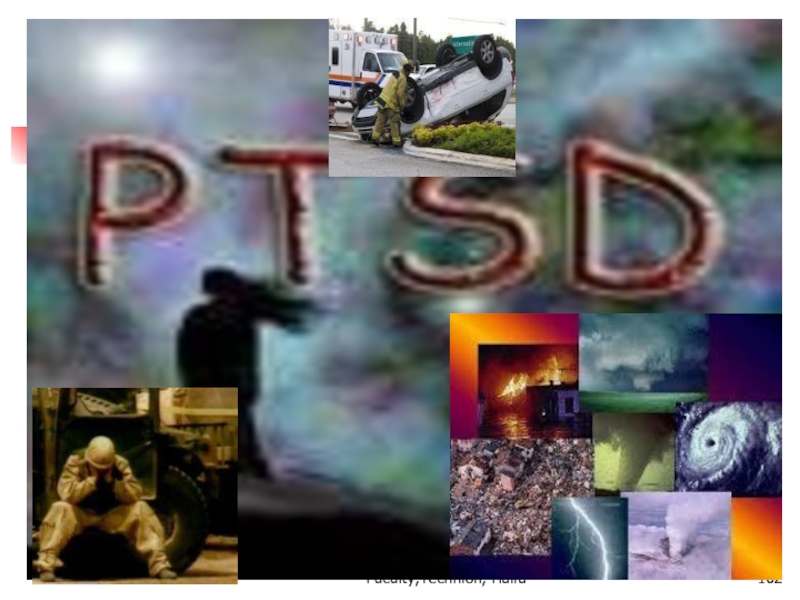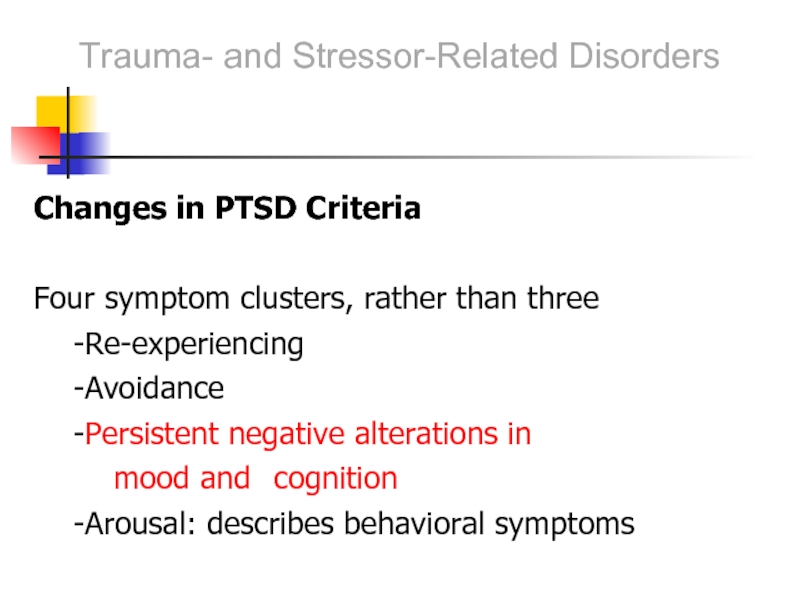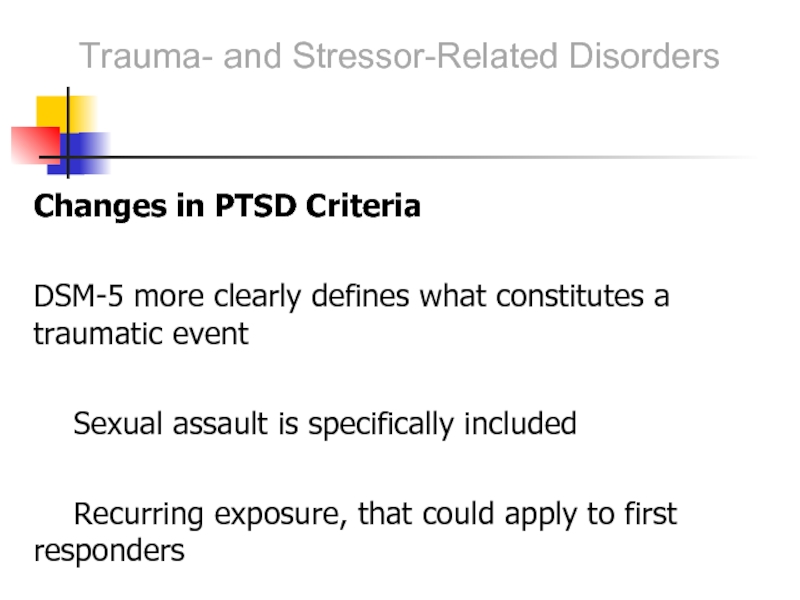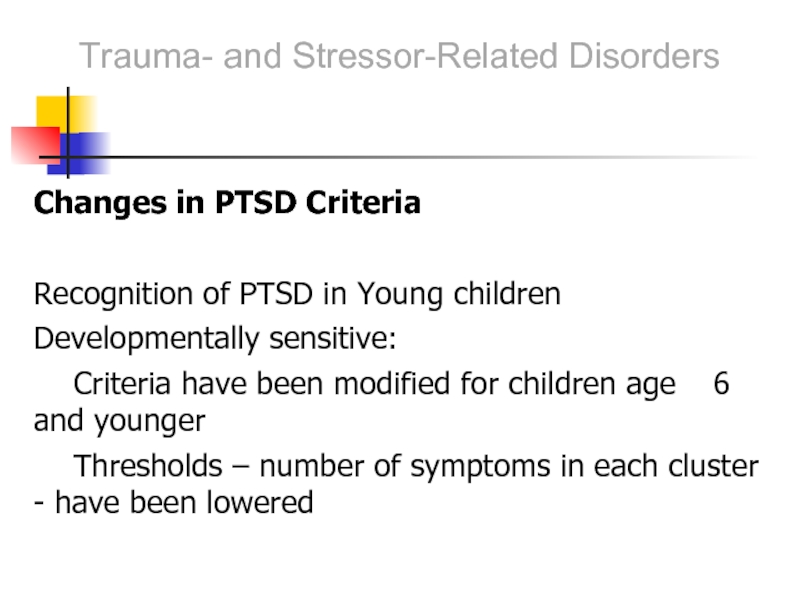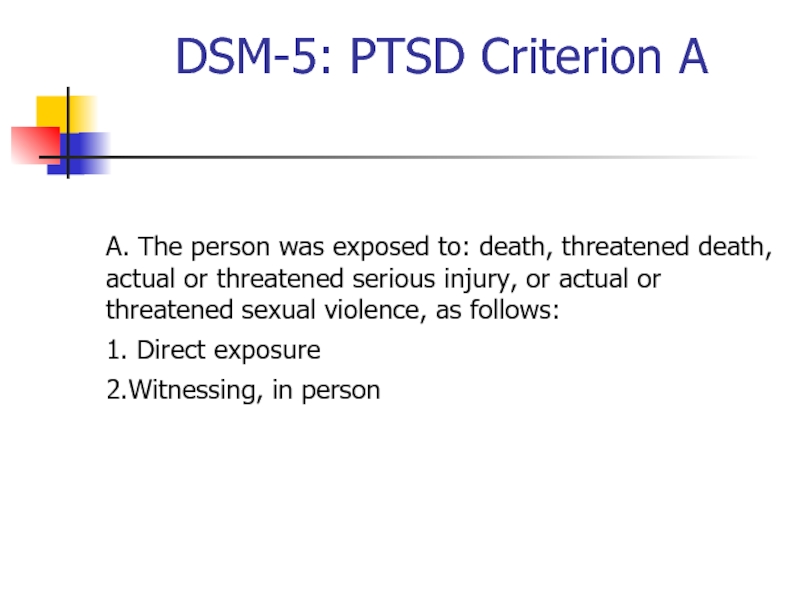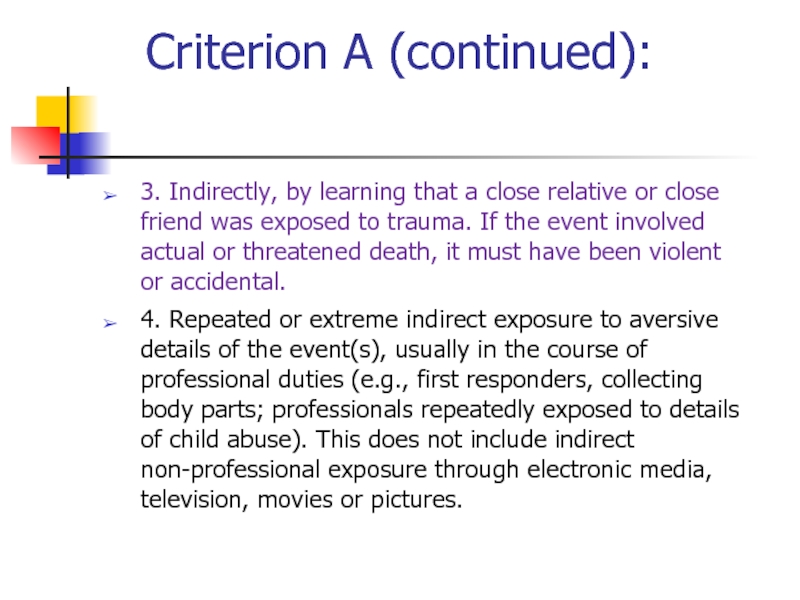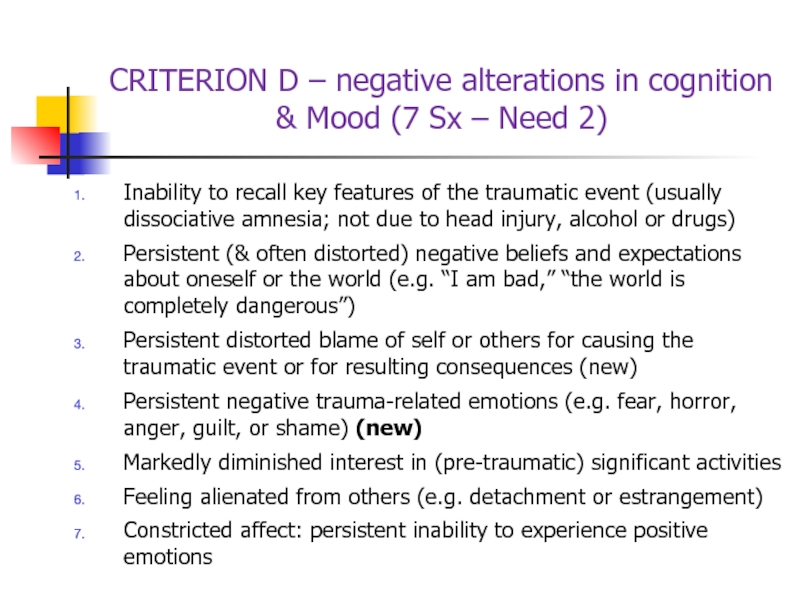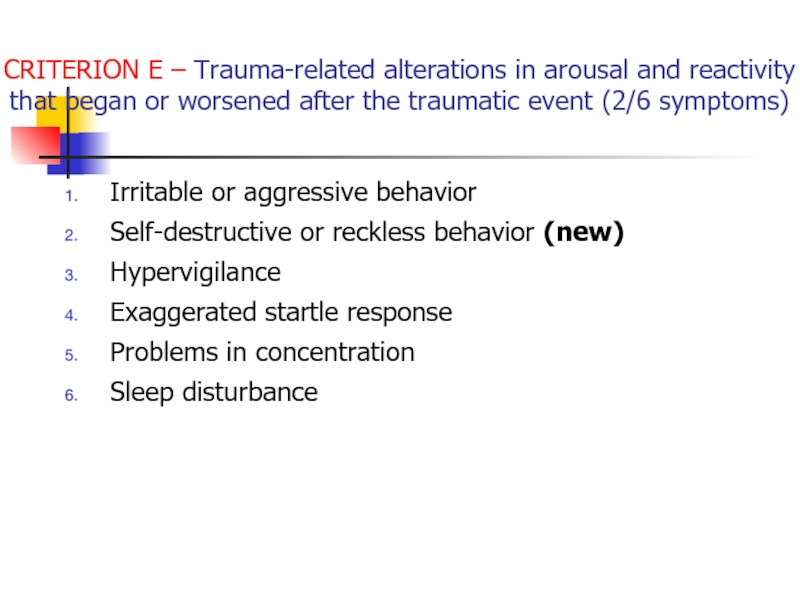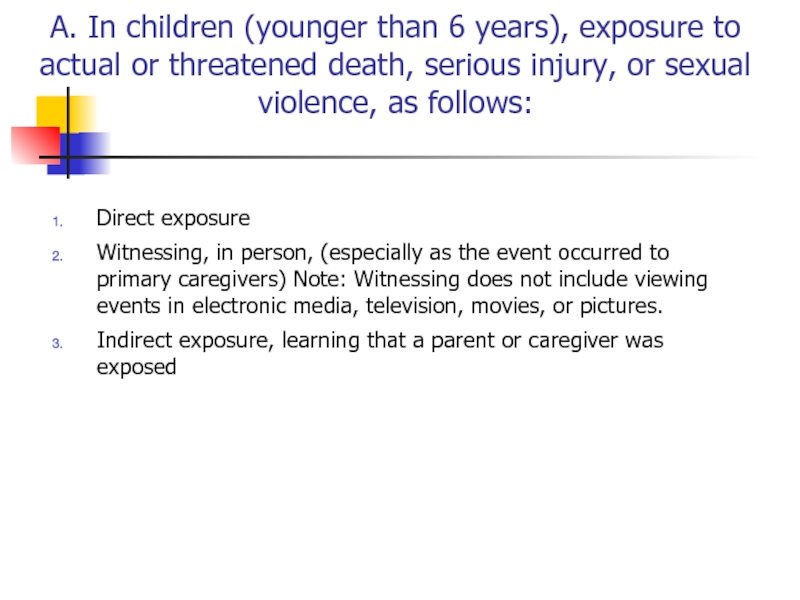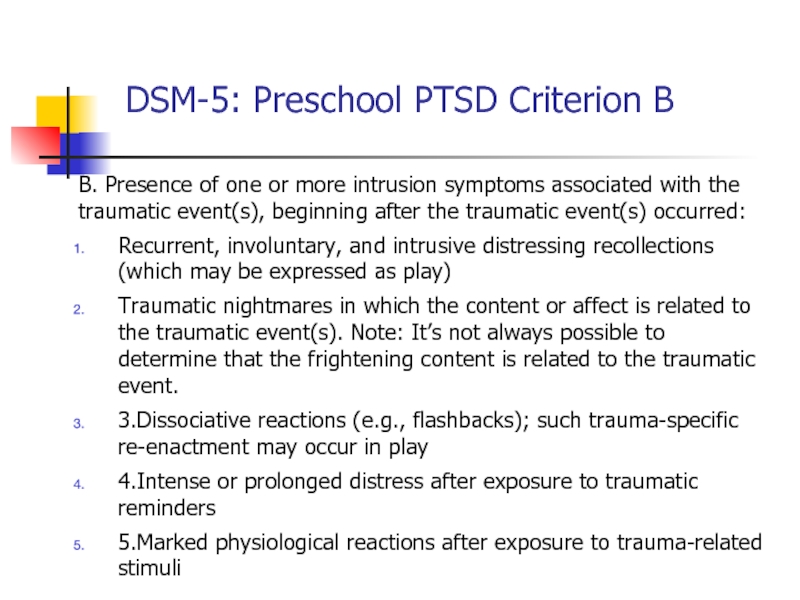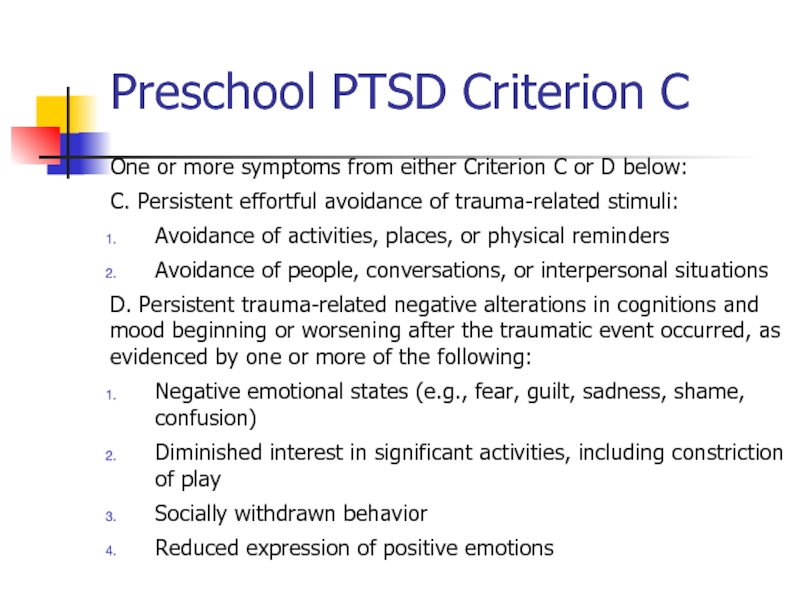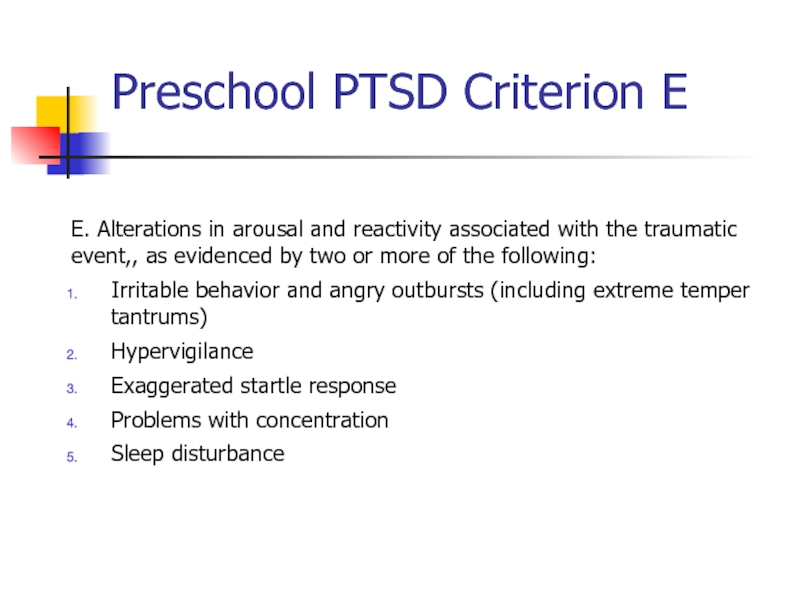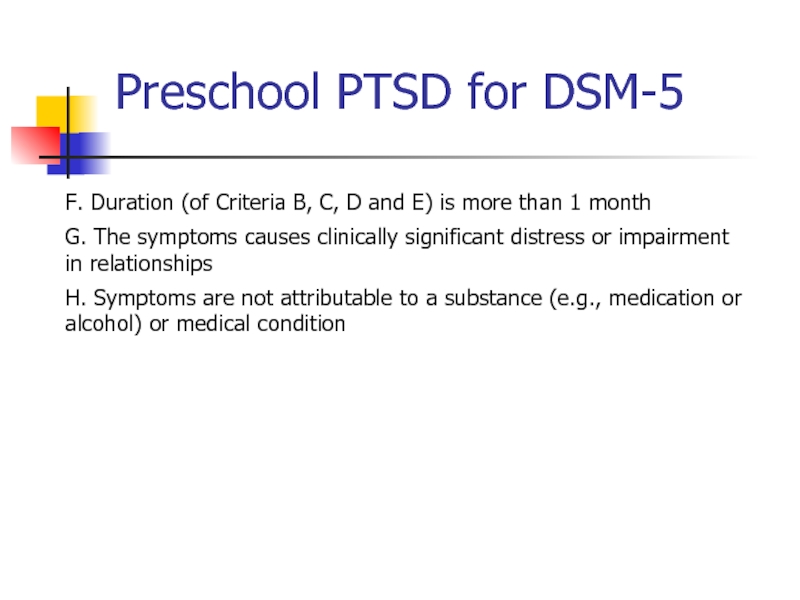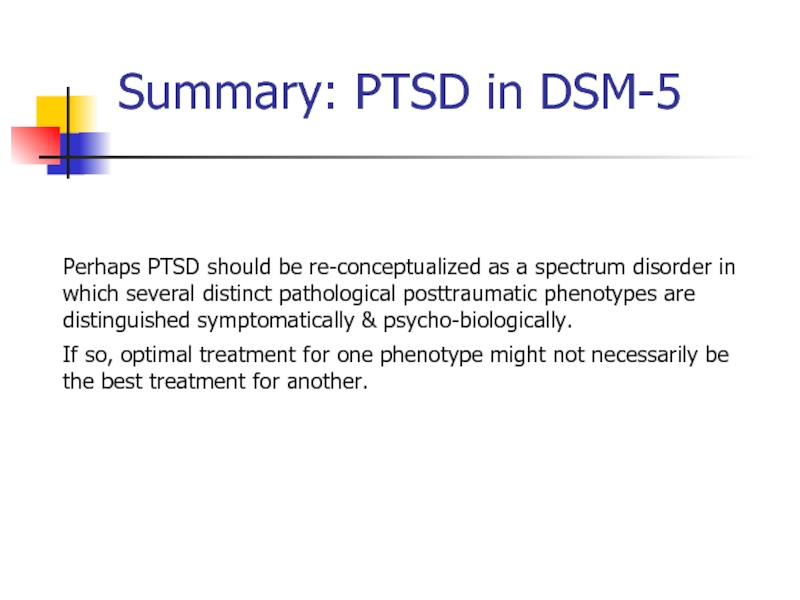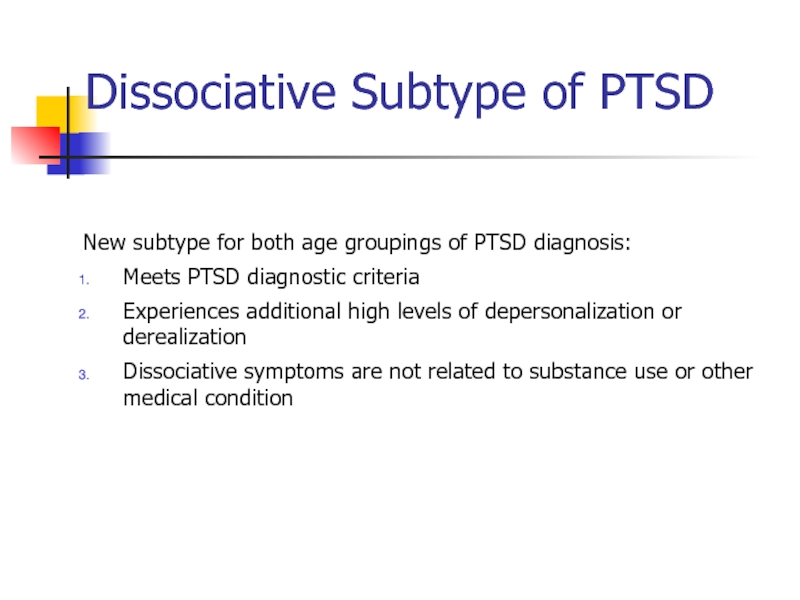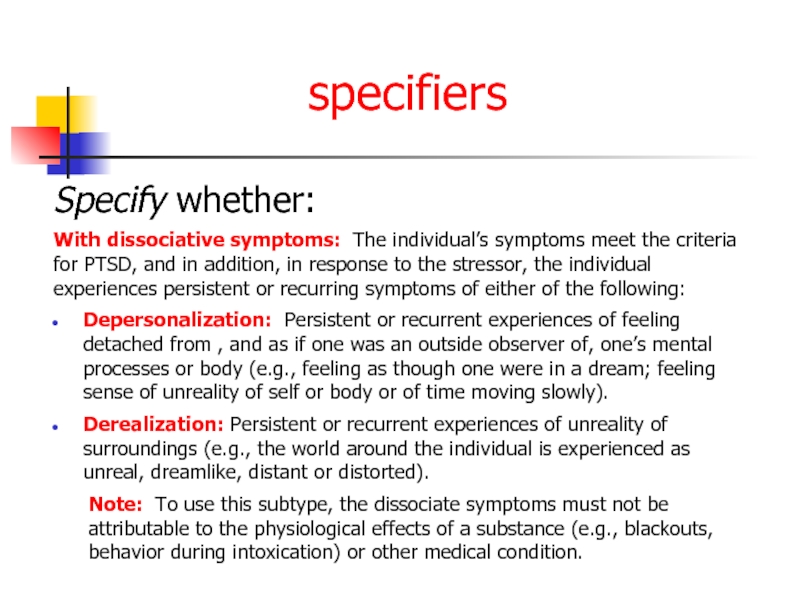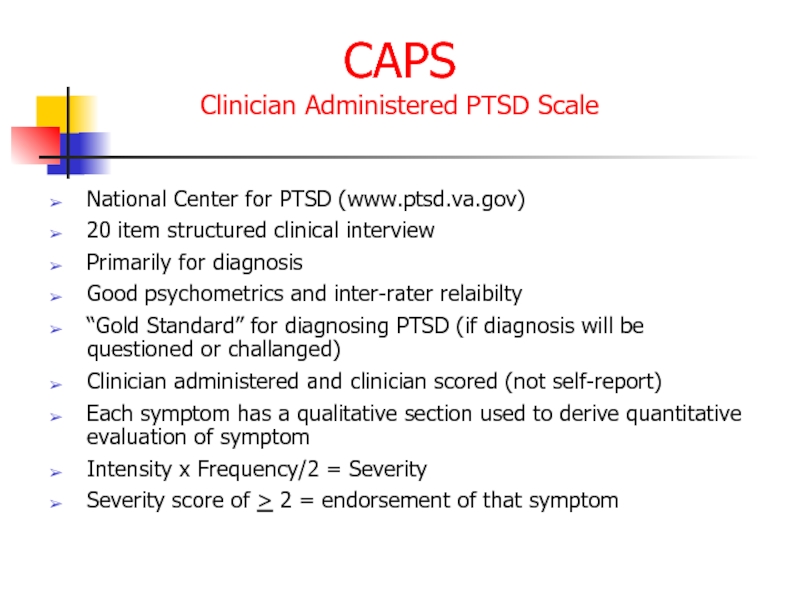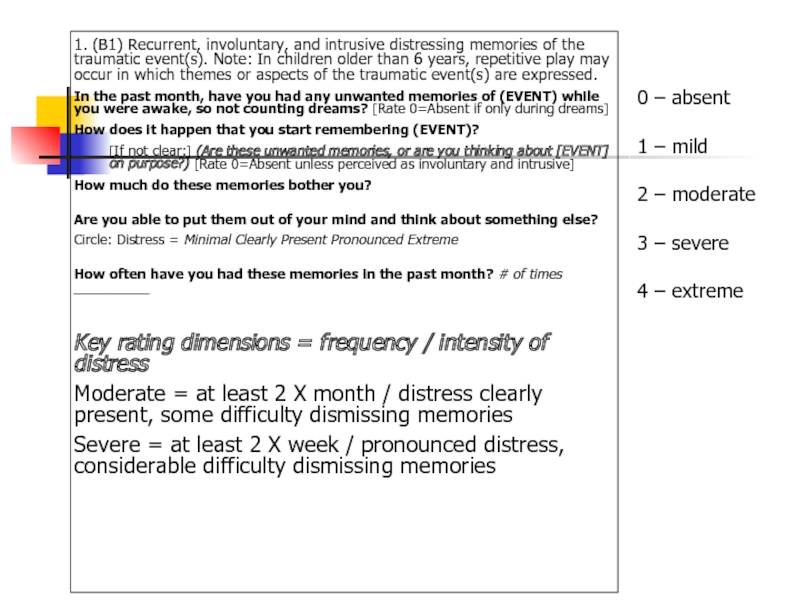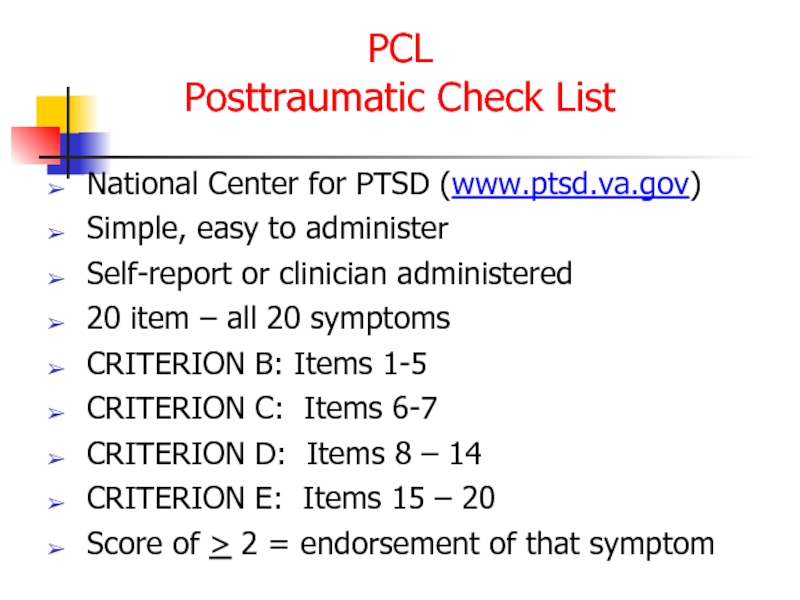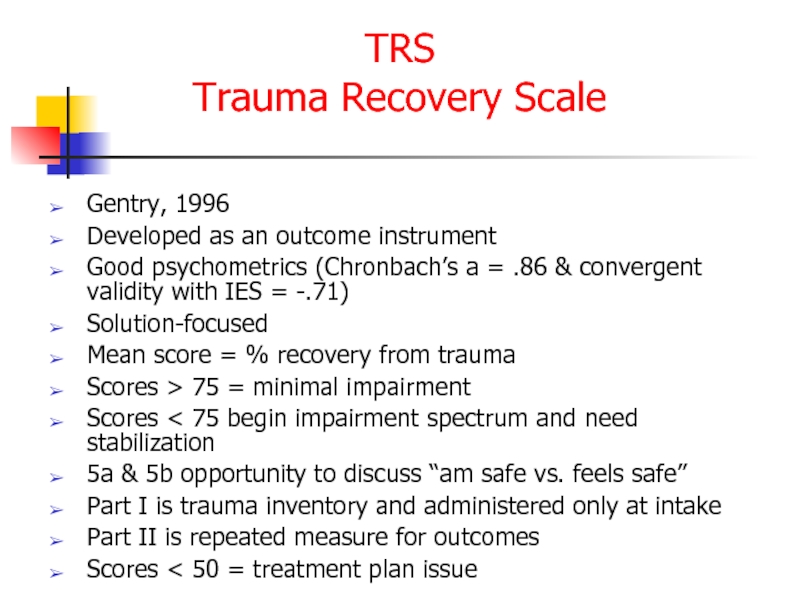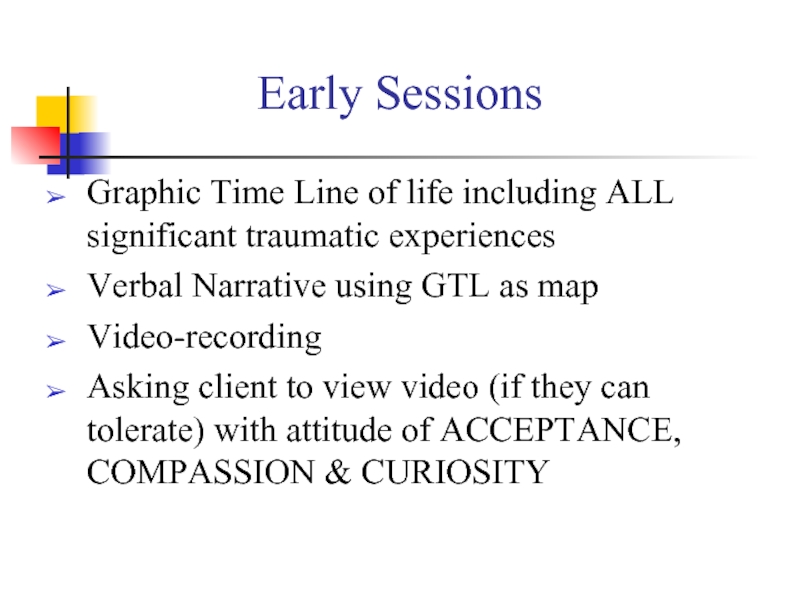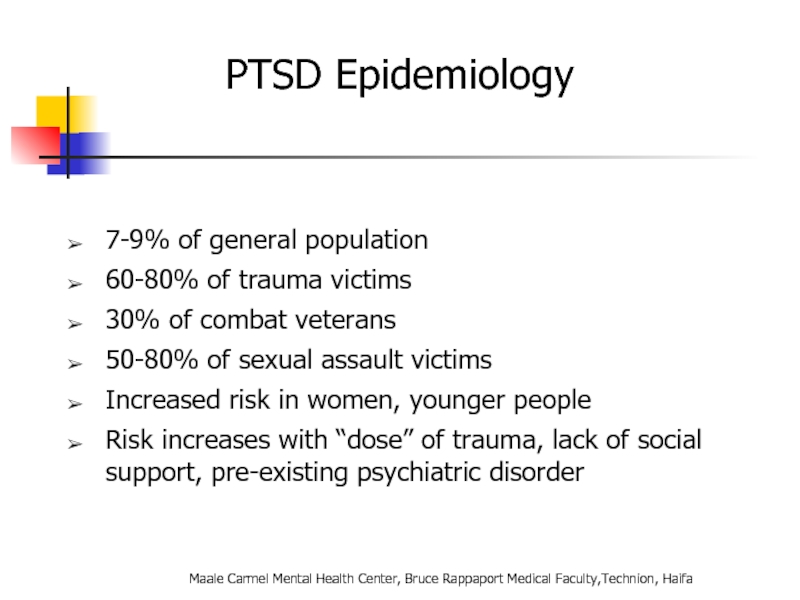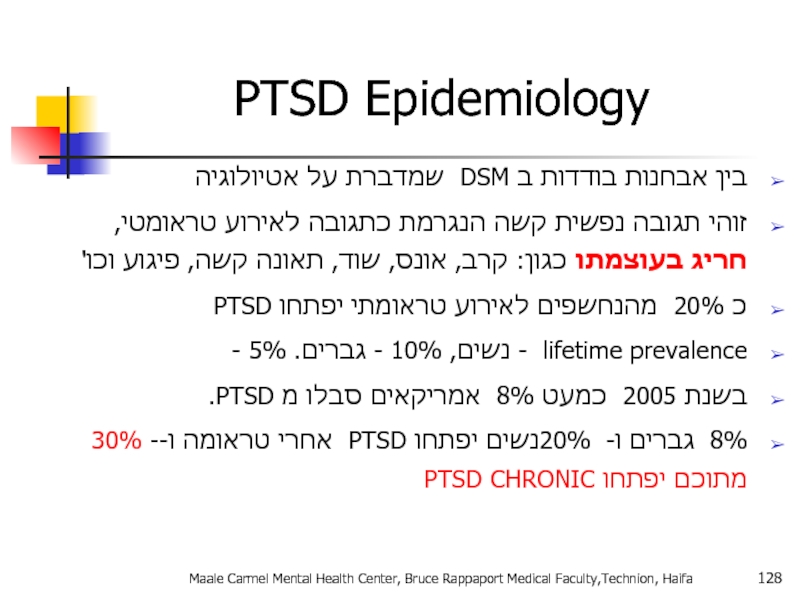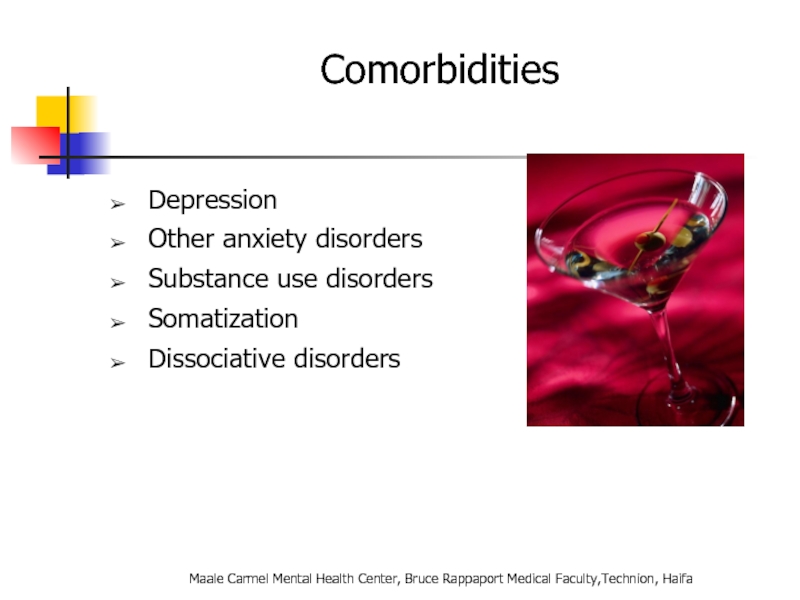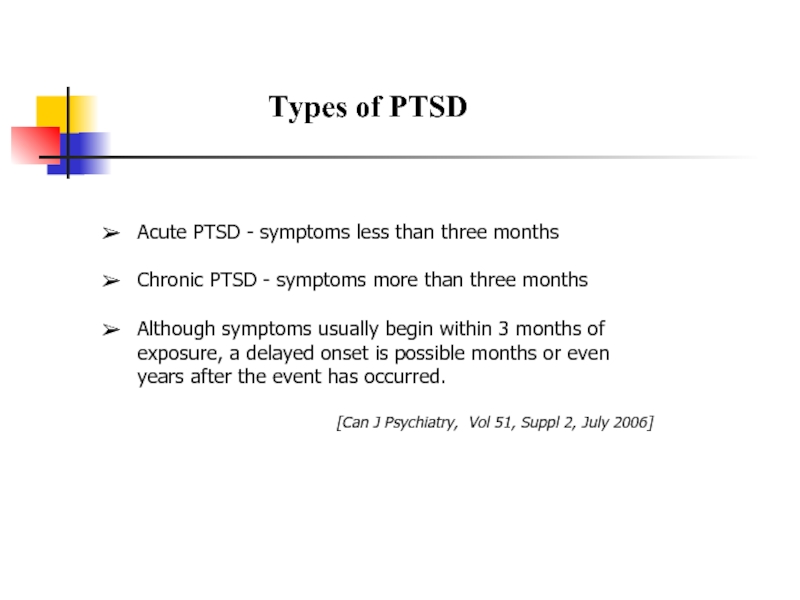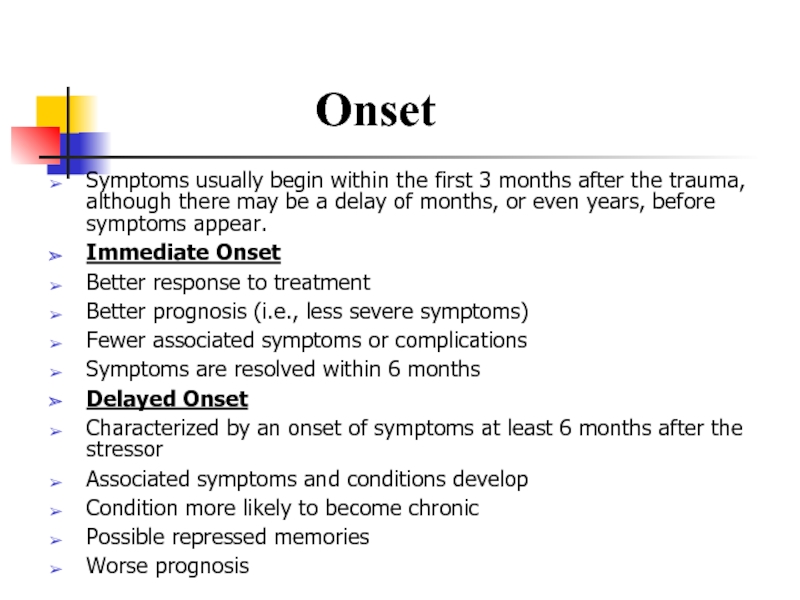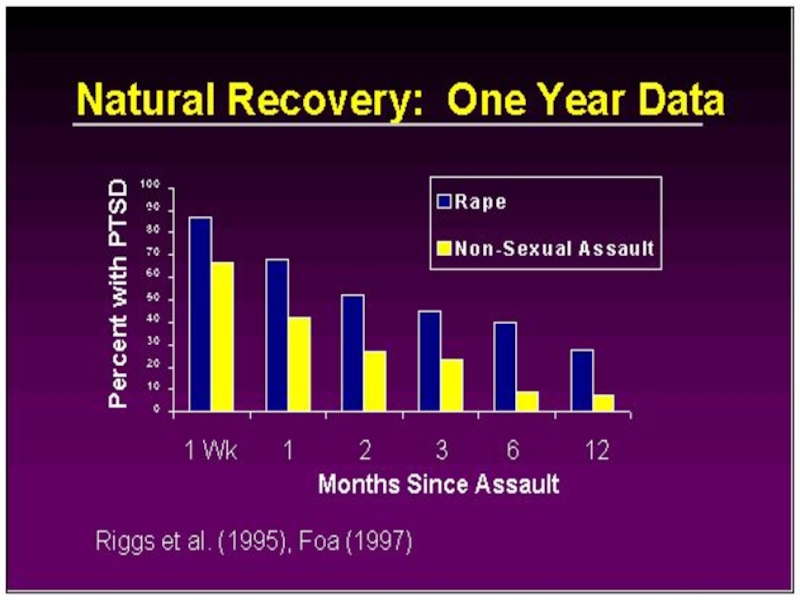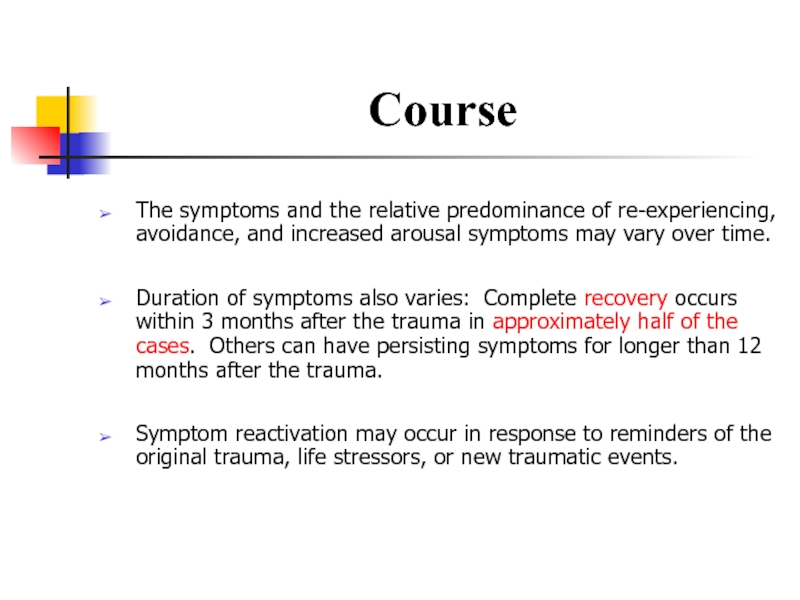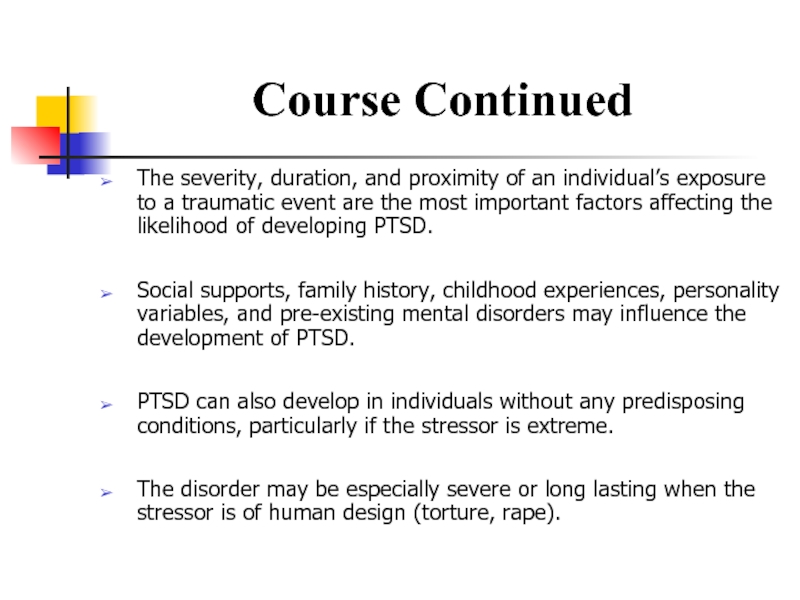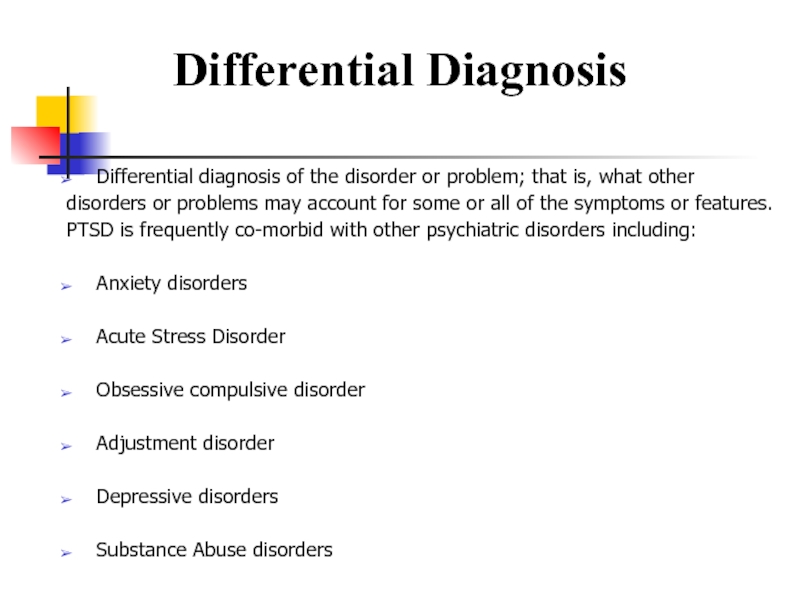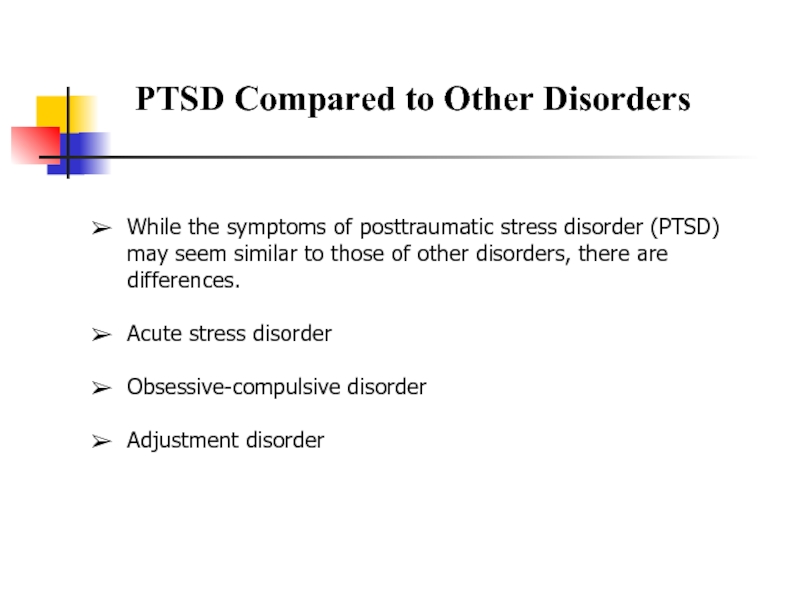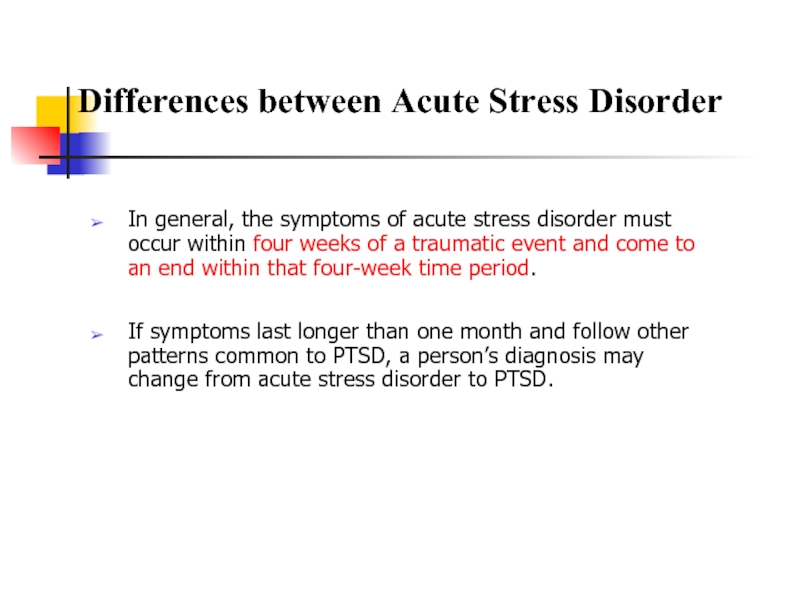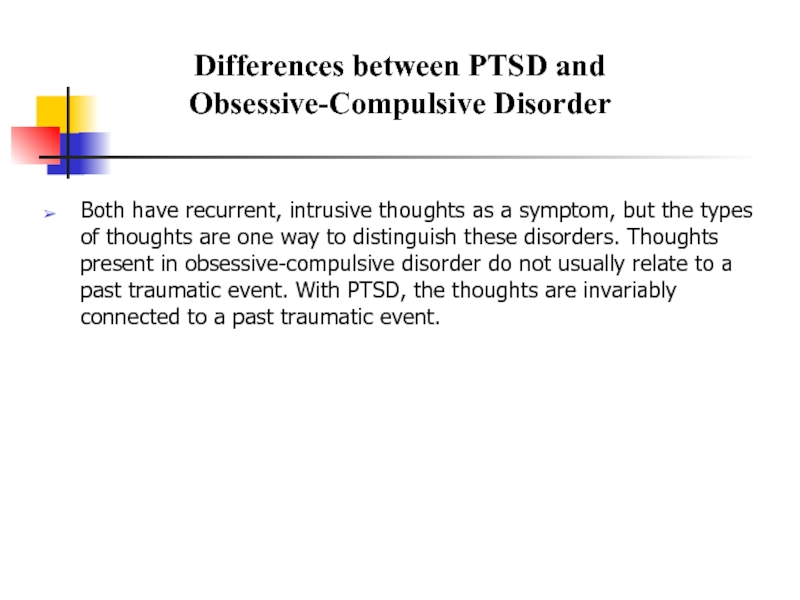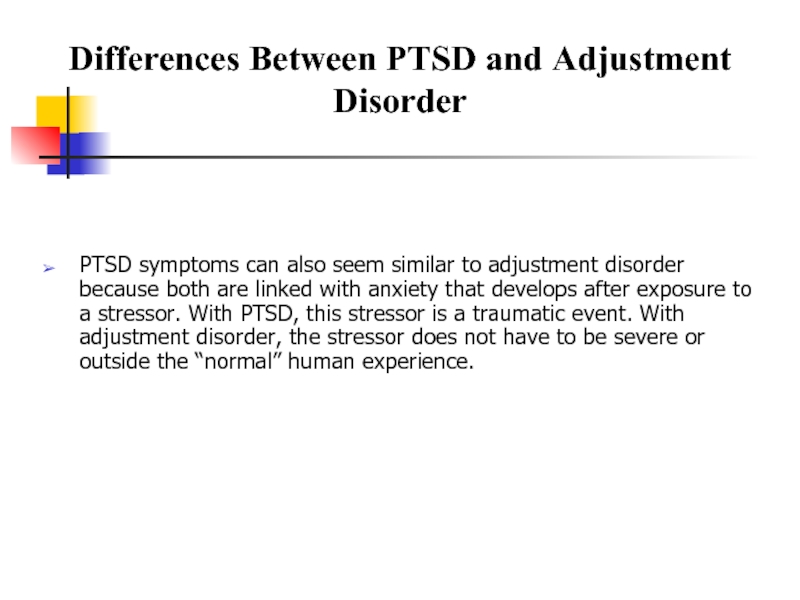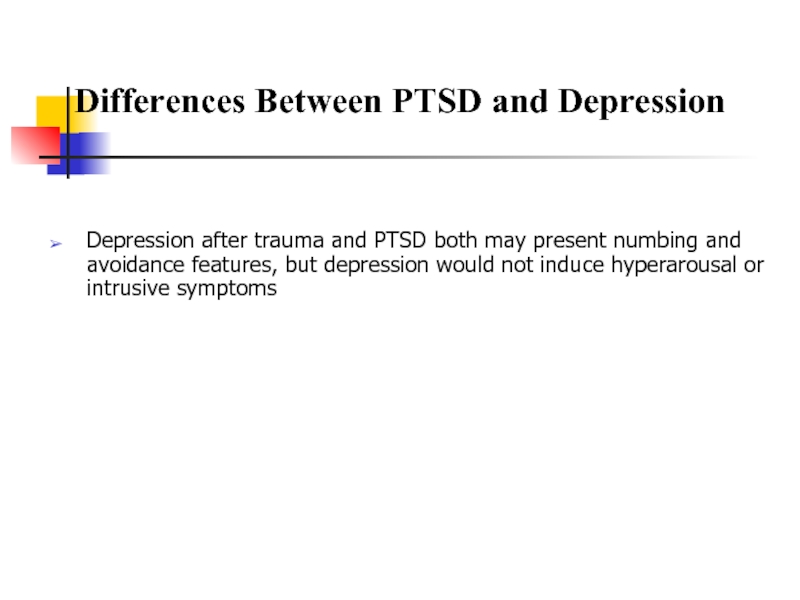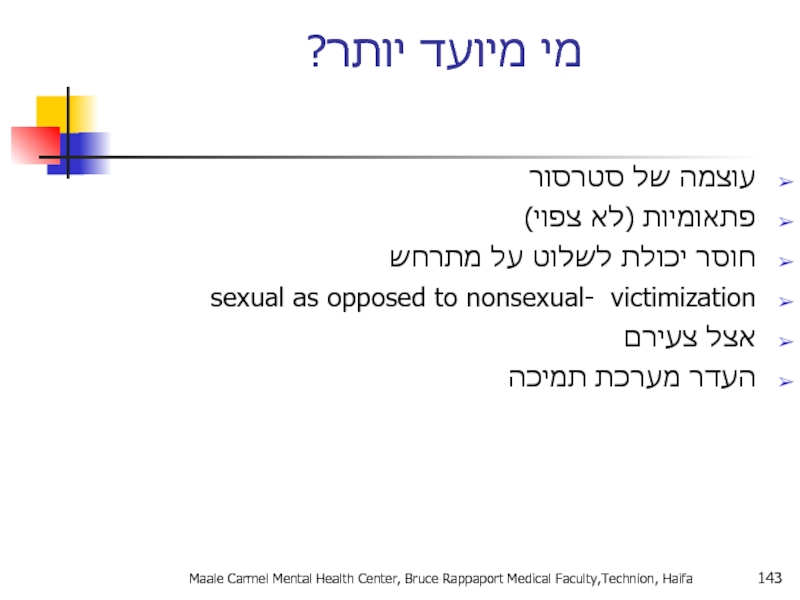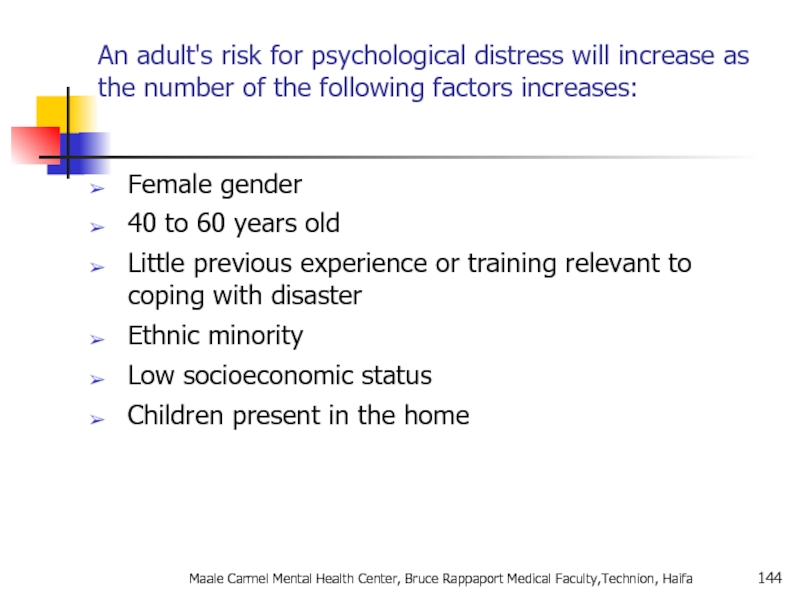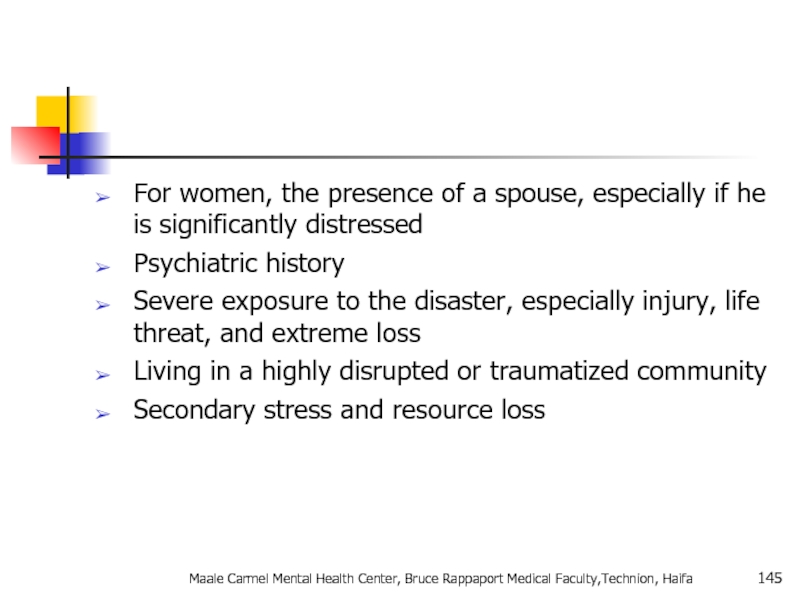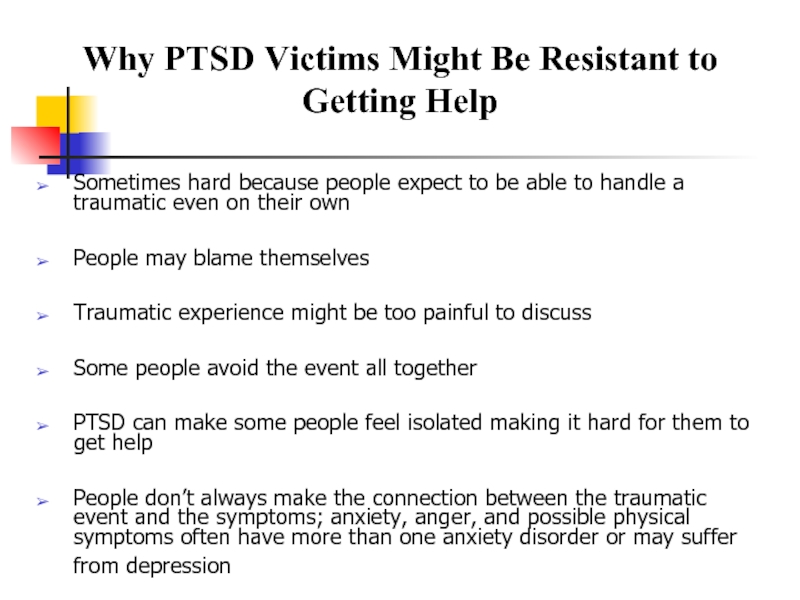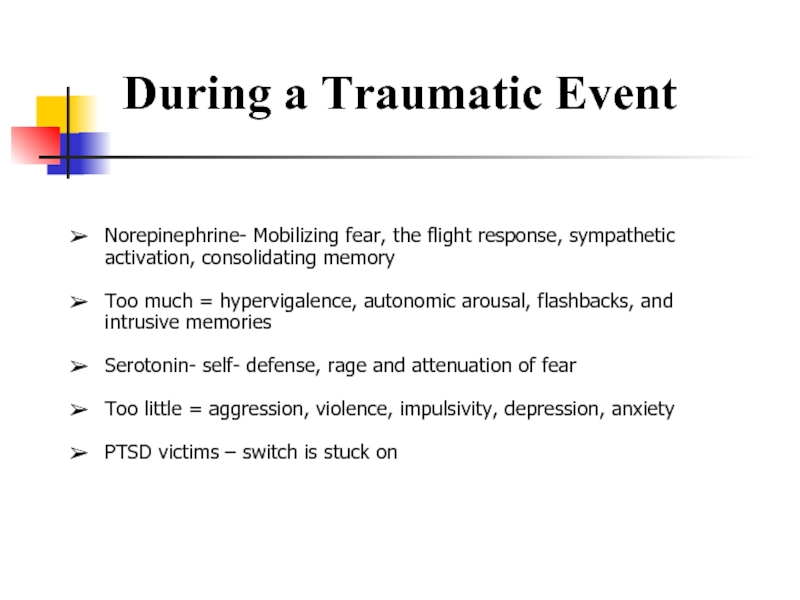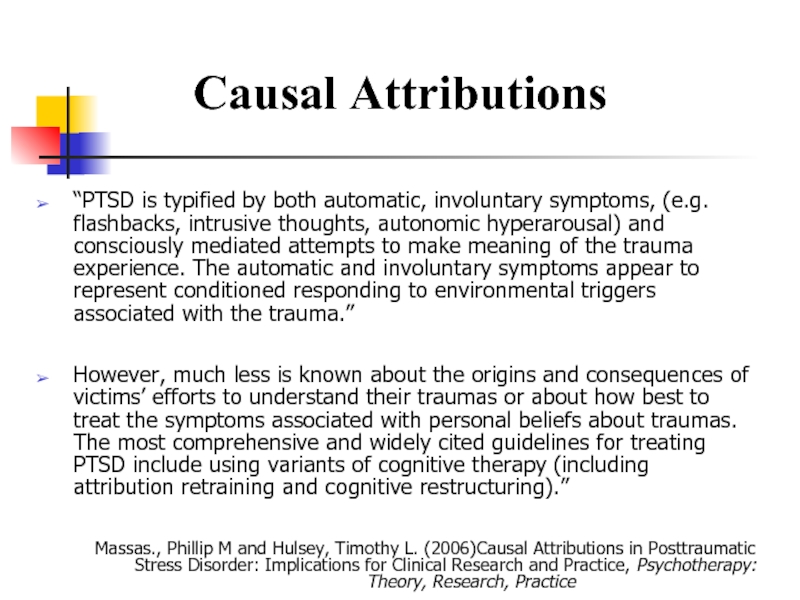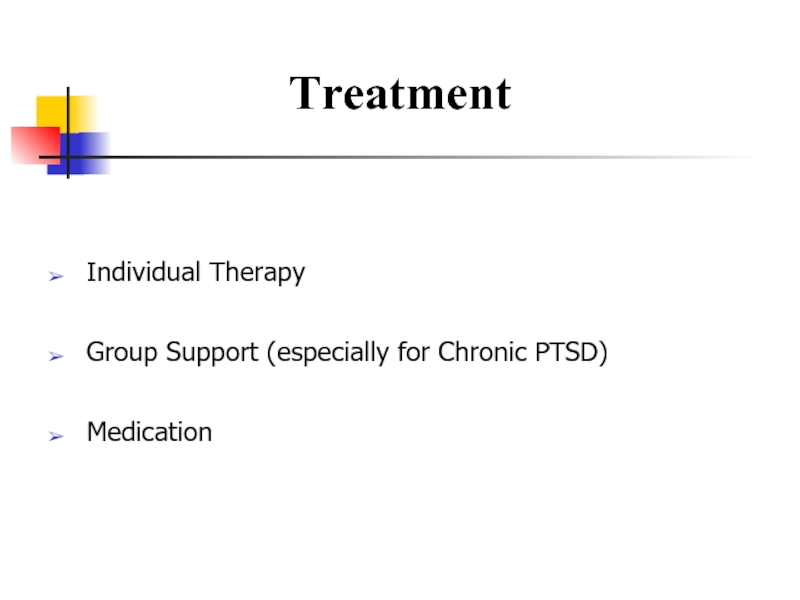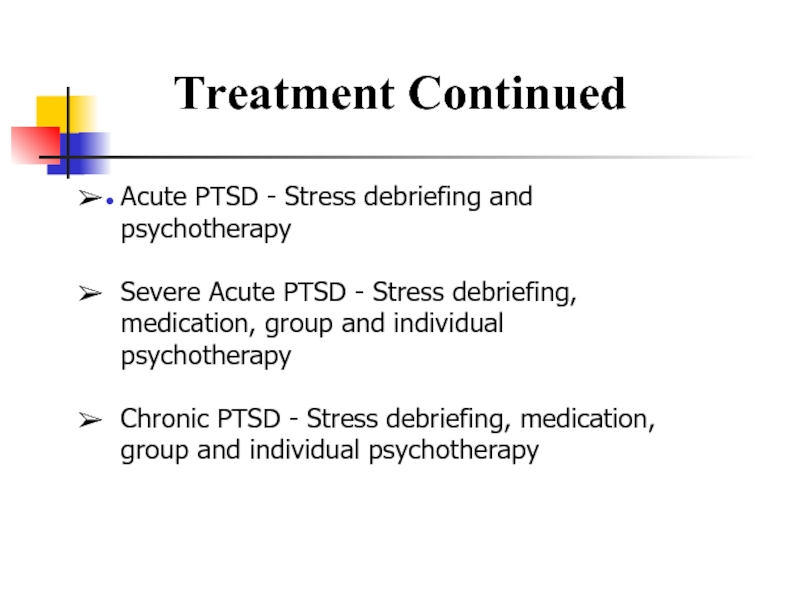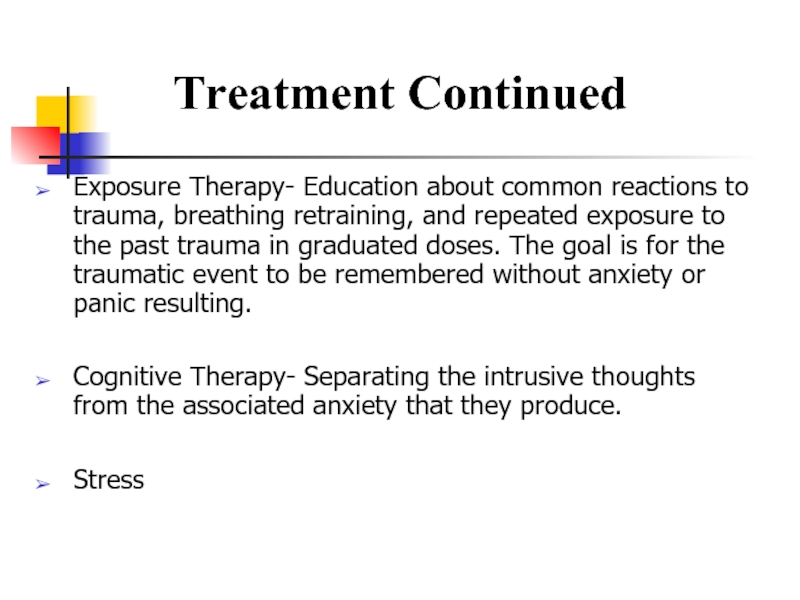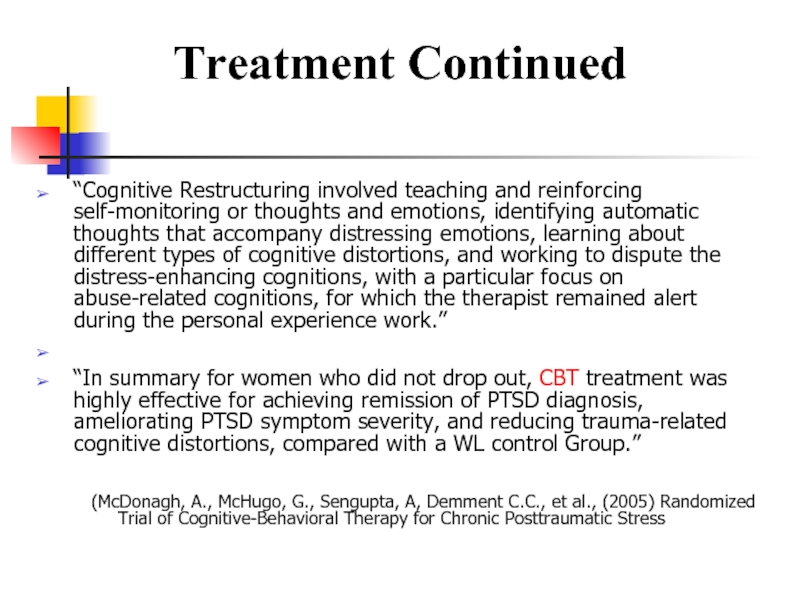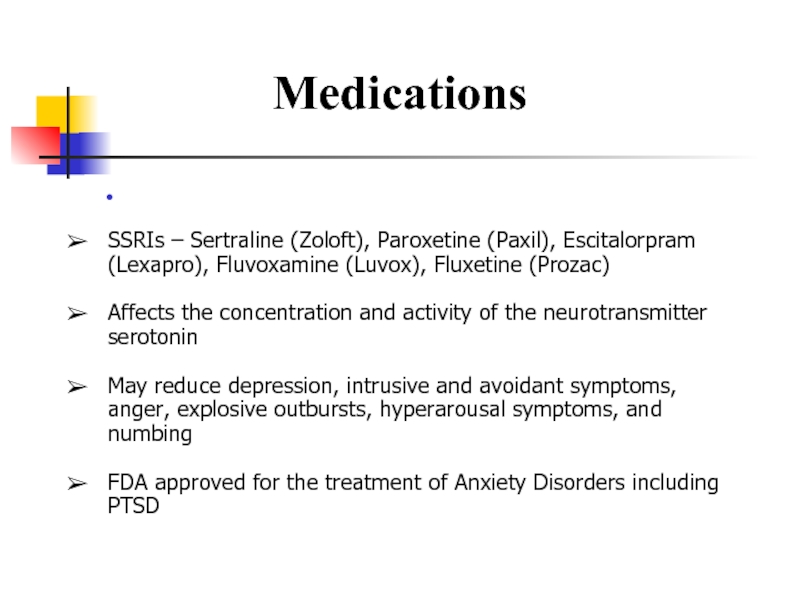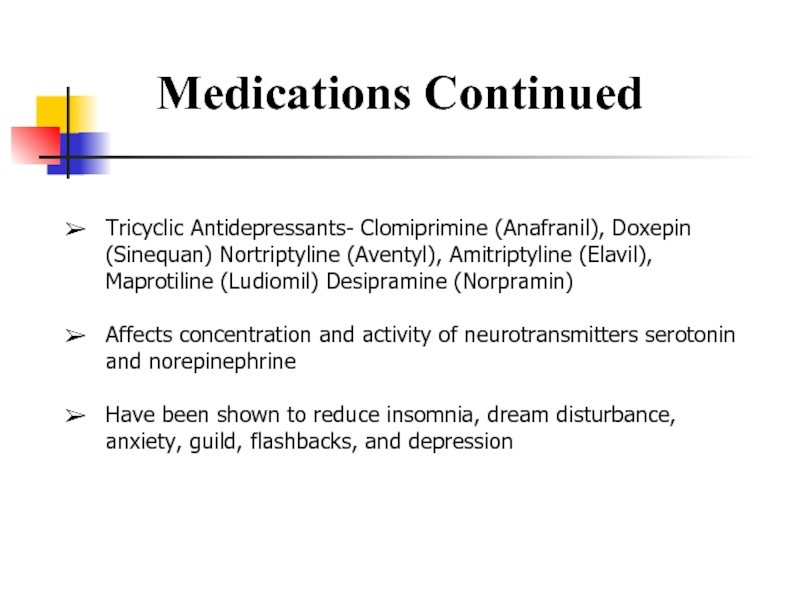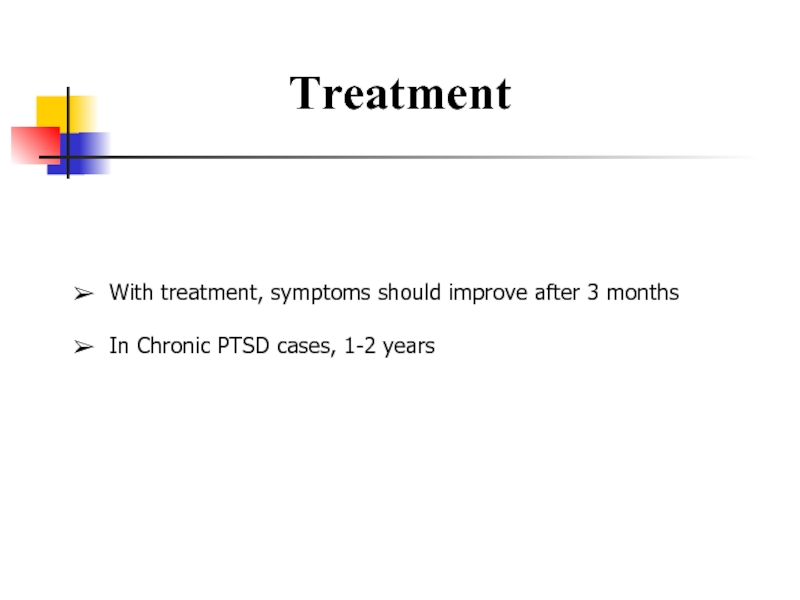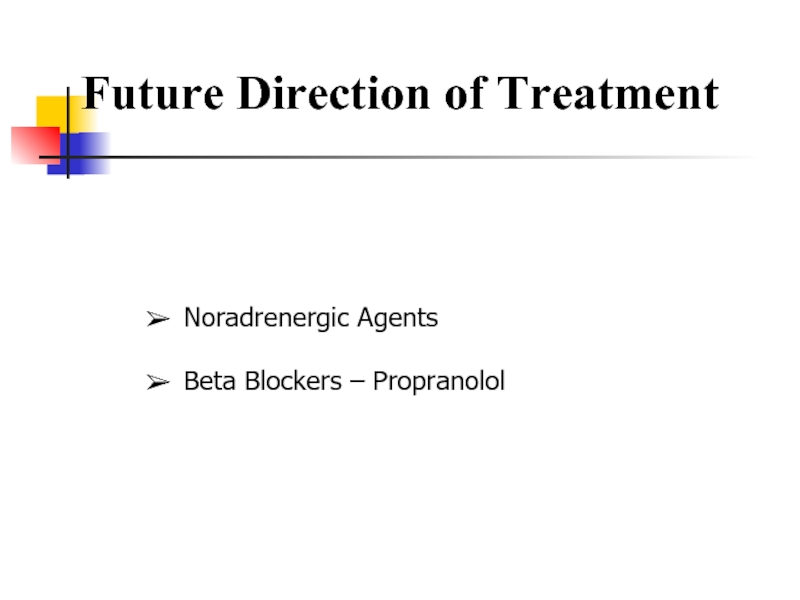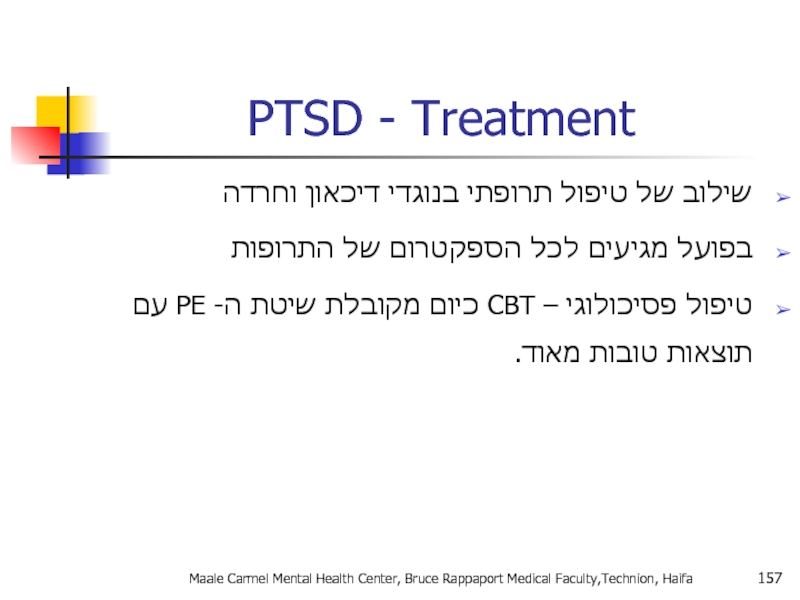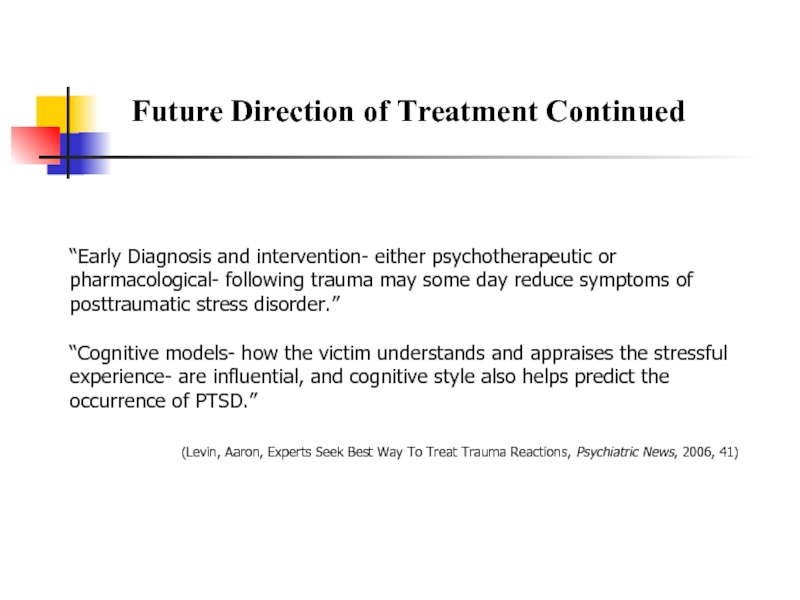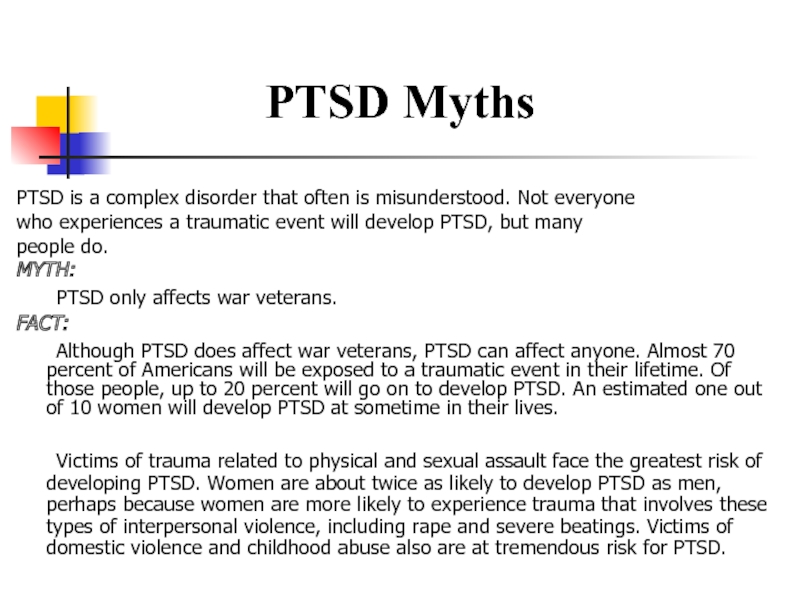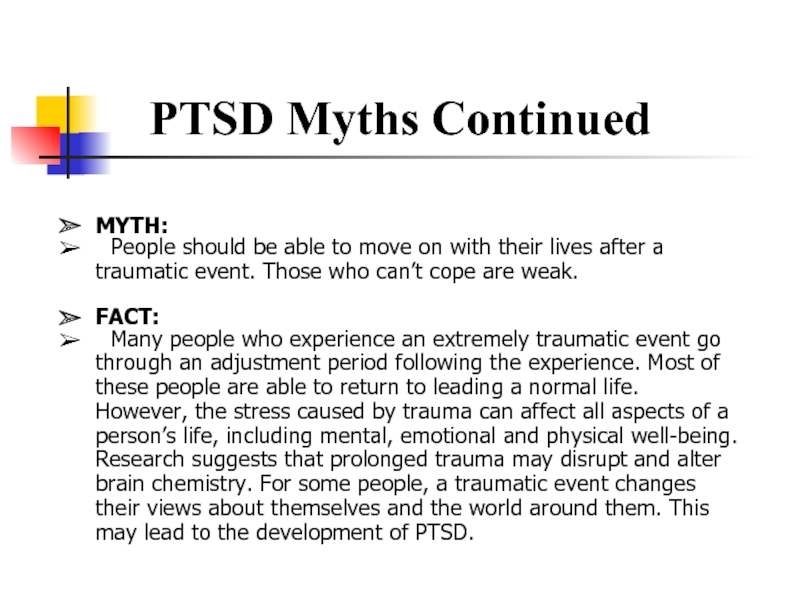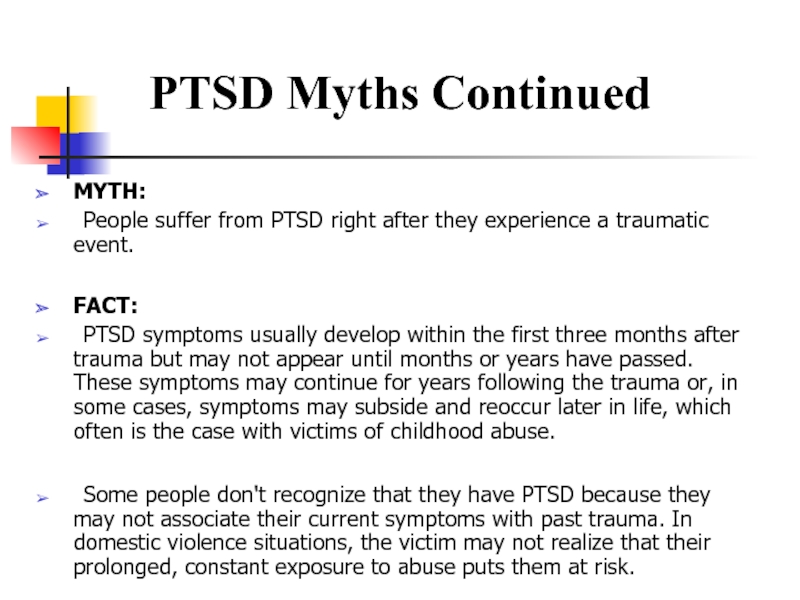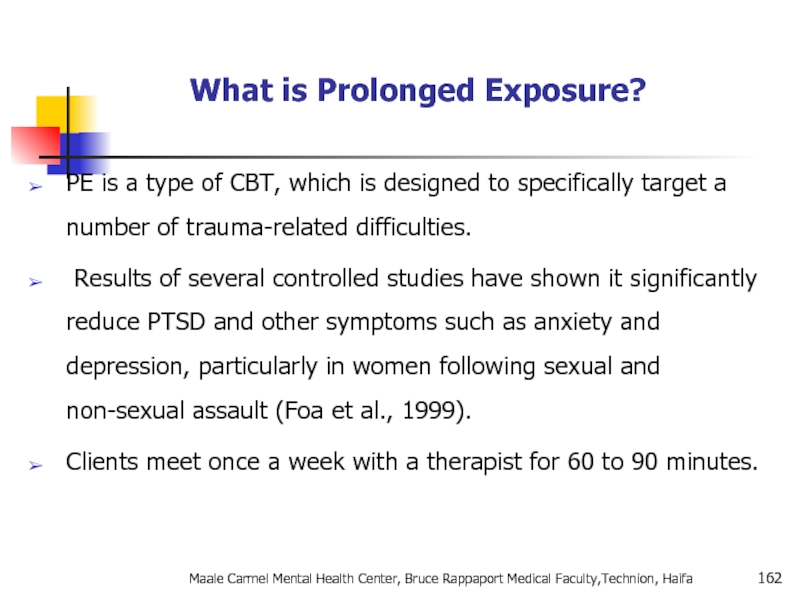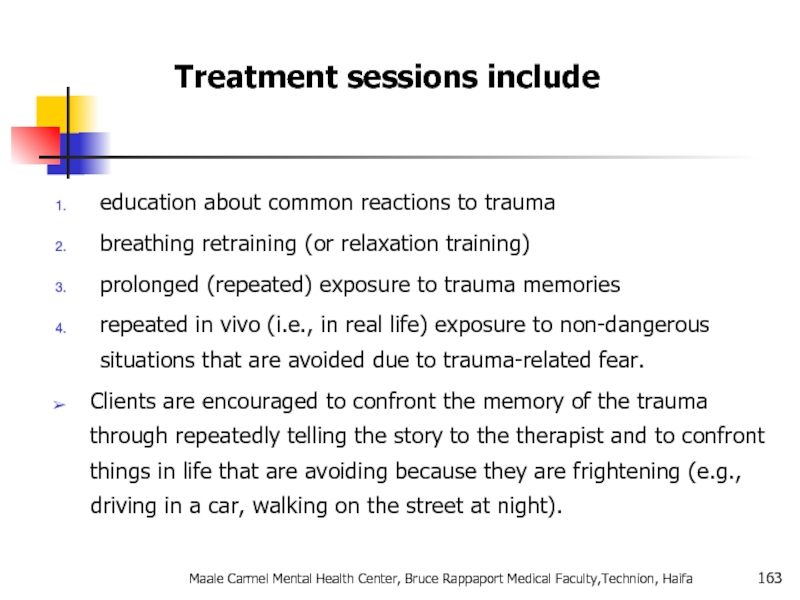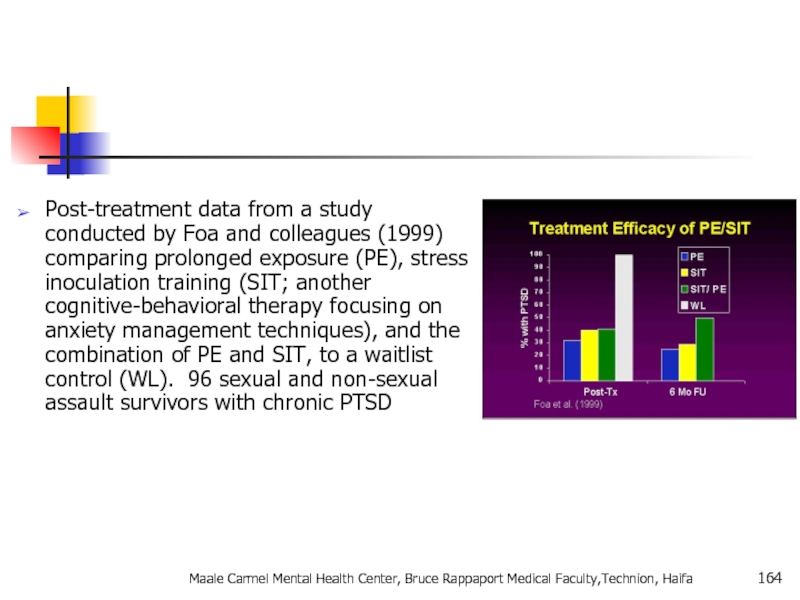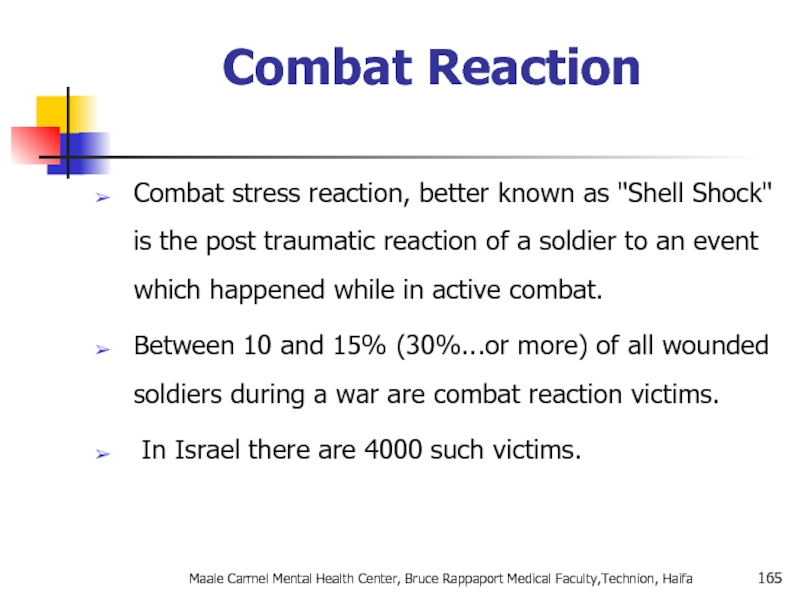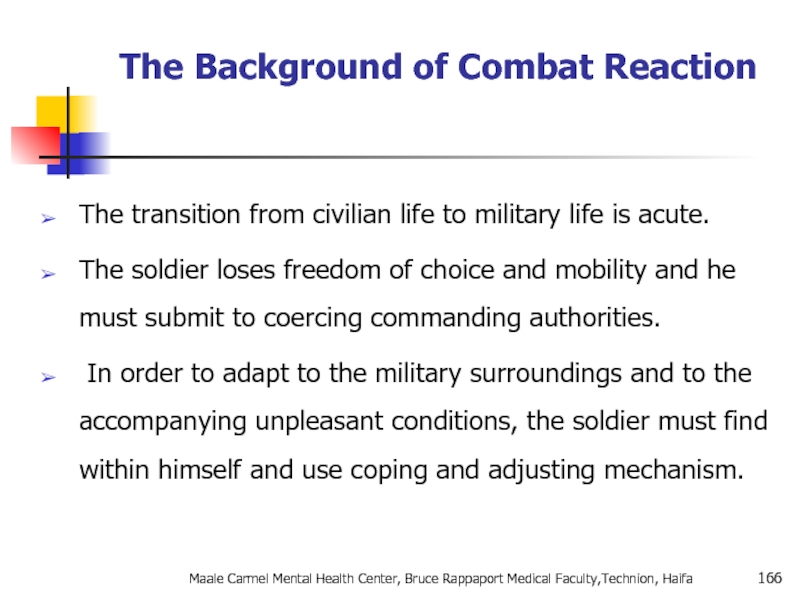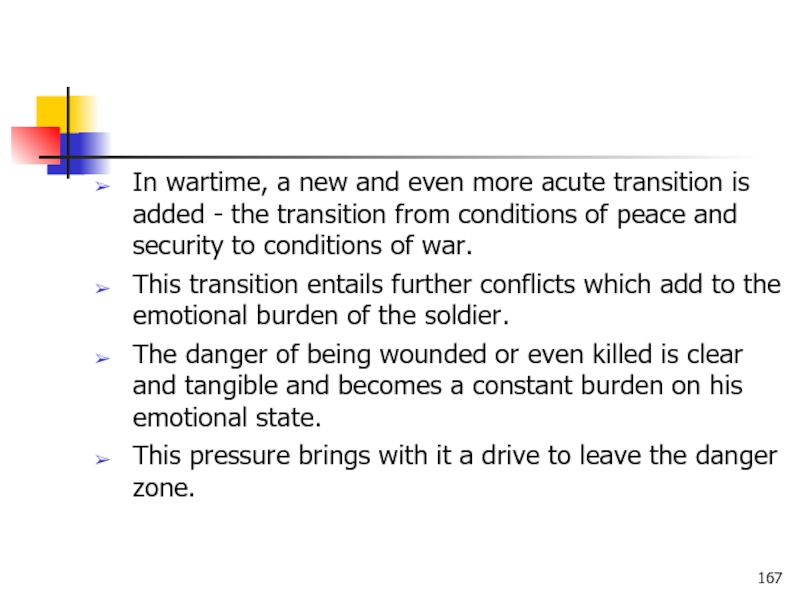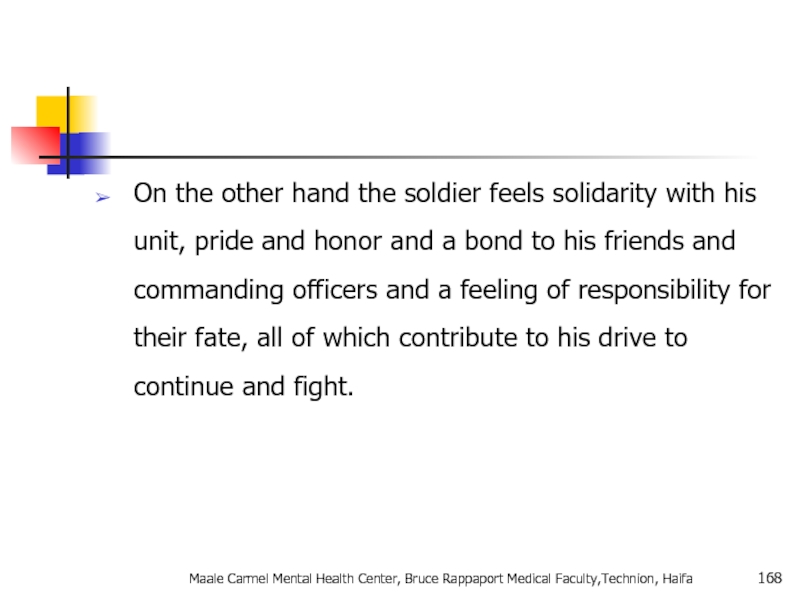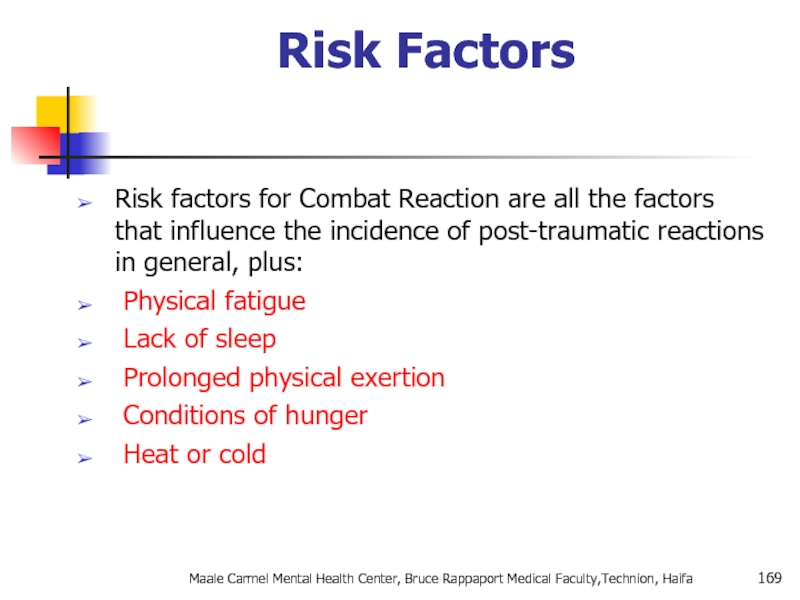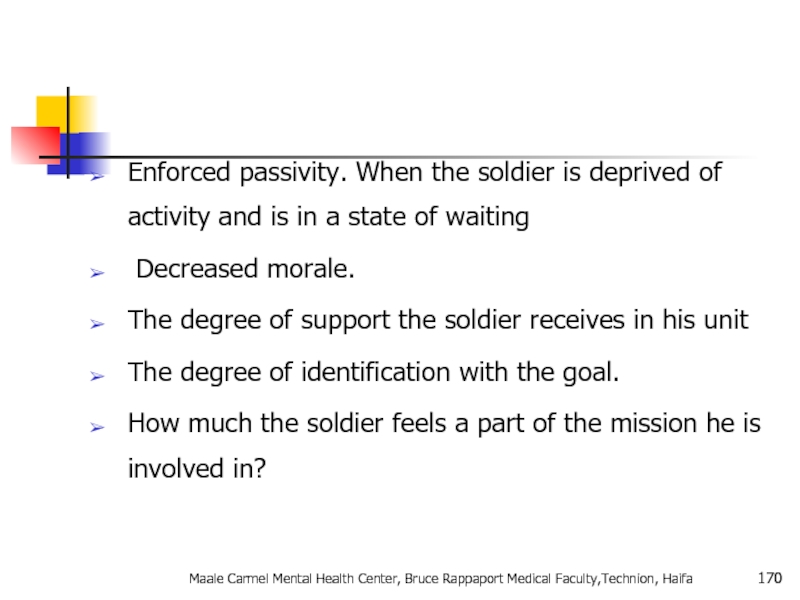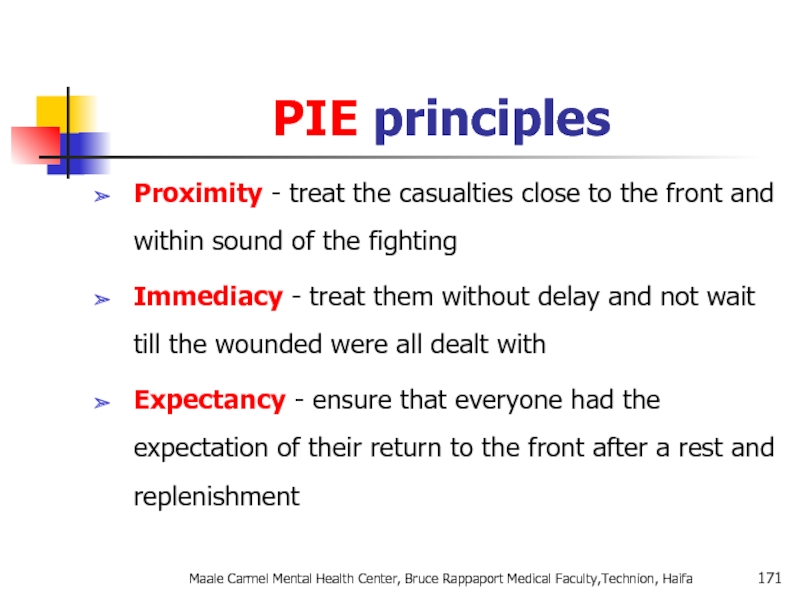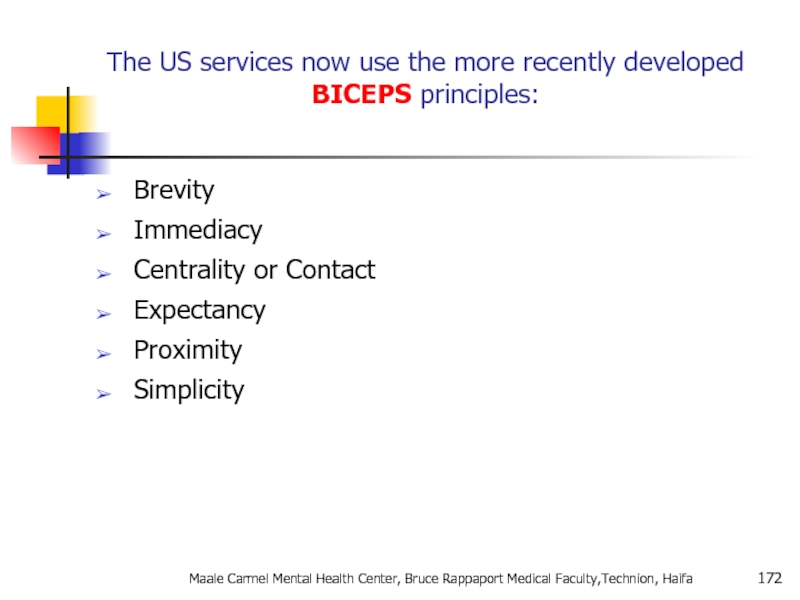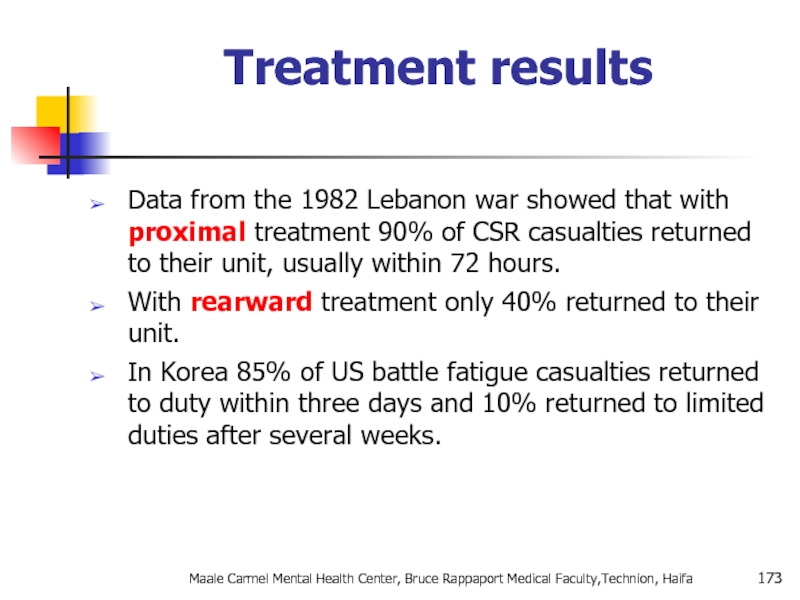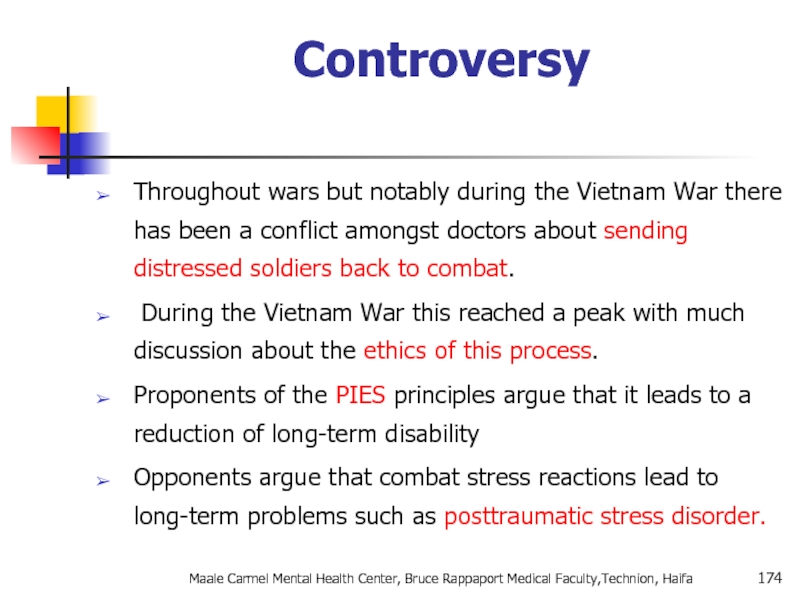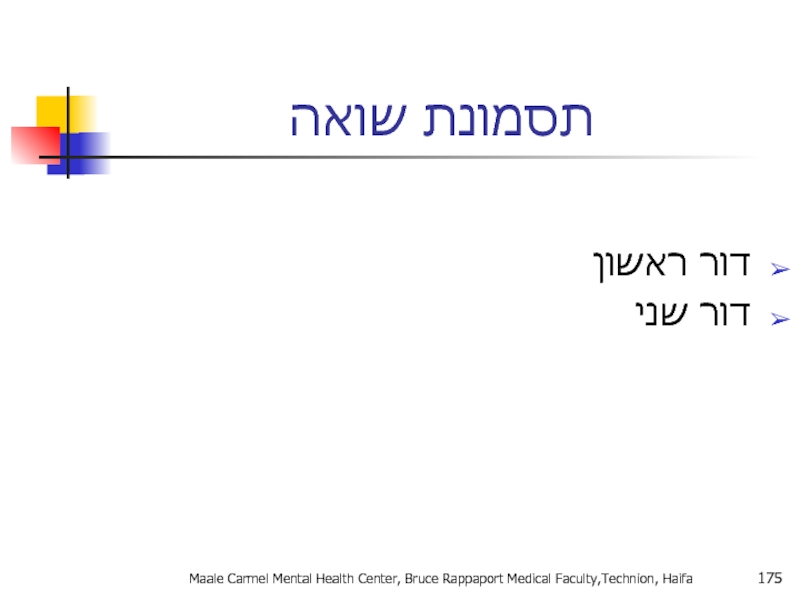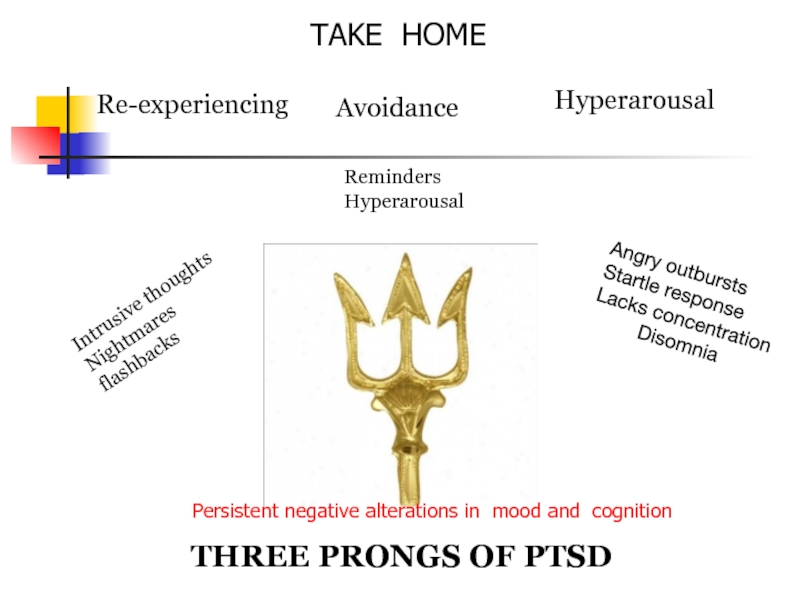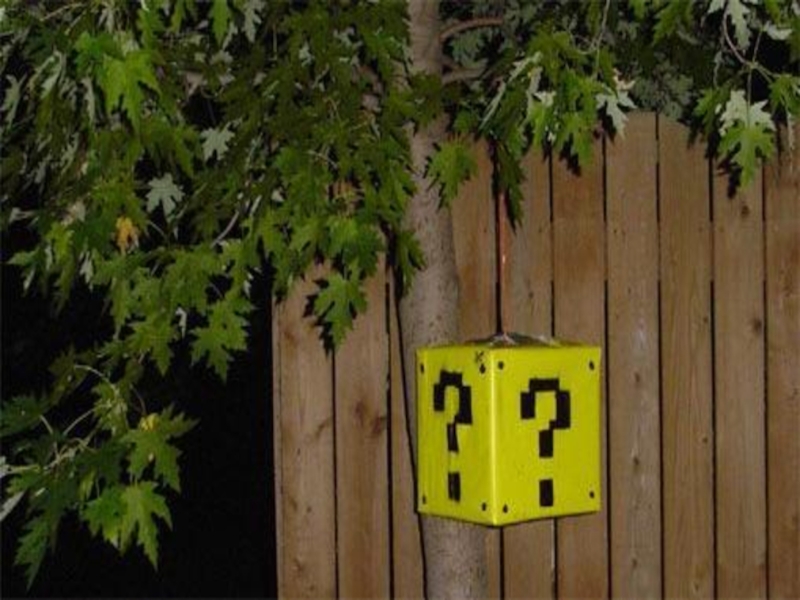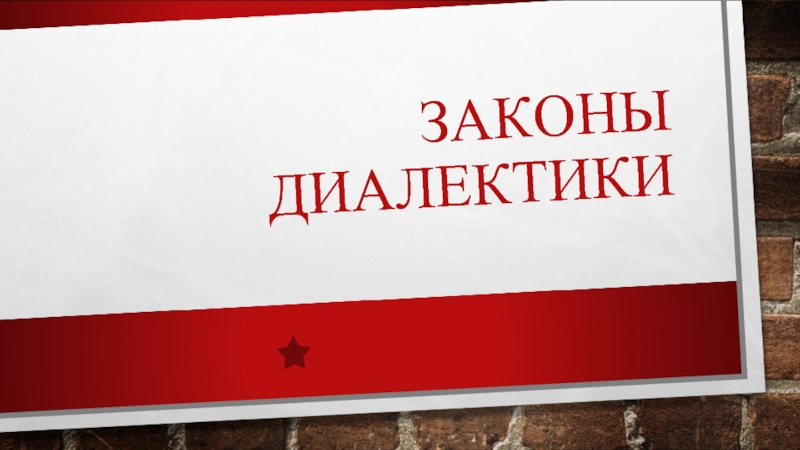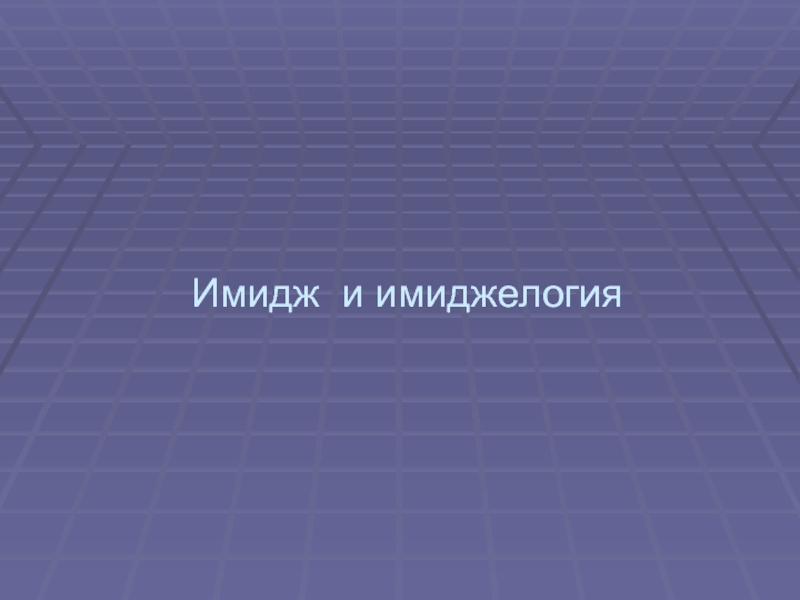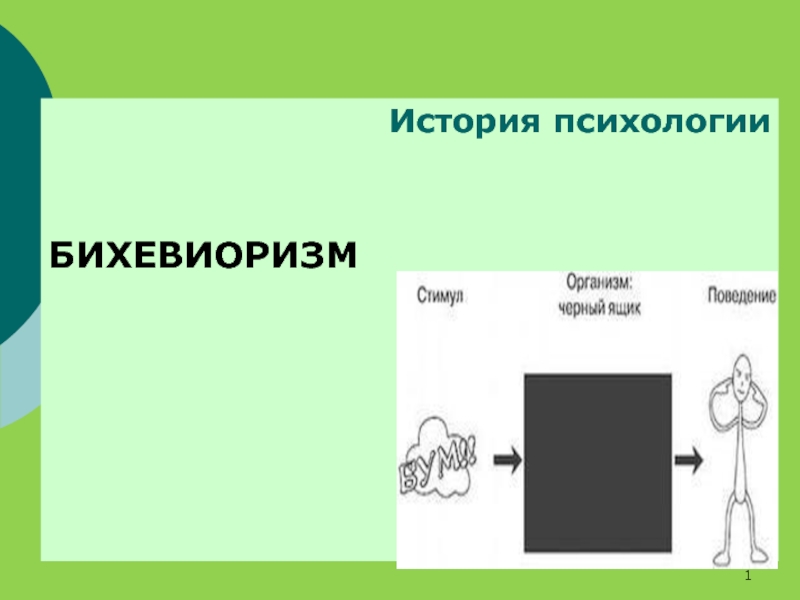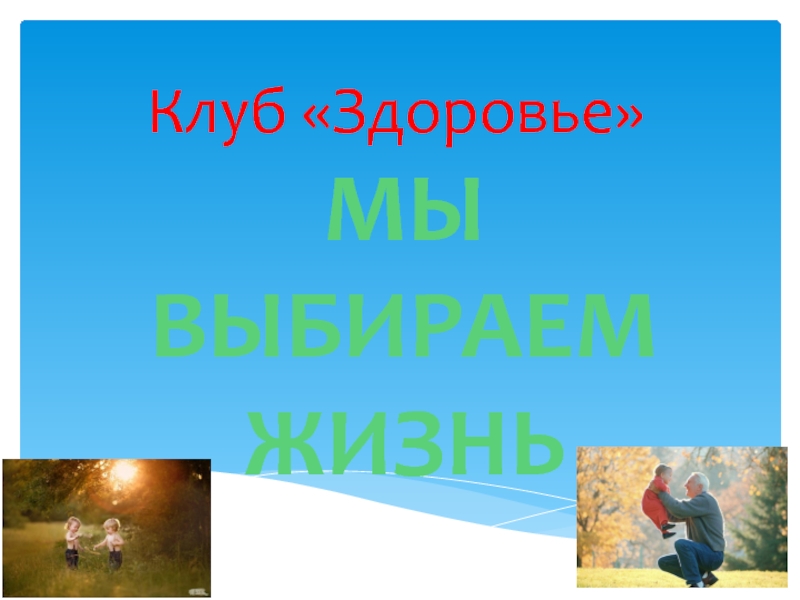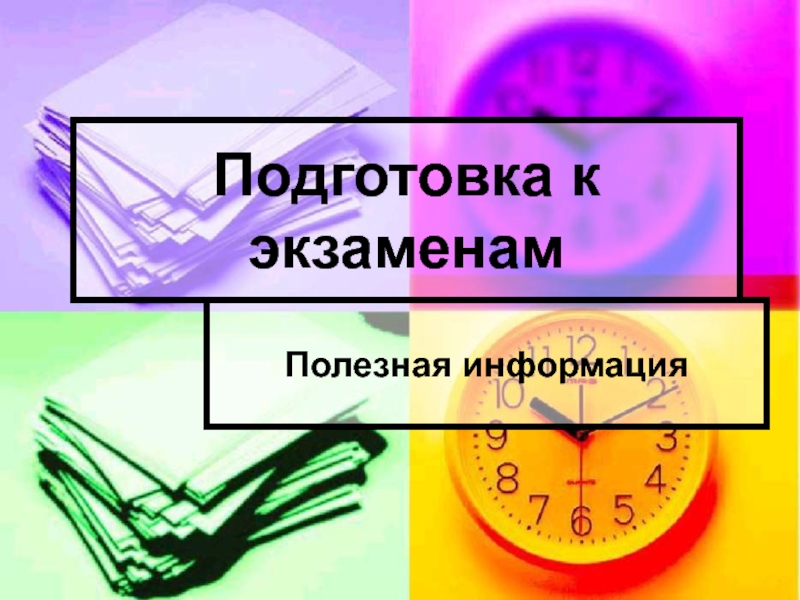- Главная
- Разное
- Дизайн
- Бизнес и предпринимательство
- Аналитика
- Образование
- Развлечения
- Красота и здоровье
- Финансы
- Государство
- Путешествия
- Спорт
- Недвижимость
- Армия
- Графика
- Культурология
- Еда и кулинария
- Лингвистика
- Английский язык
- Астрономия
- Алгебра
- Биология
- География
- Детские презентации
- Информатика
- История
- Литература
- Маркетинг
- Математика
- Медицина
- Менеджмент
- Музыка
- МХК
- Немецкий язык
- ОБЖ
- Обществознание
- Окружающий мир
- Педагогика
- Русский язык
- Технология
- Физика
- Философия
- Химия
- Шаблоны, картинки для презентаций
- Экология
- Экономика
- Юриспруденция
Anxiety Disorders презентация
Содержание
- 1. Anxiety Disorders
- 2. חרדה- הגדרה מצב בעל ביטויים פיזיים, קוגניטיביים
- 3. Определение понятия Тревога Это душевное состояние ,
- 4. Maale Carmel Mental Health Center, Bruce Rappaport
- 5. Tirat Carmel Mental Health Center, Bruce Rappaport Medical Faculty,Technion, Haifa
- 6. תפקידה החיובי של חרדה מוכנות- אנו נוטים
- 7. Что хорошего в Тревоге? Готовность –
- 8. Benefits of anxiety Закон Давидсона:
- 9. General considerations for anxiety disorders Often have
- 10. The differential diagnosis of anxiety. Psychiatric and
- 11. What characteristics of primary anxiety disorders predict
- 12. Anxiety disorders Specific phobia Social anxiety
- 13. הבסיס הביולוגי של חרדה מבנים מעורבים: קורטקס
- 14. Биологическая база Тревоги Замешанные структуры: Логбные доли
- 15. חרדה- מודלים ביולוגיים אמנם המחקר העכשווי מתמקד
- 16. אריק קנדל, חתן פרס נובל לרפואה/פיזיולוגיה לשנת
- 17. האפליזיה קליפורניקה, רכיכת ים בעלת מערכת
- 18. נגיעה בסיפון של האפליזיה גורמת לרתיעה נגיעה
- 19. נגיעה בחישני מגע נקלטת ב SN ה
- 20. תגובת דחק Fight or Flight תגובה פיזיולוגית
- 21. Fight or Flight Физиологическая реакция на стресс
- 22. מה קורה בתגובה הסימפתטית? מתרחשת על
- 23. Что происходи при реакции симпатической системы? Происходит
- 24. Maale Carmel Mental Health Center, Bruce Rappaport Medical Faculty,Technion, Haifa
- 25. Maale Carmel Mental Health Center, Bruce Rappaport
- 26. Sigmund Freud דחפים מיניים ואגרסיביים מסולקים מעל
- 27. A Developmental Hierarchy of Anxiety Superego
- 28. Tirat Carmel Mental Health Center, Bruce Rappaport Medical Faculty,Technion, Haifa
- 29. Tirat Carmel Mental Health Center, Bruce Rappaport Medical Faculty,Technion, Haifa
- 30. Tirat Carmel Mental Health Center, Bruce Rappaport Medical Faculty,Technion, Haifa
- 31. Tirat Carmel Mental Health Center, Bruce Rappaport Medical Faculty,Technion, Haifa
- 32. Tirat Carmel Mental Health Center, Bruce Rappaport Medical Faculty,Technion, Haifa
- 33. אהרון בק: "בבסיס כל פסיכופתולוגיה עומדת הכללת
- 34. А. Барак: "В основе любой патологии лежит
- 35. Pathological Anxiety כחלק מהפרעת הסתגלות כחלק ממחלה
- 36. Pathological Anxiety Как часть патологической адаптивной реакции
- 37. Primary Anxiety Disorders הפרעות חרדה לא פוביות:
- 38. Primary Anxiety Disorders Нефобические тревожные реакции: GENERAILIZED
- 39. אפידמיולוגיה ברוב המקרים נשים סובלות יותר, במיוחד
- 40. Эпидемиология В большинстве своем женщины страдают чаще
- 41. Kessler et al. Arch Gen Psychiatry. 1995;52:1048.
- 42. Genetic Epidemiology of Anxiety Disorders There is
- 43. Anxiety Disorders “The anxiety must be out
- 44. Agoraphobia , Specific Phobia, and
- 45. Panic Attacks and Agoraphobia are “unlinked” in
- 46. Specific Phobia Maale Carmel Mental Health Center, Bruce Rappaport Medical Faculty,Technion, Haifa
- 47. Animal Type Natural Environment Type (e.g.,
- 48. Specific Phobia Marked or persistent fear (>6
- 49. SPECIFIC PHOBIA בשאר הזמן תפקוד
- 50. SOCIAL PHOBIA בדומה לפוביה פשוטה
- 51. Incidence of social anxiety disorders and the
- 52. אבחנה יותר בעייתית (הפרעת אישיות?? ) שני
- 53. What is going on in their brains??
- 54. What is going on in their brains??
- 55. What is going on in their brains??
- 56. Functional imaging studies in SAD Several studies
- 57. Social Anxiety Disorder treatment Social skills
- 58. סיבוכים: דיכאון שימוש בחומרים ממכרים Maale Carmel
- 59. PANIC DISORDER התקף אימה, חרדה
- 60. Panic Disorder Recurrent unexpected panic attacks and
- 61. A Panic Attack is: Palpitations or
- 62. Panic disorder epidemiology 2-3% of general population;
- 63. Things to keep in mind A panic
- 64. With Agoraphobia פחד או המנעות להיות במקומות
- 65. טיפול: שילוב של טיפול CBT ותרופות: נוגדי
- 66. Panic Disorder Comorbidity 50-60% have lifetime major
- 67. Panic Disorder Etiology Drug/Alcohol Genetics Social learning
- 68. Treatment See 70% or better treatment response
- 69. Agoraphobia Marked fear or anxiety for more
- 70. Agoraphobia The individual fears or avoids these
- 71. Prevalence 2% of the population Females to
- 72. Generalized Anxiety פחד או חרדה מוגזמים, ללא
- 73. Generalized Anxiety Disorder Excessive worry more days
- 74. GAD Comorbidity 90% have at least one
- 75. Long-Term Treatment Of GAD Need to treat
- 76. Maale Carmel Mental Health Center, Bruce Rappaport Medical Faculty,Technion, Haifa AGORAPHOBIA
- 77. Tirat Carmel Mental Health Center, Bruce Rappaport Medical Faculty,Technion, Haifa
- 78. Pharmacotherapy for Anxiety Disorders Antidepressants Serotonin
- 79. Benzodiazepines
- 80. Discontinuation of Treatment for Anxiety Disorders
- 81. Strategies for Anxiolytic Discontinuation Slow taper Switch
- 82. Strategies for Refractory Anxiety Disorder Maximize dose
- 83. Strategies for Refractory Anxiety Disorders Augmentation
- 84. סיכום: Maale Carmel Mental Health Center, Bruce Rappaport Medical Faculty,Technion, Haifa AGORAPHOBIA
- 85. Screening questions How ever experienced a panic
- 86. Take home points Anxiety, Obsessive-Compulsive and Related,
- 87. Tirat Carmel Mental Health Center, Bruce Rappaport Medical Faculty,Technion, Haifa Question
- 89. Trauma- and Stressor-Related Disorders New chapter in
- 90. Disinhibited Social Engagement Disorder “The essential
- 91. A. PTSD A Criterion B. No mandatory
- 92. Adjustment Disorders are redefined as an
- 93. Chronic Adjustment Disorder Omitted by mistake from
- 94. Other Specified Trauma/Stressor-Related Disorder (309.89) AD with
- 95. Reactive Attachment Disorder Emotionally withdrawn behavior Social/emotional
- 96. Persistent Complex Bereavement Disorder Onset > 12
- 97. Persistent Complex Bereavement Disorder (PCBD) Diagnostic Criteria-ICD
- 98. Persistent Complex Bereavement Disorder (PCBD) Preoccupation with
- 99. Reactive Distress to the Death Marked
- 100. Social/Identity Disruption A desire to die
- 101. Specify if: With Traumatic Bereavement: Following
- 102. Tirat Carmel Mental Health Center, Bruce Rappaport Medical Faculty,Technion, Haifa
- 103. Changes in PTSD Criteria Four symptom
- 104. Changes in PTSD Criteria DSM-5 more
- 105. Changes in PTSD Criteria Recognition of
- 106. DSM-5: PTSD Criterion A A. The
- 107. Criterion A (continued): 3. Indirectly, by learning
- 108. CRITERION B - Intrusion (5 Sx –
- 109. C. Persistent effortful avoidance of distressing trauma-related
- 110. CRITERION D – negative alterations in cognition
- 111. CRITERION E – Trauma-related alterations in arousal
- 112. PTSD Criteria for DSM-5 F.
- 113. Preschool Subtype: 6 Years or Younger Relative
- 114. A. In children (younger than 6 years),
- 115. DSM-5: Preschool PTSD Criterion B B. Presence
- 116. Preschool PTSD Criterion C One or more
- 117. Preschool PTSD Criterion E E. Alterations in
- 118. Preschool PTSD for DSM-5 F. Duration (of
- 119. Summary: PTSD in DSM-5 Perhaps PTSD should
- 120. Dissociative Subtype of PTSD New subtype for
- 121. specifiers Specify whether: With dissociative symptoms: The
- 122. CAPS Clinician Administered PTSD Scale National Center
- 123. 1. (B1) Recurrent, involuntary, and intrusive distressing
- 124. PCL Posttraumatic Check List National Center for
- 125. TRS Trauma Recovery Scale Gentry, 1996 Developed
- 126. Early Sessions Graphic Time Line of life
- 127. PTSD Epidemiology 7-9% of general population 60-80%
- 128. PTSD Epidemiology בין אבחנות בודדות ב DSM
- 129. Comorbidities Depression Other anxiety disorders Substance use
- 130. Acute PTSD - symptoms less than three
- 131. Can occur at any age, including childhood,
- 132. Onset Symptoms usually begin within the first
- 133. Tirat Carmel Mental Health Center, Bruce Rappaport Medical Faculty,Technion, Haifa
- 134. Course The symptoms and the relative predominance
- 135. Course Continued The severity, duration, and proximity
- 136. Rape (49%) Severe beating or physical
- 137. Differential Diagnosis Differential diagnosis of the disorder
- 138. While the symptoms of posttraumatic stress
- 139. Differences between Acute Stress Disorder In general,
- 140. Differences between PTSD and Obsessive-Compulsive Disorder Both
- 141. Differences Between PTSD and Adjustment Disorder PTSD
- 142. Differences Between PTSD and Depression Depression after
- 143. מי מיועד יותר? עוצמה של סטרסור פתאומיות
- 144. An adult's risk for psychological distress will
- 145. For women, the presence of a spouse,
- 146. Why PTSD Victims Might Be Resistant to
- 147. During a Traumatic Event Norepinephrine- Mobilizing
- 148. Causal Attributions “PTSD is typified by both
- 149. Treatment Individual Therapy Group Support (especially for Chronic PTSD) Medication
- 150. Treatment Continued For PTSD in children, adolescents,
- 151. Treatment Continued Exposure Therapy- Education about common
- 152. Treatment Continued “Cognitive Restructuring involved teaching and
- 153. Medications approved for the treatment of Anxiety
- 154. Tricyclic Antidepressants- Clomiprimine (Anafranil), Doxepin (Sinequan)
- 155. Treatment With treatment, symptoms should
- 156. Noradrenergic Agents Beta
- 157. PTSD - Treatment שילוב של טיפול תרופתי
- 158. Future Direction of Treatment Continued “Early
- 159. PTSD Myths PTSD is a complex disorder
- 160. PTSD Myths Continued MYTH: People should
- 161. PTSD Myths Continued MYTH: People suffer from
- 162. What is Prolonged Exposure? PE is a
- 163. education about common reactions to
- 164. Post-treatment data from a study conducted by
- 165. Combat Reaction Combat stress reaction, better
- 166. The Background of Combat Reaction The
- 167. In wartime, a new and even more
- 168. On the other hand the soldier feels
- 169. Risk Factors Risk factors for Combat
- 170. Enforced passivity. When the soldier is deprived
- 171. PIE principles Proximity - treat the casualties
- 172. The US services now use the more
- 173. Treatment results Data from the 1982 Lebanon
- 174. Controversy Throughout wars but notably during
- 175. תסמונת שואה דור ראשון דור שני Maale
- 176. Re-experiencing Intrusive thoughts Nightmares flashbacks Avoidance Hyperarousal
- 177. Tirat Carmel Mental Health Center, Bruce Rappaport Medical Faculty,Technion, Haifa
Слайд 1Anxiety Disorders
Prof. Anatoly Kreinin
Maale Carmel Mental Health Center, Bruce Rappaport
Слайд 2חרדה- הגדרה
מצב בעל ביטויים פיזיים, קוגניטיביים ורגשיים הגורמים לחווה אותם לתחושה
פיזיים:הזעת יתר, פלפיטציות, חנק, סחרחורת, טשטוש, יציאות מוגברות, מתן שתן מוגבר
נפשיים: הופעה של רגש בעל גוון שלילי, דיספורי רגזוני; אי נוחות), עם אלמנטים של דכדוך(
קוגניטיביים: דאגה מפני תוצאה שלילית
Maale Carmel Mental Health Center, Bruce Rappaport Medical Faculty,Technion, Haifa
Слайд 3Определение понятия Тревога
Это душевное состояние , характеризующееся психологическими, физиологическими и когнитивными
Физиологический компонент – пальпитации, пот, удушье, головокружение, расплывчатое зрение, учащенные мочеиспускание и дефекация,
Психологический компонент – неприятное чувство дисфории, ощущение дискомфорта, сниженное настроение
Когниция – мысли о том, что должно случиться что-то неприятьное, страшное
Слайд 4Maale Carmel Mental Health Center, Bruce Rappaport Medical Faculty,Technion, Haifa
Не
Патологическая Тревога
Существует и при отсутствии стрессора
Выраженность реакции не соответствует триггеру
Продолжается и после исчезновения триггера
Нарушается функционирование
Нормальная Тревога
Есть стрессор
Выраженность реакция соответствует триггеру
Проходит при отсутствии триггера
Нет нарушения функционирования
Слайд 6תפקידה החיובי של חרדה
מוכנות- אנו נוטים להגיב יותר לאיומים המוכרים לנו
לא מפתחים חרדה בתגובה לעלים, פרחים, מים רדודים
לא כתגובה ראשונית לאיומים מודרנים (רובים.. .)
Maale Carmel Mental Health Center, Bruce Rappaport Medical Faculty,Technion, Haifa
Слайд 7 Что хорошего в Тревоге?
Готовность – мы легко реагируем на угрозы,
Нет тревоги на цветы, листья, лужу..
Нет первичной тревоги на современные угрозы – ружье, машина, кирпич…
Слайд 8Benefits of anxiety
Закон Давидсона:
Функционирование улучшается с усилением тревоги до определенного уровня,
Maale Carmel Mental Health Center, Bruce Rappaport Medical Faculty,Technion, Haifa
Слайд 9General considerations for anxiety disorders
Often have an early onset- teens or
Show 2:1 female predominance
Have a waxing and waning course over lifetime
Similar to major depression and chronic diseases such as diabetes in functional impairment and decreased quality of life
Maale Carmel Mental Health Center, Bruce Rappaport Medical Faculty,Technion, Haifa
Слайд 10The differential diagnosis of anxiety. Psychiatric and Medical disorders. Psychiatr Clin
Primary versus Secondary Anxiety
Anxiety may be due to one of the primary anxiety disorders OR secondary to substance abuse (Substance-Induced Anxiety Disorder), a medical condition (Anxiety Disorder Due to a General Medical Condition), another psychiatric condition, or psychosocial stressors (Adjustment Disorder with Anxiety)
Maale Carmel Mental Health Center, Bruce Rappaport Medical Faculty,Technion, Haifa
Слайд 11What characteristics of primary anxiety disorders predict subsequent major depressive disorder.
Comorbid diagnoses
Once an anxiety disorder is diagnoses it is critical to screen for other psychiatric diagnoses since it is very common for other diagnoses to be present and this can impact both treatment and prognosis.
Maale Carmel Mental Health Center, Bruce Rappaport Medical Faculty,Technion, Haifa
Слайд 12Anxiety disorders
Specific phobia
Social anxiety disorder (SAD)
Panic disorder (PD)
Agoraphobia
Generalized anxiety disorder
Anxiety Disorder due to a General Medical Condition
Substance-Induced Anxiety Disorder
Anxiety Disorder NOS
Maale Carmel Mental Health Center, Bruce Rappaport Medical Faculty,Technion, Haifa
Слайд 13הבסיס הביולוגי של חרדה
מבנים מעורבים:
קורטקס פרונטלי
מערכת לימבית
היפוטלמוס, היפוקמפוס אמיגדלה
גזע המוח
ההיפופיזה
Adrenal Axis
המערכת
Maale Carmel Mental Health Center, Bruce Rappaport Medical Faculty,Technion, Haifa
Слайд 14Биологическая база Тревоги
Замешанные структуры:
Логбные доли
Лимьическая система
Гипоталамус, Гипокампус Амигдала
Ствол мога
Гипофиз
Adrenal Axis
Симпатическая система
Maale
Слайд 15חרדה- מודלים ביולוגיים
אמנם המחקר העכשווי מתמקד במבנים אנטומיים כגון האמיגדלה, ההיפוקמפוס
תגובות התניית פחד ורתיעה קיימות ביצורים נחותים בהרבה וללא מבנים אלו.
Maale Carmel Mental Health Center, Bruce Rappaport Medical Faculty,Technion, Haifa
Слайд 16אריק קנדל, חתן פרס נובל לרפואה/פיזיולוגיה לשנת 2000
Maale Carmel Mental Health
Слайд 17
האפליזיה קליפורניקה, רכיכת ים בעלת מערכת עצבים פרימיטיבית המורכבת מ- 20,000
Maale Carmel Mental Health Center, Bruce Rappaport Medical Faculty,Technion, Haifa
Слайд 18נגיעה בסיפון של האפליזיה גורמת לרתיעה
נגיעה חוזרת בסיפון של האפליזיה מפחיתה
מתן גירוי חזק (חשמל) בשלב זה יוצר סנסיטיזציה וגורם לרתיעה בתגובה לגירוי שהיה תת-ספי קודם לכן
בנוסף, ניתן ליצור תגובה של האפליזיה לגירוי מותנה, בדומה לבע"ח מפותחים יותר
Maale Carmel Mental Health Center, Bruce Rappaport Medical Faculty,Technion, Haifa
Слайд 19נגיעה בחישני מגע נקלטת ב SN
ה SN מעורר תגובה מוטורית ב
הביטואציה= ירידה בכמות Ca שמשתחררת בסינפסה ופחות תגובה מוטורית
סנסיטיזציה גורמת ל INTלשחרר סרוטונין הנצמד לרצפטורים סרוטונרגיים ב SN המעוררים, דרך cAMP שיפעיל רצפטור Ca נוסף, S-shaped) ) המגביר כניסת קלציום ומוטוריקה.
Maale Carmel Mental Health Center, Bruce Rappaport Medical Faculty,Technion, Haifa
Слайд 20תגובת דחק
Fight or Flight
תגובה פיזיולוגית לדחק
מווסתת דרך ההיפותלמוס ומבנים נוספים
מאפשרת להתגונן
קיימת בכל בעלי החיים (מהבחינה הזו אנחנו עדיין בעל חיים)...
"תגובה סימפתטית"
Maale Carmel Mental Health Center, Bruce Rappaport Medical Faculty,Technion, Haifa
Слайд 21Fight or Flight
Физиологическая реакция на стресс
Адаптируется с помощью гипоталамуса и других
Позволяет адекватно реагировать на угрозу
Существует у всех живых организмов, в этом отношении мы - животные
« Симатическая реакция»
Maale Carmel Mental Health Center, Bruce Rappaport Medical Faculty,Technion, Haifa
Слайд 22מה קורה בתגובה הסימפתטית?
מתרחשת על ידי אדרנלין ונוראדרנלין
מעלה קצב לב
קצב נשימה מוגבר
הזעה
עליה בניצול גלוקוזה
הפניית דם לשרירים
עליה במתח השרירים
קרישת דם משתפרת
Maale Carmel Mental Health Center, Bruce Rappaport Medical Faculty,Technion, Haifa
Слайд 23Что происходи при реакции симпатической системы?
Происходит с помошью адреналина и норадреналина
Усиливает
Ускоряется частота дыхания
Усиливается потоотделение
Усиливается утилизация глюкозы
Перераспределение крови к мышцам
Увеличение напряжения в мышцах
Улучшение свёртываемости крови
Maale Carmel Mental Health Center, Bruce Rappaport Medical Faculty,Technion, Haifa
Слайд 25Maale Carmel Mental Health Center, Bruce Rappaport Medical Faculty,Technion, Haifa
Pierre
לכל אדם יש כבאנטום מובנה של אנרגיה נפשית ובמצב תקין אין פעילות מנטאלית תת הכרתית
אירועים טראומטיים שוחקים את האגו והוא עובר דגנרציה, מאבד את יכולתו לנווט את האדם בעולם ומביא אותו למצב של חוסר אונים פסיבי
Слайд 26Sigmund Freud
דחפים מיניים ואגרסיביים מסולקים מעל פני השטח בגלל מוסכמות ואיסורים
הפריד בין פסיכונוירוזות לבין anxiety בה ראה תופעה כמעט פיזיולוגית לחלוטין
בניגוד ל Janet האגו אצל פרויד מהווה מרכיב חשוב בהתפתחות הפרעות חרדה (פסיכונוירוזות).
Maale Carmel Mental Health Center, Bruce Rappaport Medical Faculty,Technion, Haifa
Слайд 27A Developmental Hierarchy of Anxiety
Superego anxiety
Castration anxiety
Fear of
Separation anxiety (fear of the loss of the object—Kleinian depressive anxiety)
Persecutory anxiety (Klein)
Disintegration anxiety (Kohut)
Maale Carmel Mental Health Center, Bruce Rappaport Medical Faculty,Technion, Haifa
Слайд 33אהרון בק:
"בבסיס כל פסיכופתולוגיה עומדת הכללת יתר"
דיכאון
אופוריה, מאניה
פאראנויה
הפרעת חרדה
עצבות
שמחה
חשד
חרדה
Maale Carmel
Слайд 34А. Барак:
"В основе любой патологии лежит чрезмерное и необоснованное обобщение»
Депрессия
Мания, эйфория
Паранойя
Паника
Сниженое
Радость
Подозрение
Тревога
Maale Carmel Mental Health Center, Bruce Rappaport Medical Faculty,Technion, Haifa
Слайд 35Pathological Anxiety
כחלק מהפרעת הסתגלות
כחלק ממחלה / הפרעה נפשית אחרת
הפרעת חרדה ראשונית
Maale
Слайд 36Pathological Anxiety
Как часть патологической адаптивной реакции
Часть другого патологического расстройства
Первичная патологическая
Maale Carmel Mental Health Center, Bruce Rappaport Medical Faculty,Technion, Haifa
Слайд 37Primary Anxiety Disorders
הפרעות חרדה לא פוביות:
GENERAILIZED ANXIETY DISORDER
OCD
הפרעות חרדה פוביות:
SIMPLE PHOBIA
SOCIAL
PANIC DISORDER
Maale Carmel Mental Health Center, Bruce Rappaport Medical Faculty,Technion, Haifa
Слайд 38Primary Anxiety Disorders
Нефобические тревожные реакции:
GENERAILIZED ANXIETY DISORDER
Фобические тревожные реакии:
SIMPLE PHOBIA
SOCIAL PHOBIA
PANIC
Maale Carmel Mental Health Center, Bruce Rappaport Medical Faculty,Technion, Haifa
Слайд 39אפידמיולוגיה
ברוב המקרים נשים סובלות יותר, במיוחד בגילים בין 16 ל –
פחד קהל פי 2 יותר אצל נשים, גברים מחפשים עזרה יותר מנשים.
Maale Carmel Mental Health Center, Bruce Rappaport Medical Faculty,Technion, Haifa
Слайд 40Эпидемиология
В большинстве своем женщины страдают чаще мужчин, в основном в возрасте
Социофобия в 2 раза чаще у женщин, но мужчины ищут помощь чаще.
Maale Carmel Mental Health Center, Bruce Rappaport Medical Faculty,Technion, Haifa
Слайд 41Kessler et al. Arch Gen Psychiatry. 1995;52:1048.
Kessler et al. Arch Gen
Prevalence of Anxiety Disorders
(life time prevalence %)
Maale Carmel Mental Health Center, Bruce Rappaport Medical Faculty,Technion, Haifa
Слайд 42Genetic Epidemiology of Anxiety Disorders
There is significant familial aggregation for PD,
Twin studies found heritability of 0.43 for panic disorder and 0.32 for GAD.
Hetteman J. et al. A Review and Meta-Analysis of the Genetic Epidemiology of Anxiety disorders. Am J Psychiatry 2001;158:1568-1575
Maale Carmel Mental Health Center, Bruce Rappaport Medical Faculty,Technion, Haifa
Слайд 43Anxiety Disorders
“The anxiety must be out of proportion to the actual
This chapter no longer includes OCD and PTSD
DSM 5 creates new chapters for OCD and PTSD
Chapter is arranged developmentally.
Sequenced by age of onset
Now includes Separation Anxiety and Selective Mutism
Слайд 44Agoraphobia ,
Specific Phobia, and
Social Anxiety Disorder
Changes in criteria
Clients over 18 do not have to recognize that their anxiety is excessive or unreasonable
Duration of 6 months or longer is required for all ages
Anxiety Disorders
Слайд 45Panic Attacks and Agoraphobia are “unlinked” in DSM- 5
DSM- IV
Panic Attacks replaced in DSM-5 with the terms
“expected” or “unexpected” panic attack
Social Anxiety Disorder :
“Generalized” specifier in DSM-IV has been deleted
Replaced with “performance only” specifier
Anxiety Disorders
Слайд 46Specific Phobia
Maale Carmel Mental Health Center, Bruce Rappaport Medical Faculty,Technion, Haifa
Слайд 47Animal Type
Natural Environment Type (e.g., heights, storms, water)
Blood-Injection-Injury Type
Situational Type (e.g., airplanes, elevators, enclosed places)
Other Type
SPECIFIC PHOBIA
Maale Carmel Mental Health Center, Bruce Rappaport Medical Faculty,Technion, Haifa
Слайд 48Specific Phobia
Marked or persistent fear (>6 months) that is excessive or
Anxiety must be out of proportion to the actual danger or situation
It interferes significantly with the persons routine or function
Maale Carmel Mental Health Center, Bruce Rappaport Medical Faculty,Technion, Haifa
Слайд 49
SPECIFIC PHOBIA
בשאר הזמן תפקוד נורמאלי
המנעות מאפשרת חיים נורמאליים
שכיחות גבוהה –עד 20%
בד"כ לא פונים לטיפול
בד"כ ללא סיבוכים
טיפול ב CBT יעיל מאוד, לא זקוקים לתרופות.
Maale Carmel Mental Health Center, Bruce Rappaport Medical Faculty,Technion, Haifa
Слайд 50
SOCIAL PHOBIA
בדומה לפוביה פשוטה אך כאן הפחד חסר הגיון מאינטראקציה חברתית,
יותר פגיעה תפקודית
יותר אירועי חשיפה
ההימנעות לא מאפשרת חיים נורמליים
התוכן של החרדה- החשש מהשפלה, ביזוי, כישלון וכו'
Maale Carmel Mental Health Center, Bruce Rappaport Medical Faculty,Technion, Haifa
Слайд 51Incidence of social anxiety disorders and the consistent risk for secondary
SAD epidemiology
7% of general population
Age of onset teens; more common in women. Stein found half of SAD patients had onset of sx by age 13 and 90% by age 23.
Causes significant disability
Increased depressive disorders
Maale Carmel Mental Health Center, Bruce Rappaport Medical Faculty,Technion, Haifa
Слайд 52אבחנה יותר בעייתית (הפרעת אישיות?? )
שני סוגים:
LIMITED
PERVASIVE
Maale Carmel Mental Health Center,
Слайд 53What is going on in their brains??
Study of 16 SAD patients
Blair K. Et al. Social Norm Processing in Adult Social Phobia: Atypical Increased Ventromedial Frontal cortex Responsiveness to Unintentional (Embarassing) Transgressions. Am J Psychiatry 2010;167:1526-1532
Maale Carmel Mental Health Center, Bruce Rappaport Medical Faculty,Technion, Haifa
Слайд 54What is going on in their brains??
Both groups ↑ medial
SAD patients however showed a significant response to the unintentional transgression.
SAD subjects also had significant increase activity in the amygdala and insula bilaterally.
Blair K. Et al. Social Norm Processing in Adult Soical Phobia: Atypical Increased Ventromedial Frontal cortex Responsiveness to Unintentional (Embarrasing) Trasgressions. Am J Psychiatry 2010;167:1526-1532
Maale Carmel Mental Health Center, Bruce Rappaport Medical Faculty,Technion, Haifa
Слайд 55What is going on in their brains??
Blair K. Et al. Social
Слайд 56Functional imaging studies in SAD
Several studies have found hyperactivity of the
Successful treatment with either CBT or citalopram showed reduction in activation of amygdala and hippocampus
Furmark T et al. Common changes in cerebral blood flow in patients with social phobia treated with citalpram or cognitive behavior therapy. Arch Gen Psychiatry 2002; 59:425-433
Maale Carmel Mental Health Center, Bruce Rappaport Medical Faculty,Technion, Haifa
Слайд 57Social Anxiety Disorder treatment
Social skills training, behavior therapy, cognitive therapy
Medication –
Maale Carmel Mental Health Center, Bruce Rappaport Medical Faculty,Technion, Haifa
Слайд 58סיבוכים:
דיכאון
שימוש בחומרים ממכרים
Maale Carmel Mental Health Center, Bruce Rappaport Medical Faculty,Technion,
Слайд 59
PANIC DISORDER
התקף אימה, חרדה בעוצמה קיצונית
מופיע ספונטאנית (לפחות בתחילת המחלה)
הכללת אירועים
חרדה מטרימהANTICIPATION ANXIETY -
התפתחות המנעות – אגורפוביה
Maale Carmel Mental Health Center, Bruce Rappaport Medical Faculty,Technion, Haifa
Слайд 60Panic Disorder
Recurrent unexpected panic attacks and for a one month period
Persistent worry about having additional attacks
Worry about the implications of the attacks
Significant change in behavior because of the attacks
Maale Carmel Mental Health Center, Bruce Rappaport Medical Faculty,Technion, Haifa
Слайд 61 A Panic Attack is:
Palpitations or rapid heart rate
Sweating
Trembling or shaking
Shortness
Feeling of choking
Chest pain or discomfort
Nausea
Chills or heat sensations
Paresthesias
Feeling dizzy or faint
Derealization or depersonalization
Fear of losing control or going crazy
Fear of dying
A discrete period of intense fear in which 4 of the following
Symptoms abruptly develop and peak within 10 minutes:
Maale Carmel Mental Health Center, Bruce Rappaport Medical Faculty,Technion, Haifa
Слайд 62Panic disorder epidemiology
2-3% of general population; 5-10% of primary care patients.Onset
Female:male 2-3:1
Maale Carmel Mental Health Center, Bruce Rappaport Medical Faculty,Technion, Haifa
Слайд 63Things to keep in mind
A panic attack ≠ panic disorder
Panic disorder
Maale Carmel Mental Health Center, Bruce Rappaport Medical Faculty,Technion, Haifa
Слайд 64With Agoraphobia
פחד או המנעות להיות במקומות או במצבים בהם יש קושי
Maale Carmel Mental Health Center, Bruce Rappaport Medical Faculty,Technion, Haifa
Слайд 65טיפול:
שילוב של טיפול CBT ותרופות:
נוגדי דיכאון
נוגדי חרדה לשלב הראשון
סיבוכים :
דיכאון
תלות בחומרים ממכרים- אלכוהול, תרופות הרגעה
פגיעה תפקודית קשה
חשוב לברר:
הרגלי קפאין
מחלות גופניות – תירוטוקסיות, פאוכרומוציטומה, ,MVP
Maale Carmel Mental Health Center, Bruce Rappaport Medical Faculty,Technion, Haifa
Слайд 66Panic Disorder Comorbidity
50-60% have lifetime major depression
One third have current depression
20-25%
Maale Carmel Mental Health Center, Bruce Rappaport Medical Faculty,Technion, Haifa
Слайд 67Panic Disorder Etiology
Drug/Alcohol
Genetics
Social learning
Cognitive theories
Neurobiology/conditioned fear
Psychosocial stressors
Prior separation anxiety
Maale Carmel Mental
Слайд 68Treatment
See 70% or better treatment response
Education, reassurance, elimination of caffeine, alcohol,
Cognitive-behavioral therapy
Medications – SSRIs, venlafaxine, tricyclics, MAOIs, benzodiazepines, valproate, gabapentin
Maale Carmel Mental Health Center, Bruce Rappaport Medical Faculty,Technion, Haifa
Слайд 69Agoraphobia
Marked fear or anxiety for more than 6 months about two
Using public transportation
Being in open spaces
Being in enclosed spaces
Standing in line or being in a crowd
Being outside of the home alone
Maale Carmel Mental Health Center, Bruce Rappaport Medical Faculty,Technion, Haifa
Слайд 70Agoraphobia
The individual fears or avoids these situations because escape might be
The agoraphobic situations almost always provoke anxiety
Anxiety is out of proportion to the actual threat posed by the situation
The agoraphobic situations are avoided or endured with intense anxiety
The avoidance, fear or anxiety significantly interferes with their routine or function
Maale Carmel Mental Health Center, Bruce Rappaport Medical Faculty,Technion, Haifa
Слайд 71Prevalence
2% of the population
Females to males:2:1
Mean onset is 17 years
30% of
Confers higher risk of other anxiety disorders, depressive and substance-use disorders
Maale Carmel Mental Health Center, Bruce Rappaport Medical Faculty,Technion, Haifa
Слайд 72Generalized Anxiety
פחד או חרדה מוגזמים, ללא כל אחיזה במציאות, מלווים בביטוים
אבחנה יותר בעייתית.
פחות ספציפית, כרונית
תלונות פחות מוגדרות
שכיחות גבוהה (5-12%)
משך זמן ארוך
Maale Carmel Mental Health Center, Bruce Rappaport Medical Faculty,Technion, Haifa
Слайд 73Generalized Anxiety Disorder
Excessive worry more days than not for at least
3 or more of the following symptoms:
Restlessness or feeling keyed up or on edge, easily fatigued, difficulty concentrating, irritability, muscle tension, sleep disturbance
Causes significant distress or impairment
Maale Carmel Mental Health Center, Bruce Rappaport Medical Faculty,Technion, Haifa
Слайд 74GAD Comorbidity
90% have at least one other lifetime Axis I Disorder
66%
Worse prognosis over 5 years than panic disorder
Maale Carmel Mental Health Center, Bruce Rappaport Medical Faculty,Technion, Haifa
Слайд 75Long-Term Treatment Of GAD
Need to treat long-term
Full relapse in approximately
60%-80% relapse within 1st year after stopping treatment
Hales et al. J Clin Psychiatry. 1997;58(suppl 3):76.
Rickels et al. J Clin Psychopharmacol. 1990;10(3 suppl):101S.
Maale Carmel Mental Health Center, Bruce Rappaport Medical Faculty,Technion, Haifa
Слайд 76Maale Carmel Mental Health Center, Bruce Rappaport Medical Faculty,Technion, Haifa
AGORAPHOBIA
Слайд 78Pharmacotherapy for Anxiety Disorders
Antidepressants
Serotonin Selective Reuptake Inhibitors (SSRIs)
Serotonin-Norepinephrine Reuptake Inhibitors (SNRIs)
Atypical
Tricyclic Antidepressants (TCAs)
Monoamine Oxidase Inhibitors (MAOIs)
Maale Carmel Mental Health Center, Bruce Rappaport Medical Faculty,Technion, Haifa
Слайд 79Benzodiazepines
Other Agents
Azaspirones
Beta blockers
Anticonvulsants
Other strategies
Maale Carmel Mental Health Center, Bruce Rappaport Medical Faculty,Technion, Haifa
Слайд 80Discontinuation of Treatment
for Anxiety Disorders
Withdrawal/rebound more common with Bzd than
Relapse: a significant problem across treatments. Many patients require maintenance therapy
Bzd abuse is rare in non-predisposed individuals
Clinical decision: balance comfort/compliance/ comorbidity during maintenance treatment with discontinuation-associated difficulties
Maale Carmel Mental Health Center, Bruce Rappaport Medical Faculty,Technion, Haifa
Слайд 81Strategies for Anxiolytic Discontinuation
Slow taper
Switch to longer-acting agent for taper
Cognitive-Behavioral therapy
Adjunctive
Antidepressant
Anticonvulsant
clonidine,
Maale Carmel Mental Health Center, Bruce Rappaport Medical Faculty,Technion, Haifa
Слайд 82Strategies for Refractory Anxiety Disorder
Maximize dose
Combine antidepressant and benzodiazepine
Administer cognitive-behavioral therapy
Attend
.
Maale Carmel Mental Health Center, Bruce Rappaport Medical Faculty,Technion, Haifa
Слайд 83Strategies for Refractory Anxiety Disorders
Augmentation
Anticonvulsants
Gabapentin
Valproate
Topiramate
Beta blocker
Buspirone
Clonidine/Guanfacine
Pindolol -nonselective beta blocker
Dopaminergic
Cyproheptadine
Combined SSRI/TCA
Alternative antidepressant
Clomipramine
MAOI
Other
Inositol
Atypical neuroleptics
Maale Carmel Mental Health Center, Bruce Rappaport Medical Faculty,Technion, Haifa
Слайд 84סיכום:
Maale Carmel Mental Health Center, Bruce Rappaport Medical Faculty,Technion, Haifa
AGORAPHOBIA
Слайд 85Screening questions
How ever experienced a panic attack? (Panic)
Do you consider yourself
Have you ever had anything happen that still haunts you? (PTSD)
Do you get thoughts stuck in your head that really bother you or need to do things over and over like washing your hands, checking things or count? (OCD)
When you are in a situation where people can observe you do you feel nervous and worry that they will judge you? (SAD)
Maale Carmel Mental Health Center, Bruce Rappaport Medical Faculty,Technion, Haifa
Слайд 86Take home points
Anxiety, Obsessive-Compulsive and Related, and Trauma and Stressor-related disorders
There are significant comorbid psychiatric conditions associated with anxiety disorders!
Screening questions can help identify or rule out diagnoses
There are many effective treatments including psychotherapy and psychopharmacology
There is a huge amount of suffering associated with these disorders!
Maale Carmel Mental Health Center, Bruce Rappaport Medical Faculty,Technion, Haifa
Слайд 89Trauma- and Stressor-Related Disorders
New chapter in DSM-5 brings together anxiety disorders
Reactive Attachment Disorder
Disinhibited Social Engagement Disorder (new)
PTSD (includes PTSD for children 6 years and younger)
Acute Stress Disorder
Adjustment Disorders
Слайд 90Disinhibited Social Engagement Disorder
“The essential feature of disorder is a pattern
Trauma- and Stressor-Related Disorders
Слайд 91A. PTSD A Criterion
B. No mandatory (e.g., dissociative, etc.) symptoms from
C. Nine (or more) of the following (with onset or exacerbation after the traumatic event):
Intrusion (4)
Negative Mood (1)
Dissociative (2)
Avoidance (2)
Arousal (5)
Trauma- and Stressor-Related Disorders
Acute Stress Disorder
Слайд 92 Adjustment Disorders are redefined as an array of stress-response syndromes
Adjustment Disorder subtypes are unchanged
- with depressed mood
- with anxiety
- with disturbance of conduct
Trauma- and Stressor-Related Disorders
Adjustment Disorders -DSM-5
Слайд 93Chronic Adjustment Disorder
Omitted by mistake from DSM-5
Acute AD – less than
Chronic AD –cannot persist more than 6 months after termination of stressor or its consequences
Слайд 94Other Specified Trauma/Stressor-Related Disorder (309.89)
AD with duration more than 6 months
subthreshold PTSD
persistent complex bereavement disorder
ataques nervios and other cultural symptoms
Слайд 95Reactive Attachment Disorder
Emotionally withdrawn behavior
Social/emotional disturbance
- reduced responsiveness, limited affect &/or
Exposure to extremes of insufficient care
- social neglect/deprivation, repeated changes in caregivers, rearing in unusual settings
Слайд 96Persistent Complex Bereavement Disorder
Onset > 12 months after death of loved
Yearning/Sorrow/Pre-occupation with deceased
Reactive distress to the death
Social/Identity disruption
Significant distress or impairment
Out of proportion to cultural norms
Traumatic specifier
Слайд 97Persistent Complex Bereavement Disorder (PCBD)
Diagnostic Criteria-ICD
The person experienced the death of
Since the death, at least one of the following symptoms is experienced on more days than not and to a clinically significant degree:
Persistent yearning/longing for the deceased. In young children, yearning may be expressed in play and behavior, including separation-reunion behavior with caregivers.
Intense sorrow and emotional pain because of the death.
Preoccupation with the deceased person.
Слайд 98Persistent Complex Bereavement Disorder (PCBD)
Preoccupation with the circumstances of the death.
Since the death, at least six of the following symptoms (from either reactive distress or social/identity disruption) are experienced on more days than not and to a clinically significant degree:
Слайд 99Reactive Distress to the Death
Marked difficulty accepting the death. In children,
Feeling shocked, stunned, or emotionally numb over the loss.
Difficulty with positive reminiscing about the deceased.
Bitterness or anger related to the loss.
Maladaptive appraisals about oneself in relation to the deceased or the death (e.g., self-blame).
Excessive avoidance of reminders of the loss (e.g., avoidance of people, places, or situations associated with the deceased; in children, this may include avoidance of thoughts and feelings regarding the deceased).
Слайд 100Social/Identity Disruption
A desire to die in order to be with the
Difficulty trusting other people since the death.
Feeling alone or detached from other people since the death.
Feeling that life is meaningless or empty without the deceased or the belief that one cannot function without the deceased.
Confusion about one’s role in life or a diminished sense of one’s identity (e.g., feeling that a part of oneself died with the deceased).
Difficulty or reluctance to pursue interests since the loss or to plan for the future (e.g., friendships, activities).
The disturbance causes clinically significant distress or impairment in social, occupational, or other important areas of functioning.
The bereavement reaction must be out of proportion or inconsistent with cultural, religious, or age-appropriate norms.
Слайд 101
Specify if:
With Traumatic Bereavement: Following a death that occurred under traumatic
Слайд 103Changes in PTSD Criteria
Four symptom clusters, rather than three
-Re-experiencing
-Avoidance
-Persistent negative alterations
mood and cognition
-Arousal: describes behavioral symptoms
Trauma- and Stressor-Related Disorders
Слайд 104Changes in PTSD Criteria
DSM-5 more clearly defines what constitutes a traumatic
Sexual assault is specifically included
Recurring exposure, that could apply to first responders
Trauma- and Stressor-Related Disorders
Слайд 105Changes in PTSD Criteria
Recognition of PTSD in Young children
Developmentally sensitive:
Criteria have
Thresholds – number of symptoms in each cluster - have been lowered
Trauma- and Stressor-Related Disorders
Слайд 106DSM-5: PTSD Criterion A
A. The person was exposed to: death, threatened
1. Direct exposure
2.Witnessing, in person
Слайд 107Criterion A (continued):
3. Indirectly, by learning that a close relative or
4. Repeated or extreme indirect exposure to aversive details of the event(s), usually in the course of professional duties (e.g., first responders, collecting body parts; professionals repeatedly exposed to details of child abuse). This does not include indirect non-professional exposure through electronic media, television, movies or pictures.
Слайд 108CRITERION B - Intrusion (5 Sx – Need 1)
Recurrent, involuntary and
* children may express this symptom in repetitive play
Traumatic nightmares
* children may have disturbing dreams without content related to trauma
Dissociative reactions (e.g. flashbacks) which may occur on a continuum from brief episodes to complete loss of consciousness *
* children may re-enact the event in play
Intense or prolonged distress after exposure to traumatic reminders
Marked physiological reactivity after exposure to trauma-related stimuli
Слайд 109C. Persistent effortful avoidance of distressing trauma-related stimuli after the event
Trauma-related thoughts or feelings
Trauma-related external reminders (e.g. people, places, conversations, activities, objects or situations)
Слайд 110CRITERION D – negative alterations in cognition & Mood (7 Sx
Inability to recall key features of the traumatic event (usually dissociative amnesia; not due to head injury, alcohol or drugs)
Persistent (& often distorted) negative beliefs and expectations about oneself or the world (e.g. “I am bad,” “the world is completely dangerous”)
Persistent distorted blame of self or others for causing the traumatic event or for resulting consequences (new)
Persistent negative trauma-related emotions (e.g. fear, horror, anger, guilt, or shame) (new)
Markedly diminished interest in (pre-traumatic) significant activities
Feeling alienated from others (e.g. detachment or estrangement)
Constricted affect: persistent inability to experience positive emotions
Слайд 111CRITERION E – Trauma-related alterations in arousal and reactivity that began
Irritable or aggressive behavior
Self-destructive or reckless behavior (new)
Hypervigilance
Exaggerated startle response
Problems in concentration
Sleep disturbance
Слайд 112
PTSD Criteria for DSM-5
F. Persistence of symptoms (in Criteria B,
G. Significant symptom-related distress or functional impairment
H. Not due to medication, substance or illness
Слайд 113Preschool Subtype: 6 Years or Younger Relative to broader diagnosis for adults
•Criterion B – no change (1 Sx needed)
•1 Sx from EITHER Criterion C or D
- C cluster – no change (2 Avoidance Sx)
- D cluster – 4/7 adult Sx
Preschool does not include: amnesia; foreshortened future;
persistent blame of self or others
•Criterion E – 5/6 adult Sx (2 Sx needed)
Preschool does not include reckless behavior
Слайд 114A. In children (younger than 6 years), exposure to actual or
Direct exposure
Witnessing, in person, (especially as the event occurred to primary caregivers) Note: Witnessing does not include viewing events in electronic media, television, movies, or pictures.
Indirect exposure, learning that a parent or caregiver was exposed
Слайд 115DSM-5: Preschool PTSD Criterion B
B. Presence of one or more intrusion
Recurrent, involuntary, and intrusive distressing recollections (which may be expressed as play)
Traumatic nightmares in which the content or affect is related to the traumatic event(s). Note: It’s not always possible to determine that the frightening content is related to the traumatic event.
3.Dissociative reactions (e.g., flashbacks); such trauma-specific re-enactment may occur in play
4.Intense or prolonged distress after exposure to traumatic reminders
5.Marked physiological reactions after exposure to trauma-related stimuli
Слайд 116Preschool PTSD Criterion C
One or more symptoms from either Criterion C
C. Persistent effortful avoidance of trauma-related stimuli:
Avoidance of activities, places, or physical reminders
Avoidance of people, conversations, or interpersonal situations
D. Persistent trauma-related negative alterations in cognitions and mood beginning or worsening after the traumatic event occurred, as evidenced by one or more of the following:
Negative emotional states (e.g., fear, guilt, sadness, shame, confusion)
Diminished interest in significant activities, including constriction of play
Socially withdrawn behavior
Reduced expression of positive emotions
Слайд 117Preschool PTSD Criterion E
E. Alterations in arousal and reactivity associated with
Irritable behavior and angry outbursts (including extreme temper tantrums)
Hypervigilance
Exaggerated startle response
Problems with concentration
Sleep disturbance
Слайд 118Preschool PTSD for DSM-5
F. Duration (of Criteria B, C, D and
G. The symptoms causes clinically significant distress or impairment in relationships
H. Symptoms are not attributable to a substance (e.g., medication or alcohol) or medical condition
Слайд 119Summary: PTSD in DSM-5
Perhaps PTSD should be re-conceptualized as a spectrum
If so, optimal treatment for one phenotype might not necessarily be the best treatment for another.
Слайд 120Dissociative Subtype of PTSD
New subtype for both age groupings of PTSD
Meets PTSD diagnostic criteria
Experiences additional high levels of depersonalization or derealization
Dissociative symptoms are not related to substance use or other medical condition
Слайд 121specifiers
Specify whether:
With dissociative symptoms: The individual’s symptoms meet the criteria for
Depersonalization: Persistent or recurrent experiences of feeling detached from , and as if one was an outside observer of, one’s mental processes or body (e.g., feeling as though one were in a dream; feeling sense of unreality of self or body or of time moving slowly).
Derealization: Persistent or recurrent experiences of unreality of surroundings (e.g., the world around the individual is experienced as unreal, dreamlike, distant or distorted).
Note: To use this subtype, the dissociate symptoms must not be attributable to the physiological effects of a substance (e.g., blackouts, behavior during intoxication) or other medical condition.
Слайд 122CAPS
Clinician Administered PTSD Scale
National Center for PTSD (www.ptsd.va.gov)
20 item structured clinical
Primarily for diagnosis
Good psychometrics and inter-rater relaibilty
“Gold Standard” for diagnosing PTSD (if diagnosis will be questioned or challanged)
Clinician administered and clinician scored (not self-report)
Each symptom has a qualitative section used to derive quantitative evaluation of symptom
Intensity x Frequency/2 = Severity
Severity score of > 2 = endorsement of that symptom
Слайд 1231. (B1) Recurrent, involuntary, and intrusive distressing memories of the traumatic
In the past month, have you had any unwanted memories of (EVENT) while you were awake, so not counting dreams? [Rate 0=Absent if only during dreams]
How does it happen that you start remembering (EVENT)?
[If not clear:] (Are these unwanted memories, or are you thinking about [EVENT] on purpose?) [Rate 0=Absent unless perceived as involuntary and intrusive]
How much do these memories bother you?
Are you able to put them out of your mind and think about something else?
Circle: Distress = Minimal Clearly Present Pronounced Extreme
How often have you had these memories in the past month? # of times __________
Key rating dimensions = frequency / intensity of distress
Moderate = at least 2 X month / distress clearly present, some difficulty dismissing memories
Severe = at least 2 X week / pronounced distress, considerable difficulty dismissing memories
0 – absent
1 – mild
2 – moderate
3 – severe
4 – extreme
Слайд 124PCL
Posttraumatic Check List
National Center for PTSD (www.ptsd.va.gov)
Simple, easy to administer
Self-report or
20 item – all 20 symptoms
CRITERION B: Items 1-5
CRITERION C: Items 6-7
CRITERION D: Items 8 – 14
CRITERION E: Items 15 – 20
Score of > 2 = endorsement of that symptom
Слайд 125TRS
Trauma Recovery Scale
Gentry, 1996
Developed as an outcome instrument
Good psychometrics (Chronbach’s a
Solution-focused
Mean score = % recovery from trauma
Scores > 75 = minimal impairment
Scores < 75 begin impairment spectrum and need stabilization
5a & 5b opportunity to discuss “am safe vs. feels safe”
Part I is trauma inventory and administered only at intake
Part II is repeated measure for outcomes
Scores < 50 = treatment plan issue
Слайд 126Early Sessions
Graphic Time Line of life including ALL significant traumatic experiences
Verbal
Video-recording
Asking client to view video (if they can tolerate) with attitude of ACCEPTANCE, COMPASSION & CURIOSITY
Слайд 127PTSD Epidemiology
7-9% of general population
60-80% of trauma victims
30% of combat veterans
50-80%
Increased risk in women, younger people
Risk increases with “dose” of trauma, lack of social support, pre-existing psychiatric disorder
Maale Carmel Mental Health Center, Bruce Rappaport Medical Faculty,Technion, Haifa
Слайд 128PTSD Epidemiology
בין אבחנות בודדות ב DSM שמדברת על אטיולוגיה
זוהי תגובה נפשית
כ 20% מהנחשפים לאירוע טראומתי יפתחו PTSD
lifetime prevalence - נשים, 10% - גברים. 5% -
בשנת 2005 כמעט 8% אמריקאים סבלו מ PTSD.
8% גברים ו- 20%נשים יפתחו PTSD אחרי טראומה ו-- 30% מתוכם יפתחו PTSD CHRONIC
Maale Carmel Mental Health Center, Bruce Rappaport Medical Faculty,Technion, Haifa
Слайд 129Comorbidities
Depression
Other anxiety disorders
Substance use disorders
Somatization
Dissociative disorders
Maale Carmel Mental Health Center,
Слайд 130Acute PTSD - symptoms less than three months
Chronic PTSD - symptoms
Although symptoms usually begin within 3 months of exposure, a delayed onset is possible months or even years after the event has occurred.
[Can J Psychiatry, Vol 51, Suppl 2, July 2006]
Types of PTSD
Слайд 131Can occur at any age, including childhood, and can affect anyone.
Individuals
No clear evidence that members of different ethnic or minority groups are more or less susceptible than others.
Age of Onset and Cultural Features
Слайд 132Onset
Symptoms usually begin within the first 3 months after the trauma,
Immediate Onset
Better response to treatment
Better prognosis (i.e., less severe symptoms)
Fewer associated symptoms or complications
Symptoms are resolved within 6 months
Delayed Onset
Characterized by an onset of symptoms at least 6 months after the stressor
Associated symptoms and conditions develop
Condition more likely to become chronic
Possible repressed memories
Worse prognosis
Слайд 134Course
The symptoms and the relative predominance of re-experiencing, avoidance, and increased
Duration of symptoms also varies: Complete recovery occurs within 3 months after the trauma in approximately half of the cases. Others can have persisting symptoms for longer than 12 months after the trauma.
Symptom reactivation may occur in response to reminders of the original trauma, life stressors, or new traumatic events.
Слайд 135Course Continued
The severity, duration, and proximity of an individual’s exposure to
Social supports, family history, childhood experiences, personality variables, and pre-existing mental disorders may influence the development of PTSD.
PTSD can also develop in individuals without any predisposing conditions, particularly if the stressor is extreme.
The disorder may be especially severe or long lasting when the stressor is of human design (torture, rape).
Слайд 136Rape (49%)
Severe beating or physical assault (31.9%)
Other sexual assault (23.7%)
Serious accident
Shooting or stabbing (15.4%)
Sudden, unexpected death of family member or friend (14.3%)
Child’s life-threatening illness (10.4%)
Witness to killing of serious injury (7.3%)
Natural Disaster (3.8%)
www.ptsdalliance.org
www.nimh.nih.gov/pulicat/reliving.cfm
Estimated Risk for Developing PTSD Based on Event
Слайд 137Differential Diagnosis
Differential diagnosis of the disorder or problem; that is, what
disorders or problems may account for some or all of the symptoms or features.
PTSD is frequently co-morbid with other psychiatric disorders including:
Anxiety disorders
Acute Stress Disorder
Obsessive compulsive disorder
Adjustment disorder
Depressive disorders
Substance Abuse disorders
www.healthyplace.net
Слайд 138
While the symptoms of posttraumatic stress disorder (PTSD) may seem similar
Acute stress disorder
Obsessive-compulsive disorder
Adjustment disorder
PTSD Compared to Other Disorders
Слайд 139Differences between Acute Stress Disorder
In general, the symptoms of acute stress
If symptoms last longer than one month and follow other patterns common to PTSD, a person’s diagnosis may change from acute stress disorder to PTSD.
Слайд 140Differences between PTSD and Obsessive-Compulsive Disorder
Both have recurrent, intrusive thoughts as
Слайд 141Differences Between PTSD and Adjustment Disorder
PTSD symptoms can also seem similar
Слайд 142Differences Between PTSD and Depression
Depression after trauma and PTSD both may
Слайд 143מי מיועד יותר?
עוצמה של סטרסור
פתאומיות (לא צפוי)
חוסר יכולת לשלוט על מתרחש
sexual
אצל צעירם
העדר מערכת תמיכה
Maale Carmel Mental Health Center, Bruce Rappaport Medical Faculty,Technion, Haifa
Слайд 144An adult's risk for psychological distress will increase as the number
Female gender
40 to 60 years old
Little previous experience or training relevant to coping with disaster
Ethnic minority
Low socioeconomic status
Children present in the home
Maale Carmel Mental Health Center, Bruce Rappaport Medical Faculty,Technion, Haifa
Слайд 145For women, the presence of a spouse, especially if he is
Psychiatric history
Severe exposure to the disaster, especially injury, life threat, and extreme loss
Living in a highly disrupted or traumatized community
Secondary stress and resource loss
Maale Carmel Mental Health Center, Bruce Rappaport Medical Faculty,Technion, Haifa
Слайд 146Why PTSD Victims Might Be Resistant to Getting Help
Sometimes hard because
People may blame themselves
Traumatic experience might be too painful to discuss
Some people avoid the event all together
PTSD can make some people feel isolated making it hard for them to get help
People don’t always make the connection between the traumatic event and the symptoms; anxiety, anger, and possible physical symptoms often have more than one anxiety disorder or may suffer from depression or substance abuse
Слайд 147During a Traumatic Event
Norepinephrine- Mobilizing fear, the flight response, sympathetic activation,
Too much = hypervigalence, autonomic arousal, flashbacks, and intrusive memories
Serotonin- self- defense, rage and attenuation of fear
Too little = aggression, violence, impulsivity, depression, anxiety
PTSD victims – switch is stuck on
Слайд 148Causal Attributions
“PTSD is typified by both automatic, involuntary symptoms, (e.g. flashbacks,
However, much less is known about the origins and consequences of victims’ efforts to understand their traumas or about how best to treat the symptoms associated with personal beliefs about traumas. The most comprehensive and widely cited guidelines for treating PTSD include using variants of cognitive therapy (including attribution retraining and cognitive restructuring).”
Massas., Phillip M and Hulsey, Timothy L. (2006)Causal Attributions in Posttraumatic Stress Disorder: Implications for Clinical Research and Practice, Psychotherapy: Theory, Research, Practice, Training 43, 201-215.
Слайд 150Treatment Continued
For PTSD in children, adolescents, and geriatrics the preferred treatment
Acute PTSD - Stress debriefing and psychotherapy
Severe Acute PTSD - Stress debriefing, medication, group and individual psychotherapy
Chronic PTSD - Stress debriefing, medication, group and individual psychotherapy
Слайд 151Treatment Continued
Exposure Therapy- Education about common reactions to trauma, breathing retraining,
Cognitive Therapy- Separating the intrusive thoughts from the associated anxiety that they produce.
Stress inoculation training- variant of exposure training teaches client to relax. Helps the client relax when thinking about traumatic event exposure by providing client a script.
Слайд 152Treatment Continued
“Cognitive Restructuring involved teaching and reinforcing self-monitoring or thoughts and
“In summary for women who did not drop out, CBT treatment was highly effective for achieving remission of PTSD diagnosis, ameliorating PTSD symptom severity, and reducing trauma-related cognitive distortions, compared with a WL control Group.”
(McDonagh, A., McHugo, G., Sengupta, A, Demment C.C., et al., (2005) Randomized Trial of Cognitive-Behavioral Therapy for Chronic Posttraumatic Stress Disorder in Adult Female Survivors of Childhood Sexual Abuse. Journal of Consulting and Clinical Psychology, 73, 515-524.)
Слайд 153Medications
approved for the treatment of Anxiety Disorders including PTSD
SSRIs –
Affects the concentration and activity of the neurotransmitter serotonin
May reduce depression, intrusive and avoidant symptoms, anger, explosive outbursts, hyperarousal symptoms, and numbing
FDA approved for the treatment of Anxiety Disorders including PTSD
Слайд 154
Tricyclic Antidepressants- Clomiprimine (Anafranil), Doxepin (Sinequan) Nortriptyline (Aventyl), Amitriptyline (Elavil), Maprotiline
Affects concentration and activity of neurotransmitters serotonin and norepinephrine
Have been shown to reduce insomnia, dream disturbance, anxiety, guild, flashbacks, and depression
Medications Continued
Слайд 155Treatment
With treatment, symptoms should improve after 3 months
In Chronic PTSD cases,
Слайд 157PTSD - Treatment
שילוב של טיפול תרופתי בנוגדי דיכאון וחרדה
בפועל מגיעים
טיפול פסיכולוגי – CBT כיום מקובלת שיטת ה- PE עם תוצאות טובות מאוד.
Maale Carmel Mental Health Center, Bruce Rappaport Medical Faculty,Technion, Haifa
Слайд 158Future Direction of Treatment Continued
“Early Diagnosis and intervention- either psychotherapeutic or
“Cognitive models- how the victim understands and appraises the stressful experience- are influential, and cognitive style also helps predict the occurrence of PTSD.”
(Levin, Aaron, Experts Seek Best Way To Treat Trauma Reactions, Psychiatric News, 2006, 41)
Слайд 159PTSD Myths
PTSD is a complex disorder that often is misunderstood. Not
who experiences a traumatic event will develop PTSD, but many
people do.
MYTH:
PTSD only affects war veterans.
FACT:
Although PTSD does affect war veterans, PTSD can affect anyone. Almost 70 percent of Americans will be exposed to a traumatic event in their lifetime. Of those people, up to 20 percent will go on to develop PTSD. An estimated one out of 10 women will develop PTSD at sometime in their lives.
Victims of trauma related to physical and sexual assault face the greatest risk of developing PTSD. Women are about twice as likely to develop PTSD as men, perhaps because women are more likely to experience trauma that involves these types of interpersonal violence, including rape and severe beatings. Victims of domestic violence and childhood abuse also are at tremendous risk for PTSD.
Слайд 160PTSD Myths Continued
MYTH:
People should be able to move on with their
FACT:
Many people who experience an extremely traumatic event go through an adjustment period following the experience. Most of these people are able to return to leading a normal life. However, the stress caused by trauma can affect all aspects of a person’s life, including mental, emotional and physical well-being. Research suggests that prolonged trauma may disrupt and alter brain chemistry. For some people, a traumatic event changes their views about themselves and the world around them. This may lead to the development of PTSD.
Слайд 161PTSD Myths Continued
MYTH:
People suffer from PTSD right after they experience a
FACT:
PTSD symptoms usually develop within the first three months after trauma but may not appear until months or years have passed. These symptoms may continue for years following the trauma or, in some cases, symptoms may subside and reoccur later in life, which often is the case with victims of childhood abuse.
Some people don't recognize that they have PTSD because they may not associate their current symptoms with past trauma. In domestic violence situations, the victim may not realize that their prolonged, constant exposure to abuse puts them at risk.
Слайд 162What is Prolonged Exposure?
PE is a type of CBT, which is
Results of several controlled studies have shown it significantly reduce PTSD and other symptoms such as anxiety and depression, particularly in women following sexual and non-sexual assault (Foa et al., 1999).
Clients meet once a week with a therapist for 60 to 90 minutes.
Maale Carmel Mental Health Center, Bruce Rappaport Medical Faculty,Technion, Haifa
Слайд 163
education about common reactions to trauma
breathing retraining (or relaxation training)
prolonged (repeated) exposure to trauma memories
repeated in vivo (i.e., in real life) exposure to non-dangerous situations that are avoided due to trauma-related fear.
Clients are encouraged to confront the memory of the trauma through repeatedly telling the story to the therapist and to confront things in life that are avoiding because they are frightening (e.g., driving in a car, walking on the street at night).
Treatment sessions include
Maale Carmel Mental Health Center, Bruce Rappaport Medical Faculty,Technion, Haifa
Слайд 164Post-treatment data from a study conducted by Foa and colleagues (1999)
Maale Carmel Mental Health Center, Bruce Rappaport Medical Faculty,Technion, Haifa
Слайд 165Combat Reaction
Combat stress reaction, better known as "Shell Shock" is
Between 10 and 15% (30%...or more) of all wounded soldiers during a war are combat reaction victims.
In Israel there are 4000 such victims.
Maale Carmel Mental Health Center, Bruce Rappaport Medical Faculty,Technion, Haifa
Слайд 166The Background of Combat Reaction
The transition from civilian life to
The soldier loses freedom of choice and mobility and he must submit to coercing commanding authorities.
In order to adapt to the military surroundings and to the accompanying unpleasant conditions, the soldier must find within himself and use coping and adjusting mechanism.
Maale Carmel Mental Health Center, Bruce Rappaport Medical Faculty,Technion, Haifa
Слайд 167In wartime, a new and even more acute transition is added
This transition entails further conflicts which add to the emotional burden of the soldier.
The danger of being wounded or even killed is clear and tangible and becomes a constant burden on his emotional state.
This pressure brings with it a drive to leave the danger zone.
Слайд 168On the other hand the soldier feels solidarity with his unit,
Maale Carmel Mental Health Center, Bruce Rappaport Medical Faculty,Technion, Haifa
Слайд 169Risk Factors
Risk factors for Combat Reaction are all the factors
Physical fatigue
Lack of sleep
Prolonged physical exertion
Conditions of hunger
Heat or cold
Maale Carmel Mental Health Center, Bruce Rappaport Medical Faculty,Technion, Haifa
Слайд 170Enforced passivity. When the soldier is deprived of activity and is
Decreased morale.
The degree of support the soldier receives in his unit
The degree of identification with the goal.
How much the soldier feels a part of the mission he is involved in?
Maale Carmel Mental Health Center, Bruce Rappaport Medical Faculty,Technion, Haifa
Слайд 171PIE principles
Proximity - treat the casualties close to the front and
Immediacy - treat them without delay and not wait till the wounded were all dealt with
Expectancy - ensure that everyone had the expectation of their return to the front after a rest and replenishment
Maale Carmel Mental Health Center, Bruce Rappaport Medical Faculty,Technion, Haifa
Слайд 172The US services now use the more recently developed BICEPS principles:
Brevity
Immediacy
Centrality or Contact
Expectancy
Proximity
Simplicity
Maale Carmel Mental Health Center, Bruce Rappaport Medical Faculty,Technion, Haifa
Слайд 173Treatment results
Data from the 1982 Lebanon war showed that with proximal
With rearward treatment only 40% returned to their unit.
In Korea 85% of US battle fatigue casualties returned to duty within three days and 10% returned to limited duties after several weeks.
Maale Carmel Mental Health Center, Bruce Rappaport Medical Faculty,Technion, Haifa
Слайд 174Controversy
Throughout wars but notably during the Vietnam War there has been
During the Vietnam War this reached a peak with much discussion about the ethics of this process.
Proponents of the PIES principles argue that it leads to a reduction of long-term disability
Opponents argue that combat stress reactions lead to long-term problems such as posttraumatic stress disorder.
Maale Carmel Mental Health Center, Bruce Rappaport Medical Faculty,Technion, Haifa
Слайд 175תסמונת שואה
דור ראשון
דור שני
Maale Carmel Mental Health Center, Bruce Rappaport Medical
Слайд 176Re-experiencing
Intrusive thoughts
Nightmares
flashbacks
Avoidance
Hyperarousal
Reminders
Hyperarousal
Angry outbursts
Startle response
Lacks concentration
Disomnia
THREE PRONGS
TAKE HOME
Persistent negative alterations in mood and cognition
